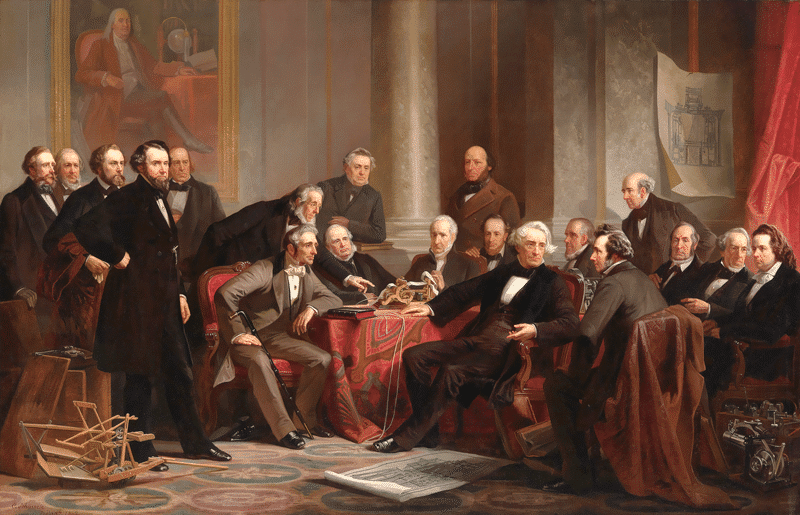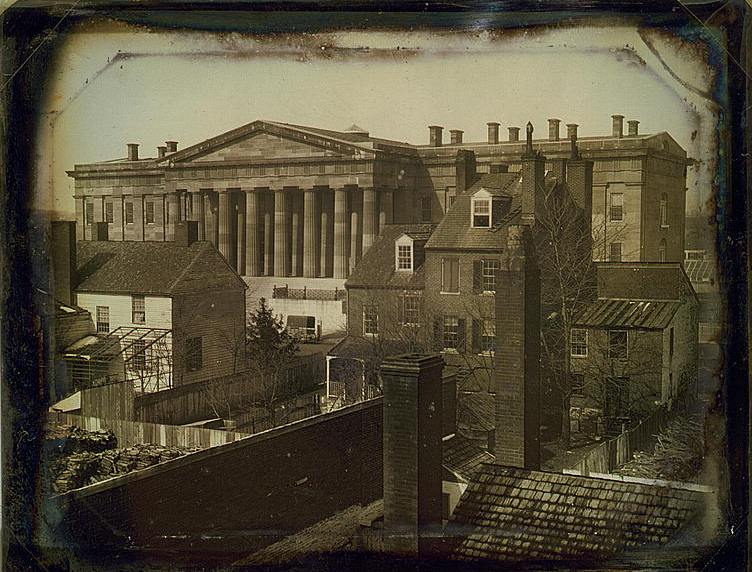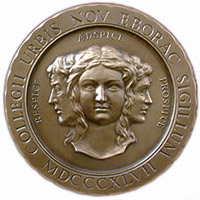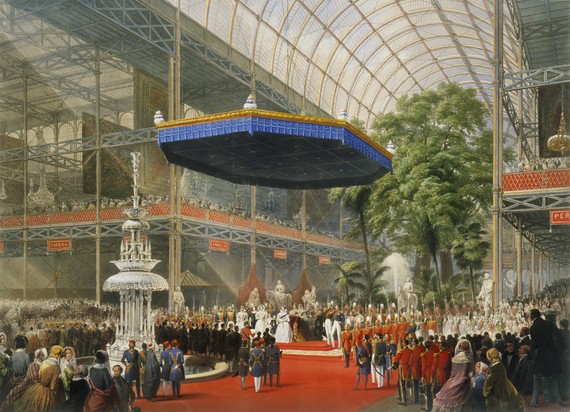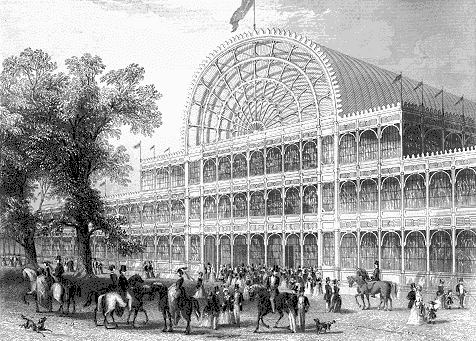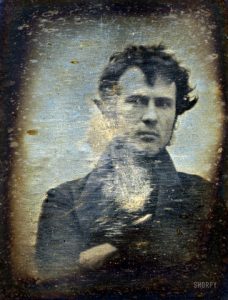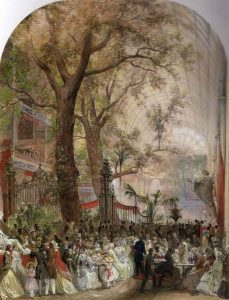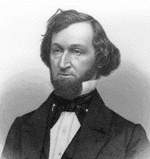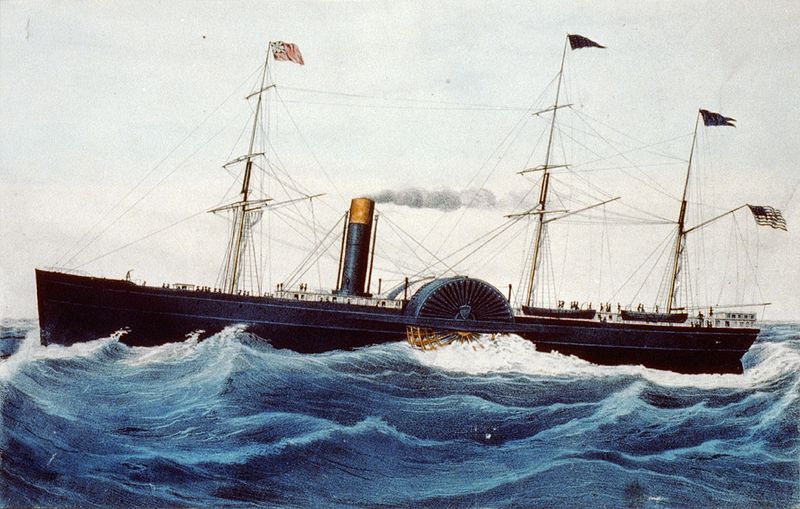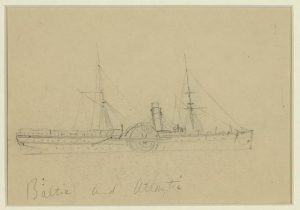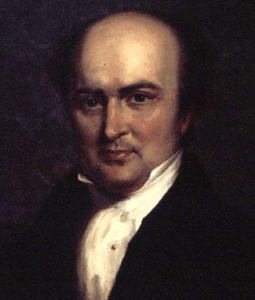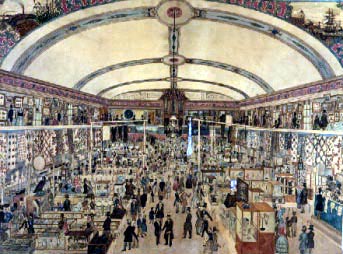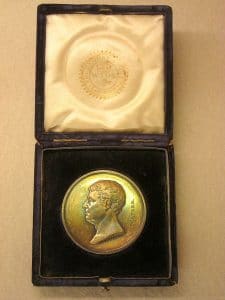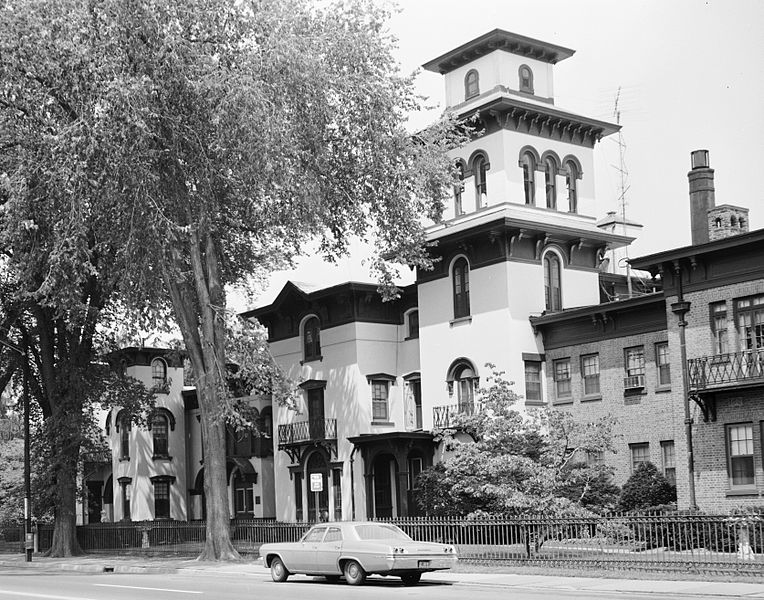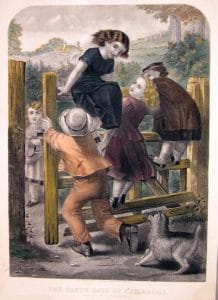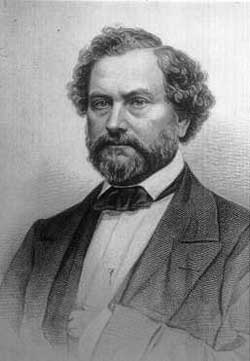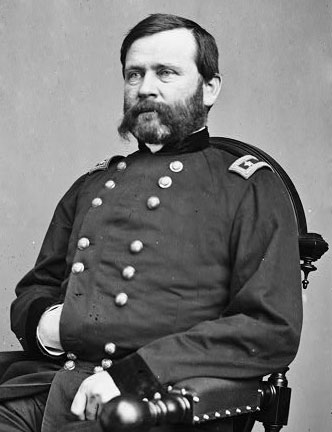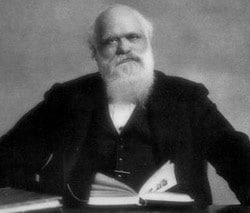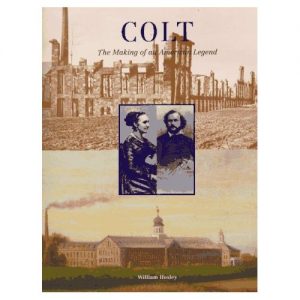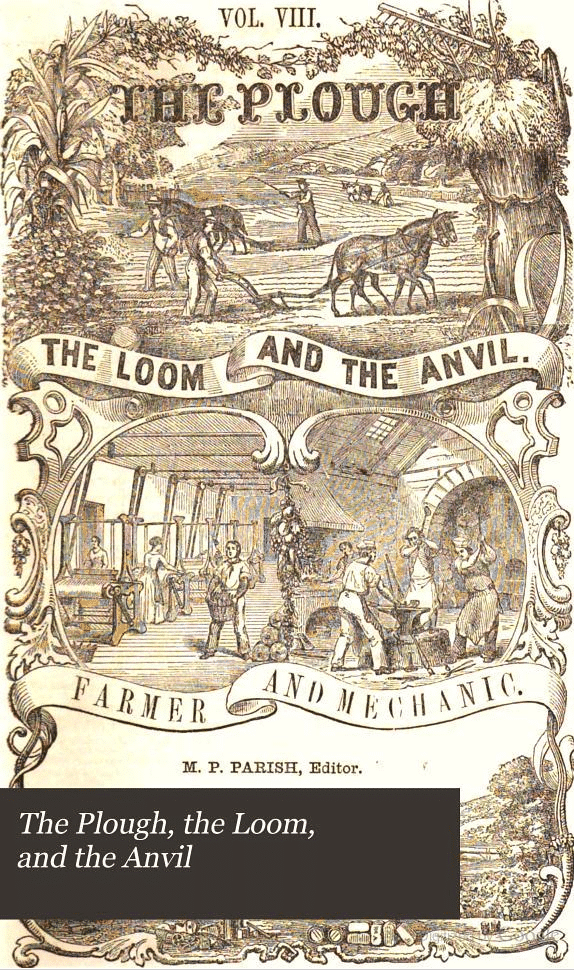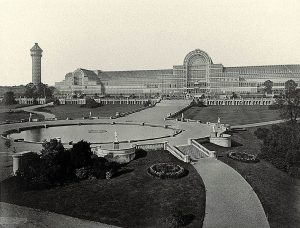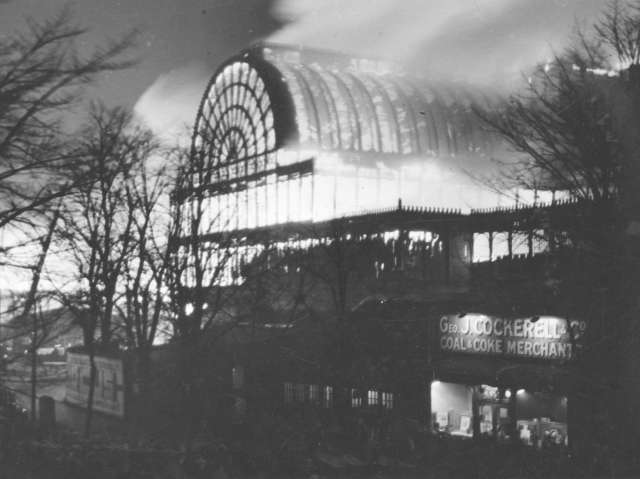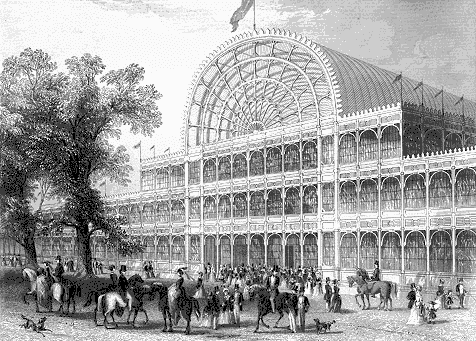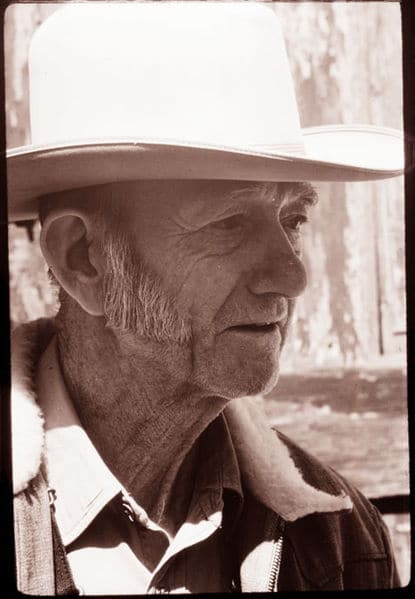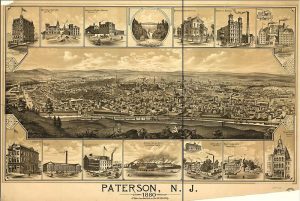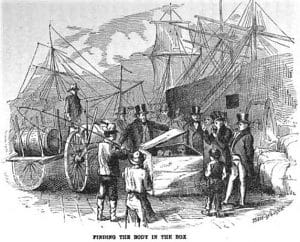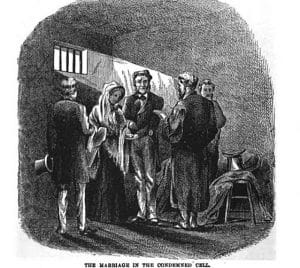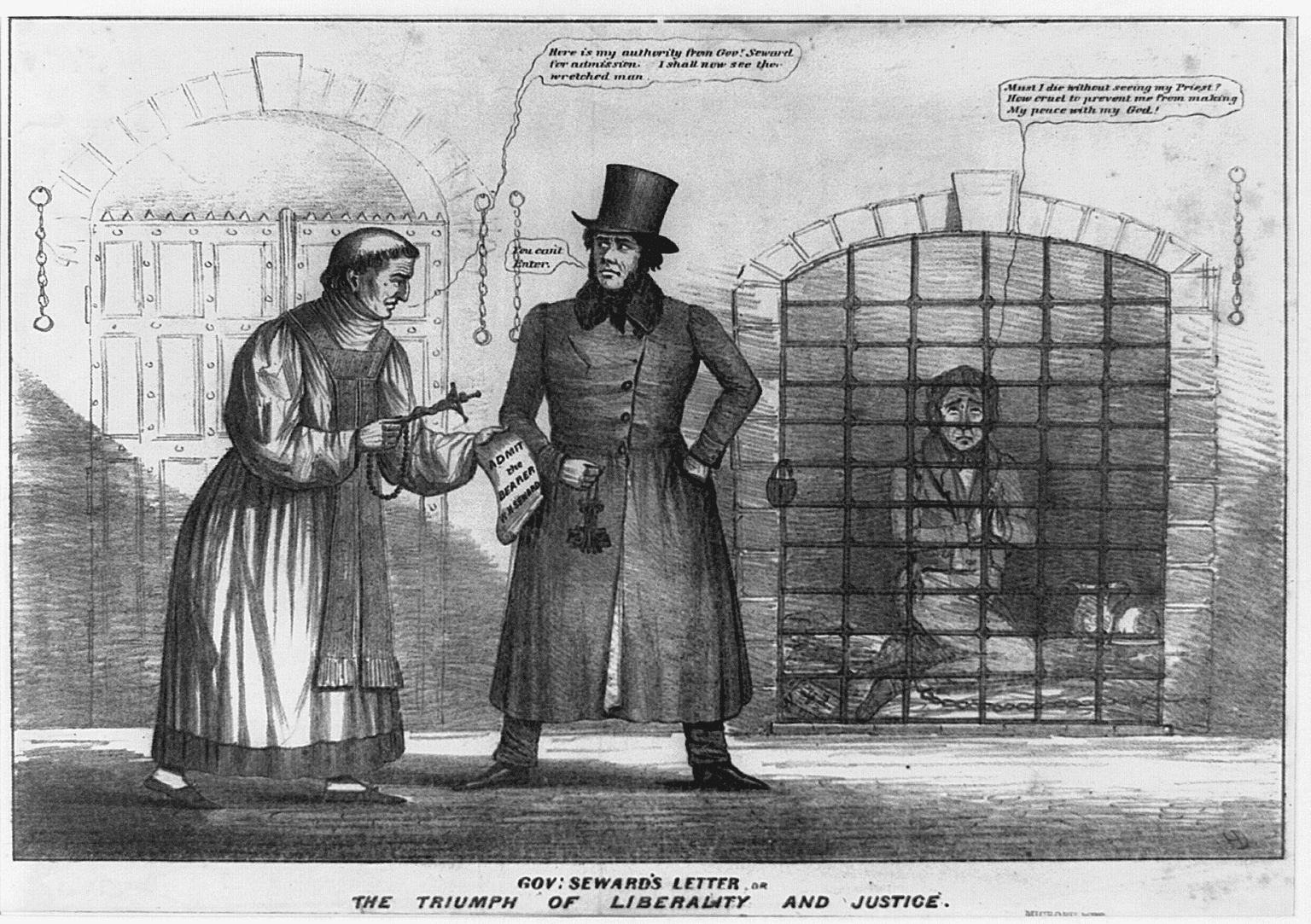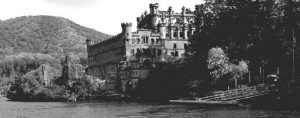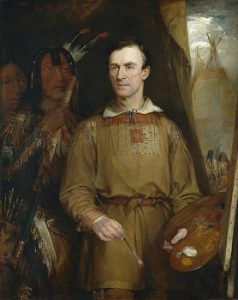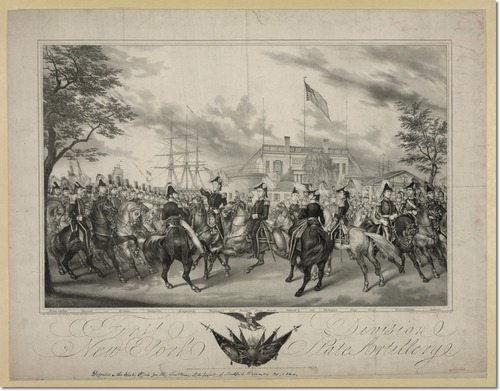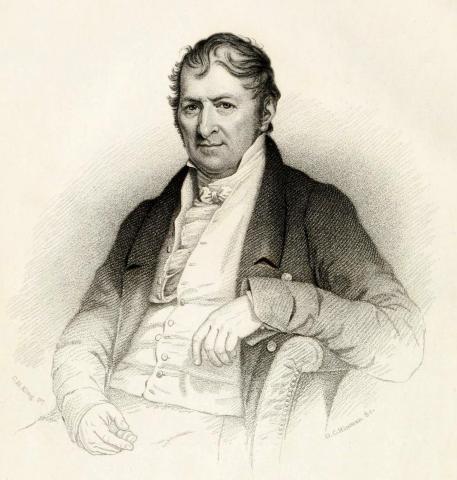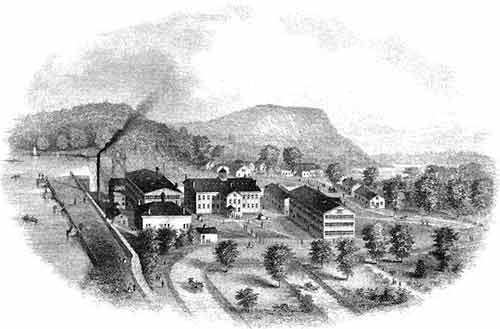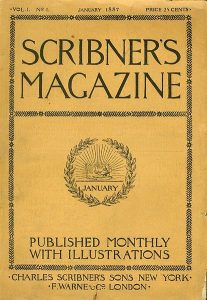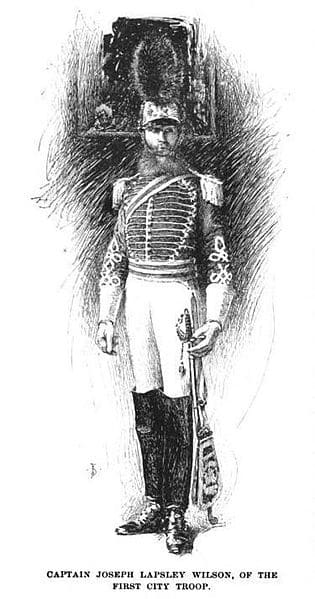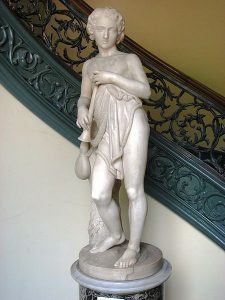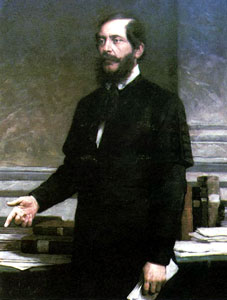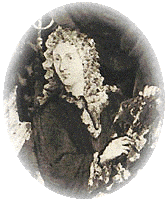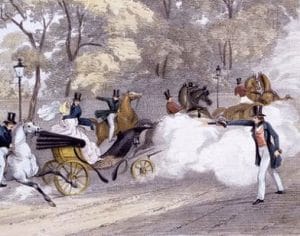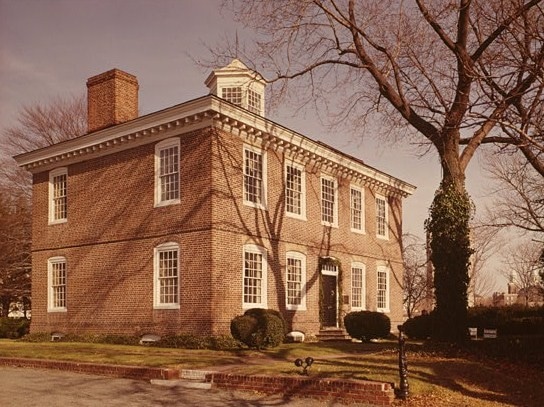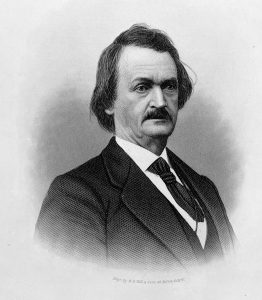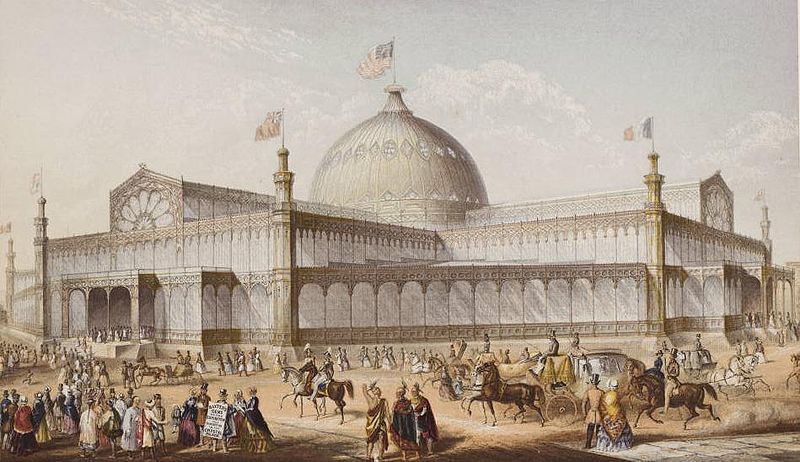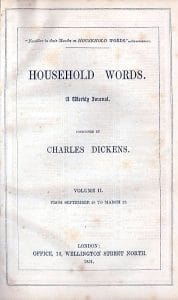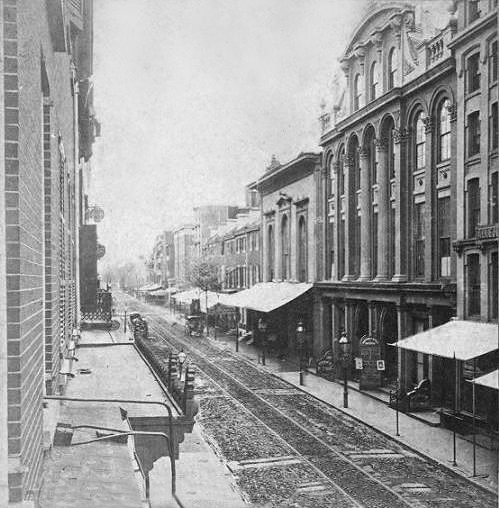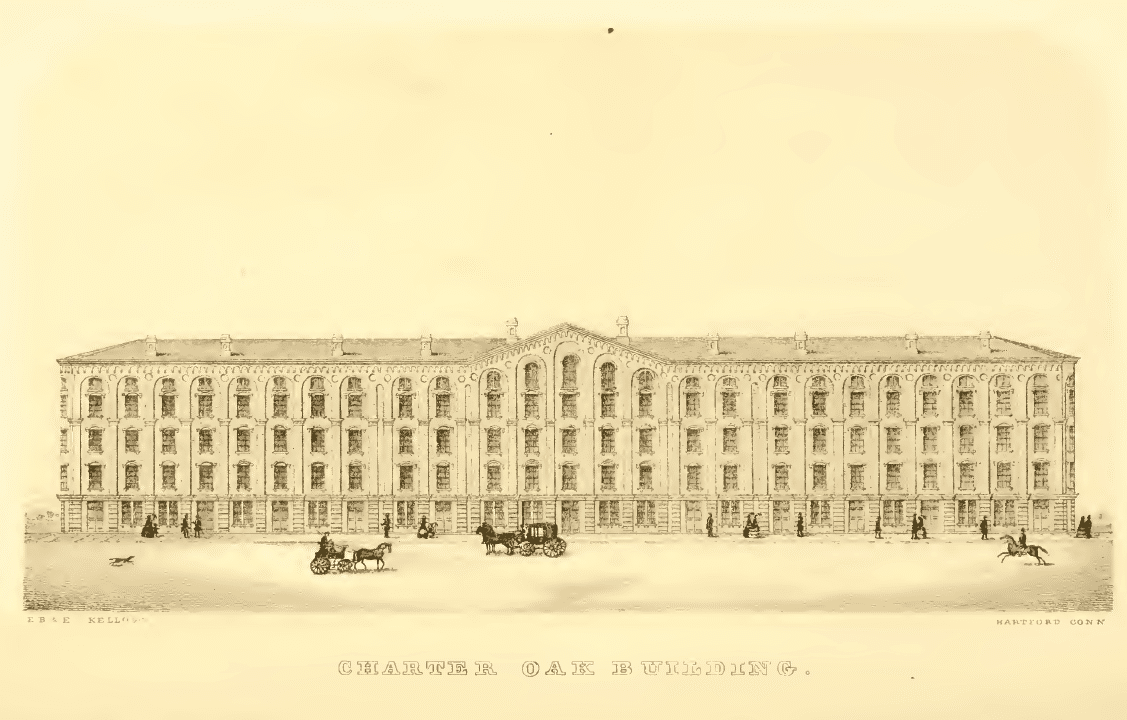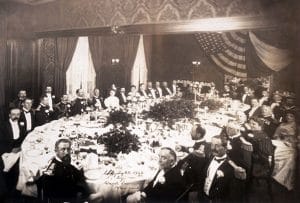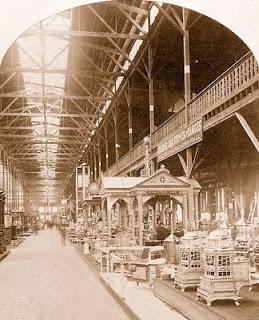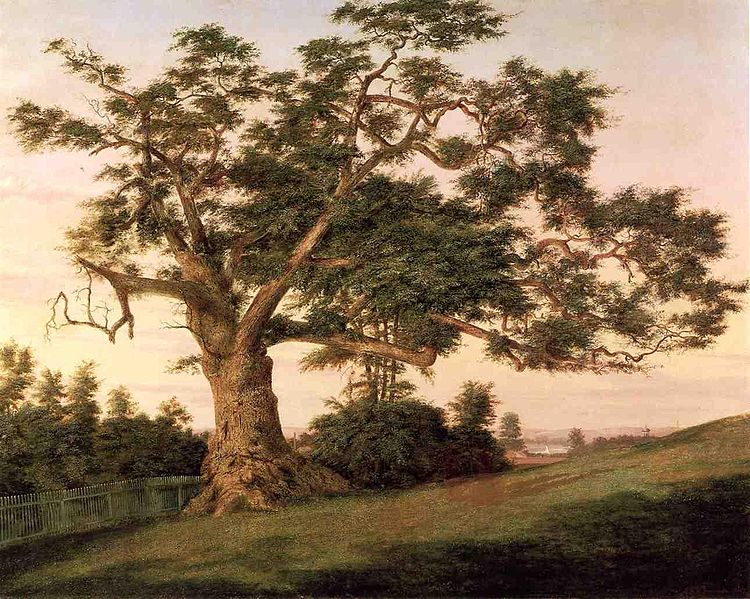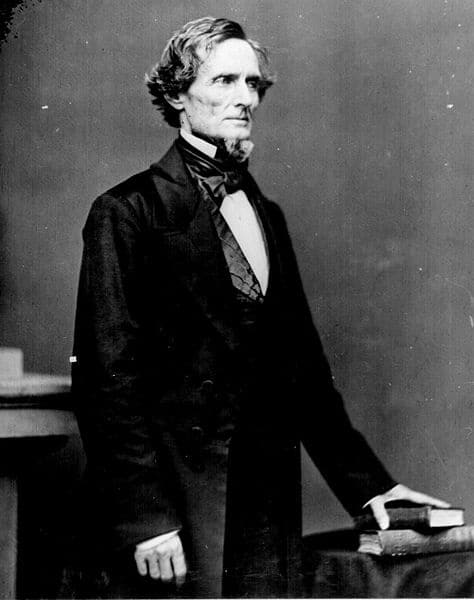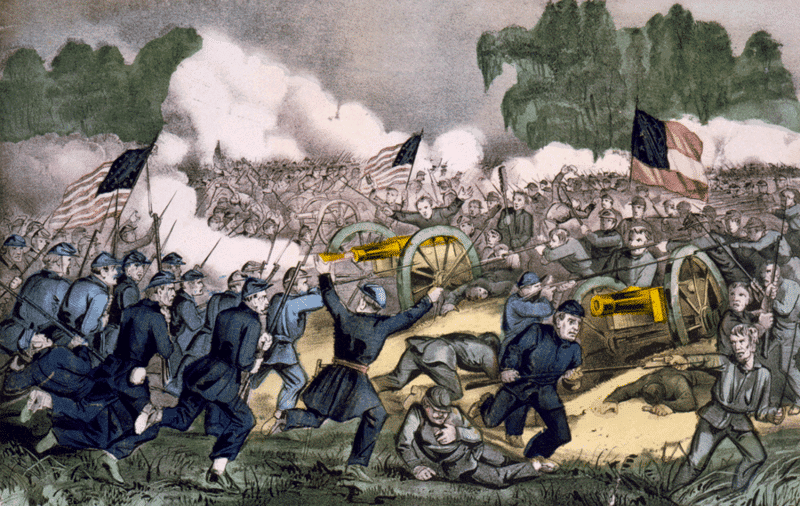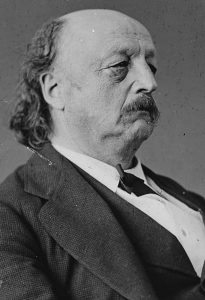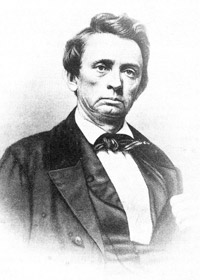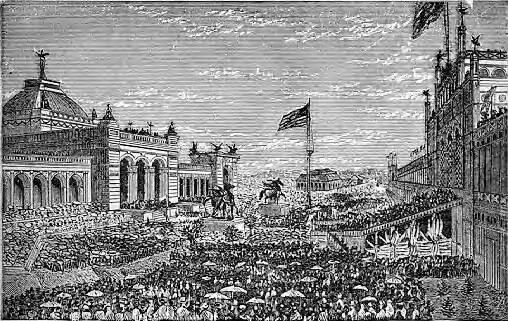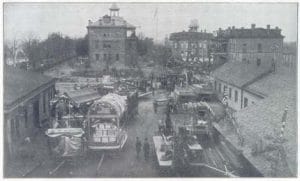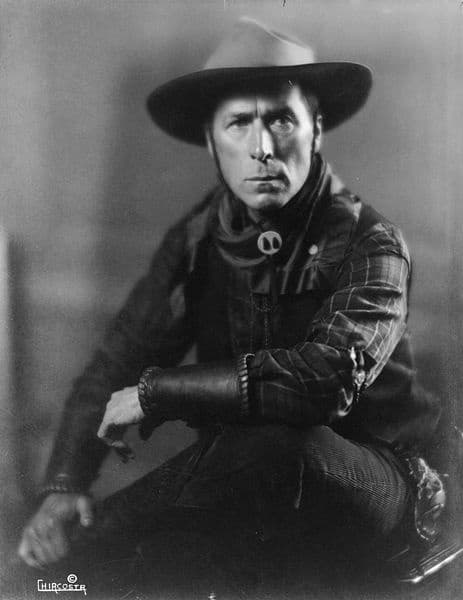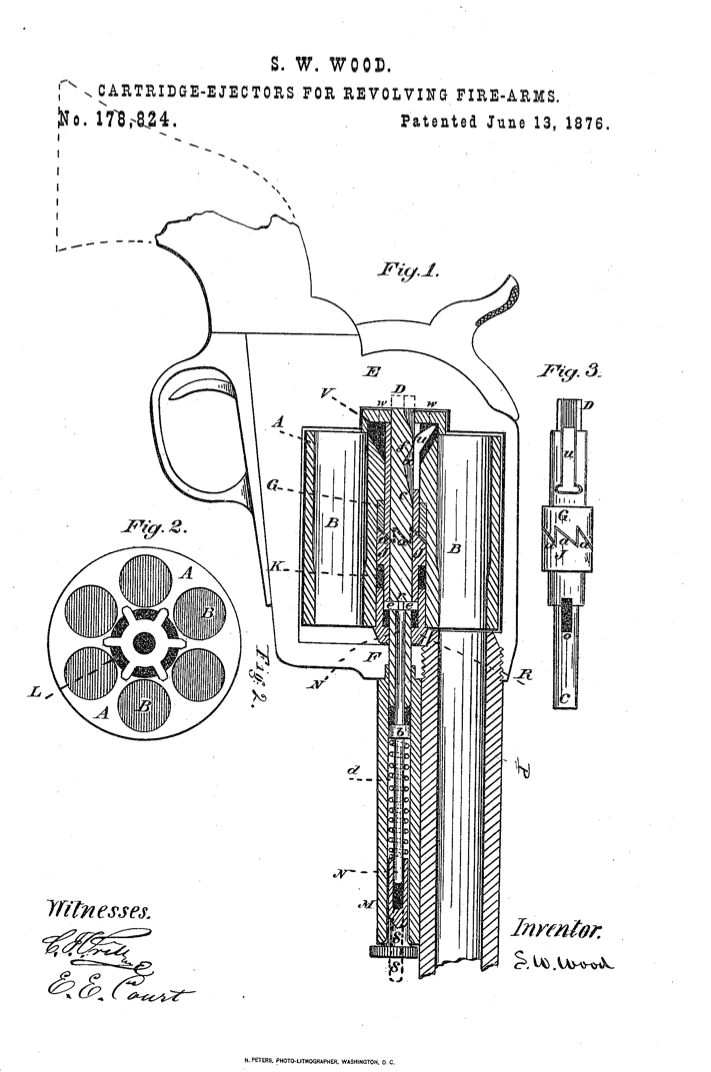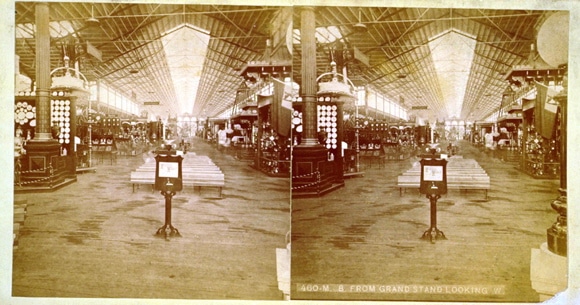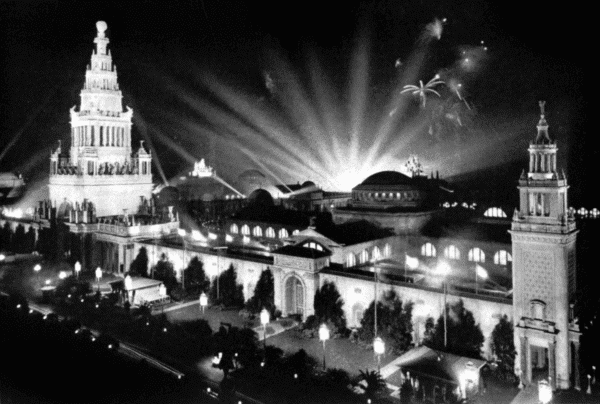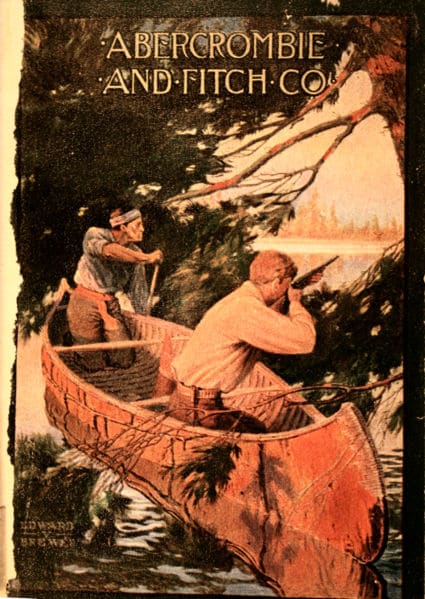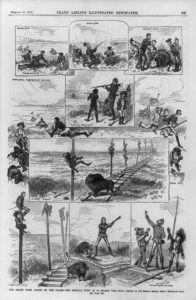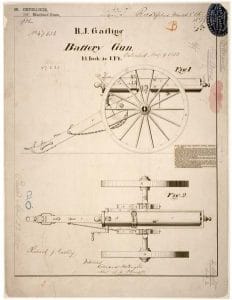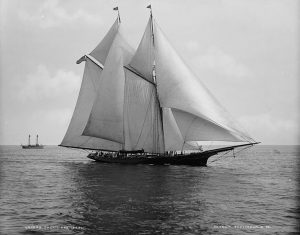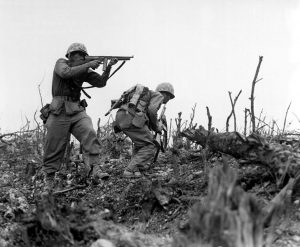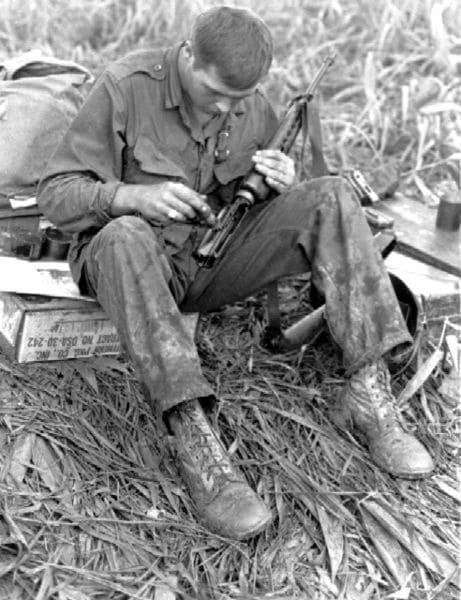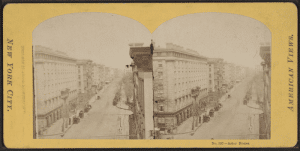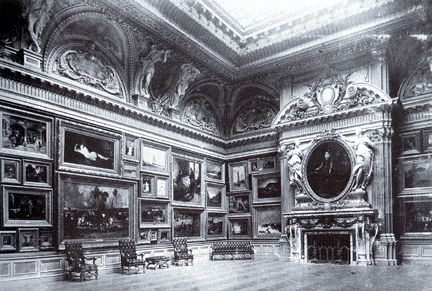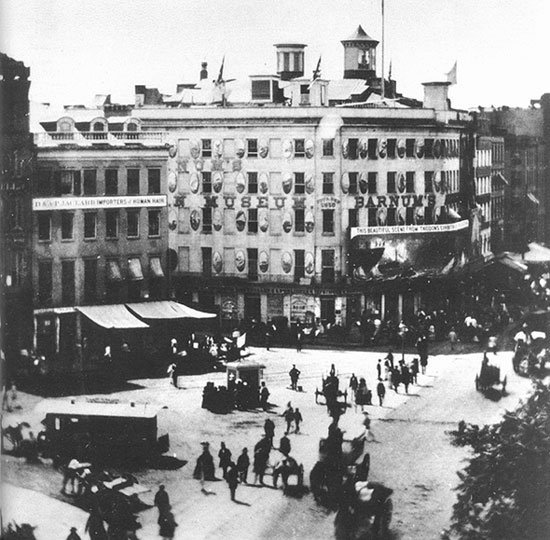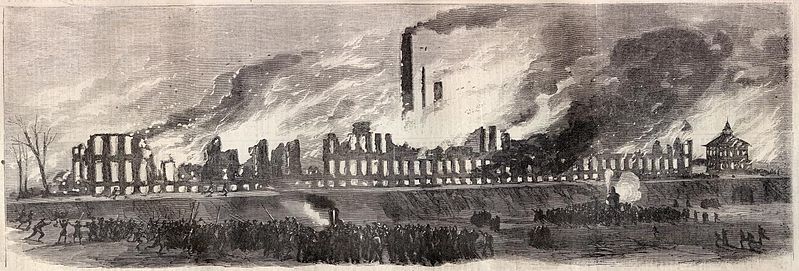PROLOGUE
PP XVI-1
Christian Schussele’s “Men of Progress” Painting
“Men of Progress“ painting on the
Smithsonian Institution’s National Portrait Gallery website.
James Bogardus, Architect
Further information regarding portraits of Samuel Colt: Consult citations to Christian Schussele’s “Men of Progress,” which included Samuel Colt among a number of other prominent inventors and entrepreneurs of the day, appear in this Google Books link to Cast-Iron Architecture in America: The Significance of James Bogardus (1998), by Margot Gayle and Carol Gayle.
Cast-Iron Architecture in America: The Significance of James Bogardus
Cast-Iron Architecture in America: The Significance of James Bogardus
John Sartain, Printmaker
Printmaker for a contemporary engraving of the Christian Schussele (1824-79) “Men of Progress” oil painting was John Sartain (1808-97), patriarch of a distinguished Philadelphia family; see the following link.
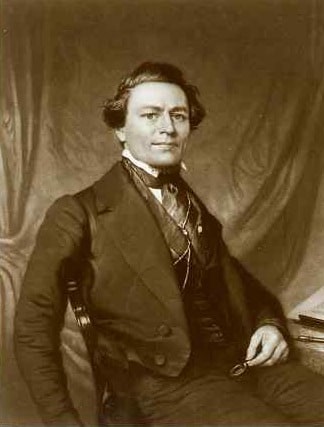
Read More About John Sartain, Printmaker
The Philadelphia Print Shop, Ltd., has produced the above site, with extensive detail on a family identified as “one of the most illustrious and influential families in the history of art in the United States. As artists, printmakers, and educators, the Sartains played a central part in Philadelphia’s and America’s art community.”
Link to reference work with details on the Sartains, Philadelphia’s Cultural Landscape: The Sartain Family Legacy, by Katharine Martinez.
John Skirving: From Bricklayer to Men of Progress
Link to article with details on “Men of Progress” from the Historian for Hire History and Historic Preservation website: “John Skirving: From Bricklayer to Men of Progress.” The article is entitled “Capital Craftsman: John Skirving in Washington,” by David S. Rotenstein, Washington Historical Studies Conference, Washington, D.C., 2 November 2007. A section of the article is entitled “Men of Progress.” Sittings by those in the painting, including Samuel Colt, were expected by Schussele to take place in his Philadelphia studio. To quote Rotenstein: “The painting and engraving reflect an aesthetic that captured the nation’s ideals in an age of factories, railroads, and national markets in which scientists were reinvented as heroes. Art and technology historians hail Men of Progress as a turning point in American art and the depiction of scientific innovation in popular culture.”
Rotenstein also notes that “Schussele finished the Men of Progress painting in 1862. He painted two versions: a larger one sent to Mott [patron for the project] in New York and a smaller one for John Skirving.” Skirving’s “Men of Progress” “briefly [hung] in the White House from 1947 to 1965… [soon thereafter] the painting moved to the Smithsonian’s National Portrait Gallery and it hangs in a first floor gallery in the former Patent Office building.”
John Skirving: From Bricklayer to Men of Progress
PROLOGUE PAGE 2-3
PROLOGUE PAGE 2
Christopher Colt, Father of Samuel Colt
The prominence of Samuel Colt’s father, Christopher Colt, in the development of silk manufacturing in America is cited in The Silk Industry in America: A History Prepared for the Centennial Exposition, by Linus Pierpont Brockett (1876). Details appear in the following link to Google Books.
Prominence of Christopher Colt
Nitrous Oxide, and Samuel Colt
Link through Google Books to a history of dentistry, by James Wynbrandt, in which Samuel Colt, as “Dr. S. Coult of Calcutta, London and New York,” played a role. Reference is made specifically to a Nitrous Oxide public appearance in Portland, Maine, on October 13th 1832. The quoted advertisement also notes: “[Dr. Coult] will attend, on reasonable terms, to any applications for private Exhibitions to select parties of Ladies and Gentlemen…”
Google Books History of Dentistry
The following link, via Google, includes references to Samuel Colt, as well as to a Gardner Quincy Colton, known to have administered Nitrous Oxide/laughing gas, suggesting that Dr. S. Coult also took the role of Gardner Quincy Colton.
Daguerreotype of the U.S. Patent Office, c. 1846
Link to a Library of Congress daguerreotype showing the old U.S. Patent Office, c. 1846, accessed through the WikimediaCommons.org site. This presents a scene well known to Samuel Colt.
Library of Congress Daguerreotype
PROLOGUE PAGE 3
American Institute, New York City
This link is believed to show the American Institute, New York City, a favorite place for exhibitions by Samuel Colt. Look carefully in the foreground for Bowie knives and what appear to be (in the next case, to the upper left): ivory-stocked Derringer pistols. The URL suggests that this is the American Institute.
Image of American Institute, New York City
PROLOGUE PP 3-4, 12
Lawsuit against Mrs. Elizabeth Jarvis Colt
From the New Haven Register, published as the New Haven Evening Register; July 29th 1881; volume XLI; issue no. 176; page: 4; New Haven, Connecticut, a brief article on a lawsuit.
A Millionaire’s Money
Judge Blatchford, of the United States circuit court has just filed his decision in the case of the heirs of James B. and Christopher Colt, children of the brothers of the late Col. Samuel Colt of Hartford against Mrs. Samuel Colt. The suit was to recover moneys alleged to be due them under a codicil in the will of the colonel leaving to his brother’s heirs the use of 500 shares of stock, and providing for a division among them of the income from stock not specifically given to other persons. This codicil owing to a quarrel with his brothers was revoked by the colonel in part, and the suit to recover about $100,000 was brought on the claim that they were entitled to a part, at least, of the money not specially appropriated under the codicil. The judge has decided for the defendant, Mrs. Colt, on all points, his opinion covering 130 pages of legal cap, and the aspiring nephews and nieces are left out in the cold. The Colt estate is valued at some $3,000,000.
PROLOGUE PP 4-5
View of the City of Hartford, Including the Colt Factory
Yet another view of the City of Hartford, this one from the Connecticut River, a lithograph by C.H. Vogt & Co., Milwaukee, published by O.H. Bailey & Co., in 1877. In the left foreground, the Colt factory complex, and Armsmear. From the Connecticut Digital Archive, University of Connecticut.
The University of the City of New York
View of the principal building of what was then known as The University of the City of New York, its appearance c. 1833, a few years before Samuel Colt was residing in that community.
Link provided by the New York University Presents 175 Facts About NYU site.
The University of the City of New York Building
Factories Beside the Park River
Link to Connecticut History Online, of The Connecticut Historical Society, Hartford, to photograph of “Factories Beside the Park River,” a c. 1867 print by Prescott & White, showing various buildings, including “at the right may be part of Sharp’s Rifle Factory.”
Photograph of “Factories Beside the Park River”
PROLOGUE PAGE 5, 12, 23 and EPILOGUE 505 & 531
Obituary of Richard W.H. Jarvis
An obituary of Richard W.H. Jarvis was published in the Hartford Courant, January 22nd 1903. Follow is the link; access to the article is fee-based, from the Hartford Courant website.
Obituary of Richard W.H. Jarvis
PROLOGUE PAGE 6-7
PROLOGUE PAGE 6
Record of Samuel Colt’s Arrival in London
In order to access the original record of Samuel Colt arriving in London via Ostend, January 10th 1852, shortly following the Great Exhibition of 1851, ancestry.com needs to be used. The document is No. 50, “Port of London. Certificate of Arrival.” For the ancestry.com search go to “All Databases” and then search for ALIENS and then go to “Alien Entries to England” covering date of 1850s, and then enter “Colt.”
With his propensity for meeting royalty, and promoting his firearms, and the machines which manufactured them, one could speculate that Colt met the Belgian King Leopold I, who had a vacation residence at Ostend. The uncle of both Queen Victoria and Prince Albert, King Leopold was likely familiar with Samuel Colt and his wares. Since Prince Albert had received the gift of the Colt Dragoon and Navy cased set, King Leopold’s curiosity may well have been suitably aroused.
The Travels of Colonel Colt
From microfilmed passenger and immigration lists, data on Samuel Colt returning to New York, 1850:
Name: Saml Colt
Arrival Date: 16 Jan 1850
Age: 36
Gender: M (Male)
Port of Arrival: New York
Port of Departure: Liverpool
Place of Origin: United States of America
Ship: Canada
Family Identification: 3087497
[Source data: Microfilm Serial Number: M237; Microfilm Roll Number: 86.]
Colt at the Great Exhibition of 1851, London
Colt goes to Belgium, perhaps other areas of the Continent, late in 1851. Before departing to Ostend, Colt attended a dinner at the Albion Hotel, Piccadilly, at the corner of Oldham Street, Manchester, in Northern England. Demolished in 1928, photographs are presented in the link as follows.
Piccadilly Gardens & Pavilion, Manchester
Colt returned to London from Ostend, January 10th, 1852. Then Colt returned to New York City from London, February, 1852 (that means he spent very little time in London between Jan 10th and when he had to set sail). Then almost certainly Colt headed to Hartford. Colt again stayed at the Astor House, New York City, from June 18th, 1852 and for some time. This can be closely surmised from the guest registry.
Presentation Colt Revolver, The Artist Hiram Powers
An example of one of many reasons for Colt to present a revolver, the following letter from sculptor Hiram Powers, not only thanks the Colonel for a welcome gift, but talks about old times:
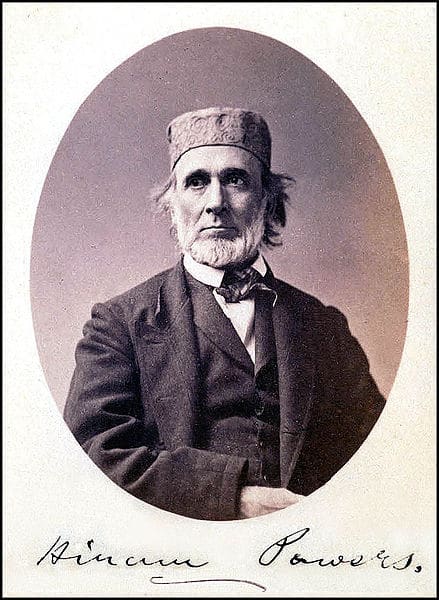
Florence, Sept. 10, 1851.
My Dear Friend Colt – I have at last got possession of the wonderful “revolver,” which you have been so very kind as to send me.
And now let me thank you for this token of your kind remembrance. Our experience has been somewhat similar. Both of us have had some tough times in our day, have passed through a variety of trying processes upward to some distinction. But you have found pecuniary reward the soonest, and well have you merited it, and as well, the high reputation you now enjoy.
I shall never forget the gas the old Museum (in Cincinnati), nor your sly glances at the ropes stretched around the columns, when about to snatch the gas-bag away from the huge blacksmith who glowered at you so threateningly while his steam was getting up, nor, a moment after, his grab at your coat-tail, when you, frog-like, leaped between the ropes.
I remember your telling me in Washington, that at that very time you were elaborating in your mind the great invention you have since given to the world. But little did I then dream that in 1851 I should be in Italy, a sculptor, and fully employed. I had hopes of better things for the future, but they were faint indeed.
I have not forgotten my old mechanical pursuits, [he alludes to various contrivances in Cincinnati, the chief of which, styled the Infernal Regions, horrified thousands of visitors at the Museum,] and I have a shop even here, – a turning-lathe, forge, &c., and I spend much of my leisure time in this way. I have invented several improvements in working marble and plaster of Paris. One of them you shall see one of these days, for it embraces much of your own art. It could not fail to be very useful even to you. It is not yet complete, but will be in a few months.
Jonathan is indeed taking a stand among the nations of the ‘arth. If his show at the Great Exhibition is meagre, he nevertheless beats all creation in his threshing-machines, his steamers, and yachts. John Bull don’t like this from his rebellious son, but he chuckles at his being HIS son, after all.
Wishing you increased success in all your undertakings,
I am, my dear friend,
Ever most sincerely yours,
HIRAM POWERS
Note: The Colt revolver presented to Powers has yet to surface; it is likely to have been a squareback triggerguard Model 1851 Navy, or perhaps a Model 1848 Baby Dragoon Pocket revolver, in either instance, a cased set.
Following Powers’ letter, the book Armsmear (pp. 154-156) wrote of a collaboration between Colt and Powers, in Cincinnati:
“It is by no means incredible that it was in some exhibition got up by Messrs. Powers and Coult, that when an accidental explosion of chemicals blew up the spectators as if a torpedo had ignited under them, a sailor, who had been amazed at a good many of their previous tricks, thought this catastrophe also only a part of the show, and when he began to recover his senses, cried out, with an oath, to a comrade, “I wonder, Jack, what in the world they’ll do next!”
His lecturing purposes once accomplished, Samuel Colt emerged from his incognito and itinerant shows as eagerly as from purgatory. The same year he crossed the Atlantic in quest of European fire-arms patents, and the very next year obtained one in Washington; henceforth soaring cloudward, but not scorning the base degrees by which he did ascend.”
PROLOGUE PAGE 7
Great Exhibition of 1851, London Slideshow
Background data on the Great Exhibition of 1851, London, in a slide show.
Slideshow on Great Exhibition of 1851, London
Panorama of the Great Exhibition of All Nations, 1851
Link to the Library Catalogue, Smithsonian Institution Libraries, Smithsonian Institution Research Information System (SIRIS), for the “Illustrated London News grand panorama of the Great Exhibition of All Nations, 1851.” The scroll so described is presently held at the Cooper-Hewitt Museum, New York, a division of the Smithsonian Institution.
To quote a general description of the scroll: “A work in the form of a scroll, featuring a panoramic display of engraved scenes from the Great Exhibition of 1851 arranged in double (upper and lower) rows. The engravings are printed on paper sheets mounted on a continuous piece of cloth that is wrapped around a wooden spindle. Published as a souvenir edition, with engraved illustrations reprinted from the Illustrated London News. The scroll begins with three diagrams showing the fluctuations in the number of visitors to the exhibition on various days of the week, with reference to the cost of tickets, the weather, and the temperature inside the exhibition galleries. This section with the diagrams is signed: “Drawn by Lance Corp[ora]l J. Mack, Royal Sappers and Miners; Day & Son, lith[ographe]rs to the Queen.”
The printed captions running below the engravings briefly describe the objects displayed in the Crystal Palace and give the names of the principal manufacturers featured in each section of the exhibition..”
Robert Cornelius Self Portrait
An exhibitor near the Colt display at the Great Exhibition of 1851 was that of the Cornelius Lamp Co., Philadelphia, Pennsylvania. Robert Cornelius of that company was present at the Great Exhibition, and was himself a daguerreotype photographer. To view a self portrait of him, taken c. 1839, check the following link.
Robert Cornelius Daguerreotype
It is speculated that Cornelius took daguerreotypes at the Great Exhibition. If so, it is possible that among his subjects was Colonel Samuel Colt, perhaps at the inventor’s exhibition stand.
On the reverse of Cornelius’ self-portrait is inscribed: “The first light-picture ever taken. 1839.” The quarter-plate daguerreotype may be “the earliest photographic portrait of a person” (quoting from the website).
United States Section at the Great Exhibition of 1851, London
Link via Google to a black and white print showing the United States section at the Great Exhibition of 1851, London. From the collections of Stanford, note American eagle and flags at top center, with “UNITED STATES” on the balcony beneath. Samuel Colt’s display is to the left of the Greek Slave sculpture by Hiram Powers, somewhat in the background.
Print Showing the US Section at Great Exhibition of London
The U.S. Section of the Great Exhibition of 1851
Link via Google to a colored view of the United States section of the Great Exhibition of 1851. In this image, Colonel Colt’s display is to the left, somewhat in the background, with two persons standing in front, while the “Greek Slave” is positioned at right center. Cornelius lamps of Philadelphia is position to the right side, with hanging examples.
Colored Image of the U.S. Section of the Great Exhibition
American Daguerreotypes
Colored image from Marcy J. Dinius, “Best in Show American Daguerreotypes at the Great Exhibition,” on www.common-place.org, volume 9, no. 4, July 2009.
Season Ticket to the Great Exhibition of 1851
Link via Google for image of a season ticket to the Great Exhibition of 1851. From the British organization, The Institution of Engineering and Technology, The Knowledge Network, and appearing in an illustration to accompany narrative entitled “Great Exhibition 1851”
Elegant Patrons at Great Exhibition of 1851 Refreshment Area
Link to work of art portraying elegant patrons at a refreshment area at the Great Exhibition of 1851.
Art Portraying Elegant Patrons
Reports by Juries and Commissioners
Link from Google Books listing reports by the juries and commissioners for the Great Exhibition of 1851, including reference to Samuel Colt, among those from the firearms industry who received medals.
Reports by Juries and Commissioners
American Participation in the Great Exhibition of 1851
Link via Google Books to American Participation in the Great Exhibition of 1851, monograph by Robert F. Dalzell (Amherst College Press, 1960). A brief mention only is made of Samuel Colt.
American Participation in the Great Exhibition of 1851
Overview of American Exhibits at the Great Exhibition of 1851, London
Link to Getty Images, with period colored print showing overview of a portion of the American exhibits at the Great Exhibition of 1851, London.
Print of American Exhibits at the Great Exhibition of 1851, London
Period Print of The Industrial Exhibition, London, 1851
Link to Getty Images, with period print showing “The Industrial Exhibition, London, 1851.”
Elevation and Plan of Crystal Palace
Getty Images link to “Elevation and plan of Crystal Palace in Hyde Park, London, 9 November 1850.”
Link to Images of Crystal Palace
Caption Photo of the Great Exhibition
Getty Images link to photograph of the “Great Exhibition” captioned: “1851: Exhibits in the eastern nave of the 1851 Great Exhibition at Crystal Palace, London (Photo by Hulton Archive/Getty Images).”
Impressed by Light
Important photograph which has in its background a sign which references Colt’s Patent firearms, exhibited nearby, at the Great Exhibition of 1851. Note the word “PATENT” from Impressed by Light British Photographs from Paper Negatives, 1840-1860, page 36. The lamps in the image from Cornelius & Co., of Philadelphia. The image a promised gift to the Art Gallery of Ontario, Toronto, from Archive of Modern Conflict, London.
Important Photograph from Impressed by Light
The following link presents an overview of the source book, Impressed by Light, though it does not include the image from page 36.
Overview of Sourcebook Impressed by Light
Image of a Royal Engineer with Colt Navy Revolver
The following link presents an interesting article, which includes the image of a Royal Engineer, with his Colt Navy revolver. During the Great Exhibition of 1851, as reported in the Times of London, a trial had been held on Wednesday, September 10th, by “A Board of Ordnance committee comprised of several dignitaries,” among them: “Mr. Samuel Colt, of revolver celebrity.” They were to “witness experiments with Mr. Colt’s and Mr. Adams’ revolvers.” At that occasion, Lieutenant Thomas Ray “in charge of the Company of Royal Sappers & Miners,” was presented by Colt “with one of his revolving pistols.”
Article with Royal Engineer with Colt Navy
Further data relevant to the above is presented in the following link, to the National Army Museum, London, owner of the Lieutenant Thomas Ray image.
Further Data on Lieutenant Thomas Ray
Gilman’s Saloon in Hartford
Link from Google regarding Gilman’s Saloon, in Hartford, with reference to Colonel Samuel Colt, “Aide de Camp,” the Governor’s Horse Guards, and other relevant Colt and Hartford history.
Google Book on Gilman’s Saloon
Thomas Henry Seymour’s Home in Hartford
Link from the University of Connecticut, University Libraries Digital Mosaic, illustrating photograph of Thomas Henry Seymour’s home, Hartford. Seymour’s commission of Samuel Colt as a colonel, his help with Colt’s travels in Russia, and other associations were instrumental in Colt’s successful enterprises.
Thomas Henry Seymour’s Home in Hartford
Series of Photographs of the Parker Lyon Pony Express Museum
Link to the University of California site, Calisphere, access to a series of photographs of the Parker Lyon Pony Express Museum, Pasadena, later purchased by William Harrah, and moved to his own private museum site, in Sparks, NV. Lyon had an extensive arms collection. From the Arcadia Public Library collection.
Parker Lyon Pony Express Museum, Pasadena
Philip Graff, Berlin, Photographer
See these notable links from Google Books about Graff. Note that Graff died in May of 1851 and his widow continued the business.
Philipp Graff, Berlin Daguerreotypist
Google Search; ‘philipp graf berlin daguerreotype’
PROLOGUE PAGE 8-9
PROLOGUE PAGE 8
Research Notes on Captain Joseph Jesse Comstock
Based largely on research in the Rhode Island Historical Society Library, some notes are presented herewith on Captain Joseph Jesse Comstock (1811-1868). The experienced sailor was a friend of Colonel Colt, and captain of the steamship Baltic, on which Colonel and Mrs. Colt and party sailed on the couple’s honeymoon voyage, departing June 7th 1856. Comstock was recipient of a presentation engraved and inscribed Model 1849 Pocket revolver. The 6-inch barrel artifact is pictured in color in The Colt Engraving Book, Volume I, page 91. Captain Comstock also received an elaborately engraved Model 1851 Navy revolver, the barrel lug of which had a depiction of what is considered to have been the Baltic. The Navy revolver is inscribed handsomely on the back strap to Comstock from the inventor.
At sea with the merchant service, Comstock visited the East Indies (by way of Cape Horn), c. 1832. His travels included from the Northwest U.S., to Canton, China. His return to the U.S. was in 1832. Had he met Samuel Colt, himself a young seaman, during that period.
Comstock had also commanded the steamer the Massachusetts, c. 1836 through 1845, plying waters from New York up to New England. He was an expert on the Eastern Coast of the United States.
In 1845 Comstock became manager of the New York Hotel.
Soon Comstock was in charge of the Bay State, a new steamer, built with his guidance. His trips would be in Long Island Sound and the North River. He was placed in charge of the fleet. Another steamer built with Comstock’s supervision was the Empire State. That ship soon burned to the water’s edge.
Soon Messrs. Howland & Aspinwall “being actively engaged in getting up a line of Pacific Ocean Steamers to ply between Panama and San Francisco, solicited Captain Comstock to take one of them, the Panama, round Cape Horn or through the Straits of Magellan, and leave her at her port of destination in the Pacific…”
The Atlas newspaper article, on the front page, New York, September 16th 1849, notes that “Captain Joseph J. Comstock is now in the very prime and pride of life and manhood. Those who cast their eyes on his portrait, if they be versed in that science, which Pope so graphically delineated, when he wrote that beautiful line of his, which teaches us that ‘The noblest study of mankind is man,’ will at once read in him all the nobler characters of the sailor, the navigator, and the man. If, like Tom Tough…'[he] ——- has seen a little service,’ he is, in private life, as universally admired as he is in his official capacity…Alike in the hour of peril and of safety, he is the firm and undaunted commander.”
A letter in the Rhode Island Historical Society Library’s Comstock files, dated September 30th 1851, New York, was addressed to J.J. Comstock, Esq., Captain of Steamer Baltic: “The New York Yacht Club gives to Comr Stevens – & Messrs L.A. Stevens & Jos. A. [?] a [?] dinner at the Astor House on Wednesday Oct 1 at 5 ½ oclock – & …that we…request the favor of yr company…”
The letter was signed by four individuals, including an A. Foster and Wm. Edgar. Perhaps this has to do with the Stevens victory with the yacht “America,” against the British, during the Great Exhibition of 1851. Commodore Stevens and William Edgar were founding members of the New York Yacht Club.
A lengthy obituary, headlined “Capt. William Comstock,” in an undated and unidentified newspaper, gives the story of Joseph J. Comstock’s father, born in Providence, and son of businessman and shipbuilder Benjamin Comstock. At fifteen years of the age, Captain William Comstock was at sea, a family tradition.
Captain Joseph J. Comstock had a distinguished service during the Civil War, assisting the Union on steamship and nautical matters. Among his achievements was evacuating Major Robert Anderson from Fort Sumter, aboard the Baltic. Also in the Rhode Island Historical Society Library, is an undated article in the New York Sun, (c. 1892) stated that Comstock “enlisted on Aug. 10, 1861, in the New York Seventh Regiment: reenlisted and appointed to Second Lieutenant, Third Rhode Island Heavy Artillery, in September 1861; was appointed Adjutant and First Lieutenant in October, 1861; in 1862 was promoted to Captain; in 1863 was promoted Major in the Fourteenth Rhode Island Heavy Artillery. He was severely injured in the line of duty in 1862, and it was at one time reported that he had been killed. He suffers to-day from the effect of said injuries.” Per the New York Sun article, as of December 22nd 1892, Major Comstock was at the Post-Graduate Hospital, New York.
Excerpts from the Journal of Captain Comstock on the Baltic, including the elegant front cover, are as follows. Studying the Journal makes it clear that sailing on the Baltic provided Samuel Colt with many opportunities to network, and to promote his rapidly evolving firearms business.
Captain Joseph J. Comstock Evacuates Fort Sumter
Comstock evacuated Robert Anderson, commander of Fort Sumter, Charleston SC, aboard the Baltic, and that ship herself was a reliable Civil War vessel herself. The Baltic at one time was under control of the Ruger Bros. shipping line (great uncles of William B. Ruger, Sr., who cofounded gunmaker Sturm, Ruger & Co., in 1949).
Steamship Panel Motifs
See The Colt Engraving Book, volume I, page 116, for engraved Model 1851 Navy revolver, serial no. 30520, with a sidewheeler steamship panel motif on the right side of the barrel lug. A later discovery, serial no. 28470/. Model 1851 Navy, in Fine Colts The Dr. Joseph A. Murphy Collection, page 76, has a sidewheeler steamship panel motif engraved on the right side of its barrel lug. In the latter instance, the ship is likely to have been the U.S.M. Steamer Atlantic, since the ship’s captain, James West, was recipient of the presentation Navy (with a Pocket Model 1849 revolver no. 84624/.), both cased together. For the West set, see pages 74-81 of Fine Colts.
History of the Steamship Baltic
Link to Wikipedia, The Free Encyclopedia, for a capsule history of the Steamship Baltic.
History of the Steamship Baltic
Link for further data on the Steamship Baltic
Color Print of Steamship Baltic
From the George Glazer Gallery, New York City, a link to a handsome color print, showing the steamship Baltic at sea.
Yet another view of the Baltic, from a link to The Library of Congress Prints & Photographs Reading Room.
The Baltic in Civil War Service
Two links to the Department of the Navy, Naval Historical Center home page, showing the Baltic in Civil War service.
Diary Entries Regarding the Baltic
Yet another link to the Department of the Navy, this too the Navy Department Library, showing diary entries mentioning the Baltic, in 1852. To access, open the page, then using EDIT then FIND ON THIS PAGE, use Baltic to search for that word on the page. One entry mentions General Cossuth and Baltic and the Water Witch, a vessel involved in an incident in Paraguay which caused a stir.
Captain Joseph Jesse Comstock
For reference data and further information on Captain Joseph Comstock, the following link to the Rhode Island Historical Society will be helpful. Coauthor Wilson visited the Society and found the material there informative, with the staff most cooperative and enlightening.
Further Data on Captain Joseph Comstock
Edward Knight Collins
For data on Edward Knight Collins (1802-1878), American shipping magnate, who owned the Baltic, a favorite vessel of Colonel Samuel Colt, consult Wikipedia The Free Encyclopedia, and search for “Edward Knight Collins.” Besides a biography, a daguerreotype portrait is illustrated. Not only did Samuel Colt became a close friend and associate of Captain Joseph Jesse Comstock, commander of Collins’ steamship the Baltic, but it is likely that Colt was acquainted with Collins, an entrepreneur in his own right.
Depictions of the Baltic Steamship
Depictions of the Baltic steamship, from the Library of Congress Prints & Photographs Online Catalog.
Depictions of the Baltic Steamship
Majestic Plans at the New Hartford Armory Complex
Of the numerous books published on Colonel Samuel Colt, on the company, and on its firearms, one that is particularly fruitful in detailed citations is William Hosley’s, Colt The Making of an American Legend, 1997, published by the University of Massachusetts Press, Amherst, in association with the Wadsworth Atheneum (1997). However, the majority of these citations deal with the period of the lives of Colonel and Mrs. Elizabeth Hart Jarvis Colt, and thus have relatively little beyond the date of her death, in 1905.
Colt The Making of an American Legend
Quoted from p. 97 of Hosley’s Colt The Making of an American Legend, “Colt was an opportunist in the best sense of the word. His vision was irrepressible, and in the end, Colt came as close as anyone of his generation to inventing the modern industrial system and acting out the dramatic issues of his age.”
The California Rangers
For further information relating to the image on page 8 of the California Rangers who were involved in killing the Gold Rush outlaw, Joaquin Murietta, see the following daguerreotype of three California Rangers credited with leading the armed men who ended the outlaw career of Joaquin Murietta. His head ending up in a jar, widely displayed, and believed ultimately lost in the great earthquake and fire, San Francisco, April 1906. From the Nelson-Atkins Museum of Art (Kansas City MO) site. Use key words search: “California Rangers.”
Obituary of Jarvis Family
A brief obituary notice of Mrs. Colt’s mother appeared in the Philadelphia Inquirer, June 20th 1881; volume CIV; page 1.
…Elizabeth HART, daughter of Major William HART, of this town, who afterward became the wife of Rev. William JARVIS, a nephew of Bishop JARVIS.
This estimable lady was born in Saybrook in 1798, and was descended from a long line of honored ancestry. She was the child of Christian parents, and grew into womanhood greatly beloved by a large circle of acquaintances and friends. After her marriage she entered heartily into all her husband’s plans, and proved a valuable assistant to him in his pastoral work. Hers was not a life exempt from sorrow and suffering; but by Divine grace, each trial and each pain brought with it a deeper faith, a firmer hope, a stronger love, and thus an increase in holiness. With a cheerfulness which scarce showed the patience that was its source, with a deep affection for kindred, on whom in declining years, she leaned with implicit trust, with increasing kindness toward all her many friends, with unshaken faith in God, she lived among those who felt her presence to be a sacred benediction. She died on Saturday, June 18th 1881.
“The gentleness and purity
Through her long life displayed,
In living, loving memory
Can never, never fade.”
“The Revolver Widow”
News Item Regarding Mrs. Samuel Colt:
Not only was Samuel Colt the subject of innumerable contemporary press articles, but Mrs. Colt herself was often written about, alluded to on at least one occasion as “The Revolver Widow.” The majority of these appeared following her husband’s death, as she emerged as the grand dame of Connecticut. Follows are a few of the citations, some rather serious, some whimsical. Internet access to these articles from Readex Historical Newspapers (a division of NewsBank).
Mrs. Samuel Colt and the Shah of Persia
From the Cincinnati Daily Enquirer, published as the Cincinnati Enquirer; March 23rd 1874; volume XXXII; issue no. 81; page 2; Cincinnati, Ohio. A brief reference as follows:
THE Shah of Persia wants Mrs. Samuel Colt to come over there and start a revolver factory, and has agreed to marry her daughter as an inducement.
A Deer from the Grounds of Armsmear
From the New Haven Register, published as the New Haven Evening Register; April 9th 1879; volume: XXXIX; issue no. 82; page: 4; New Haven, Connecticut:
A deer escaped from the grounds of Mrs. Samuel Colt in Hartford Monday and disappeared in the woods to the south of the city.
Mrs. Colt Inspecting the “Revolver Foundry” Twice a Week
From The Times, published as the Troy Weekly Times; Troy, New York, an article on Mrs. Colt inspecting the Colt factory: January 3rd 1874; volume XVIII, issue no. 27, page 1:
MISCELLANEOUS INTELLIGENCE, Friday, Dec. 26, ‘…Mrs. Samuel Colt inspects her revolver foundry twice a week, in order to be sure that matters go off right.’
Note: Readex is a subscription service, and requires registration and a payment to utilize their services.
PROLOGUE PAGE 9
Celebration at Armsmear of Caldwell Hart Colt’s 21st Birthday, 1879
From the New Haven Register, published as the New Haven Evening Register; November 25th 1879; volume: XXXIX; issue no. 279; page: 44; New Haven, Connecticut, a major piece on
“THE COLT RECEPTION. Over One Thousand Invitations
How the Twenty-first Birthday of Hartford’s Young Millionaire Was Celebrated Last Evening.”
The article is detailed, and informative, with a listing of several of the prominent guests, and reference to “When Colonel Samuel Colt started life in Hartford it was with poverty staring him in the face, but possessing a strong inventive faculty, he put it to good use, and succeeded in making for himself a reputation throughout the civilized world through the sale of his revolvers, and a great fortune. At 46, when he died, he had won great honors as an inventor and manufacturer, and his estate was worth over five millions…”
The lengthy article ends with a reference to the net worth of Caldwell, the sole heir to the Colonel and Mrs. Colt:
“Three children were born to Colonel Colt, but only one survived him. This one is Mr. Caldwell H. Colt, who became twenty-one years of age yesterday. It is said that Mr. Caldwell Colt is to receive a fortune independent of that left by his father’s will, the story being that when the boy was a babe. Colonel Colt, largely engaged in manufacturing arms in England, invested a half million dollars in British concols [?] at three per cent, and railway securities bearing four per cent, these investments being in the son’s name. As guardian, the mother has invested the income of this separate fortune, which it is said, amounts, with the principal, to about a million dollars.”
The Sonora Exploring and Mining Company
Reference to an important period source on The Sonora Exploring and Mining Co., organized in 1856, in which Samuel Colt was significantly involved, including as President; capital: $2 million, with offices at 88 Wall Street, New York City.
Judge Levi Woodbury
Link to Wikipedia The Free Encyclopedia site, with background information and images of Judge Levi Woodbury, who presided over the Colt vs. Massachusetts Arms Co. trial, of 1851, in Boston.
PROLOGUE PAGE 10-11
PROLOGUE PAGE 10
American Institute and Niblo’s Garden, New York City
Link shows a painting by Benjamin Johns Harrison (1834-1903) on the Museum of the City of New York’s site, identifying the views as of the 1844 and 1845 fairs by the American Institute. Three such paintings exist, including for the year 1856.
American Institute Bibliography
Follows is the bibliography on this subject:
- Harry Lines, “Niblo’s Garden,” unidentified article from the Museum Archives, n.d.
- John Doggett, Jr., Cries of New-York (New York: John Doggett, Jr., 1846), p. 32.
- Journal of the American Institute 1 (1836): 12.
- “Fair of the American Institute,” Journal of the American Institute 1, no. 9 (June 1836): 450.
- Letter about Benjamin Johns Harrison’s life from B. S. Harrison, the artist’s son, to Miss Grace Mayer, n.d., Museum Archives.
Rare Interior View of Armsmear
Link to the University of Connecticut University Libraries Digital Mosaic, showing a rare interior view of Armsmear, c. 1880-1900. From The Connecticut Historical Society collections.
Connecticut University Libraries Digital Mosaic
Designer & Furniture Maker Leon Marcotte
Link to study by Phillip M. Johnston, in the Winterthur portfolio, of “Dialogues between Designer and Client: Furnishing Proposed by Leon Marcotte to Samuel Colt in the 1850s.” 1984, volume 19, issue no. 4, beginning on page 257.
Period Piece on Armsmear
For a contemporary look at Armsmear, see “The Homes of America: Armsmear,” The Art Journal for 1876 (New York: D. Appleton, 1876), pages 322-23.
The Telford Medal and Its Award to Colonel Colt
Link to publication regarding award of the Telford Medal to Samuel Colt, in London, from the The Civil Engineer and Architect’s Journal, volume XVI, 1853, page 39.
International Fairs and Awards
Illustration of the 1845 exhibit by the American Institute at Niblo’s Garden, a venue known to have been used by Samuel Colt.
Annual Fair of the American Institute at Niblo’s Garden
Colonel and Mrs. Samuel Colt and Armsmear
Link to The Library of Congress, Historic American Buildings Survey/Historic American Engineering Record, showing Colonel and Mrs. Samuel Colt’s mansion, Armsmear.
Library of Congress Historic American Buildings
Wood Engravings of Armsmear
From The Granger Collection website, three wood engravings of Armsmear, c. 1876.
PROLOGUE PAGE 11
Coltsville’s Worker Housing in the Mid 19th Century
Link to The Library of Congress, Historic American Buildings Survey/Historic American Engineering Record, showing views of Coltsville’s worker housing, as constructed in the mid 19th century.
Views of Coltsville’s Worker Housing
PROLOGUE PAGE 12-13
PROLOGUE PAGE 12
Photographic Images of Samuel Colt
Photographs of Samuel Colt are quite rare, whether daguerreotypes, or the photographic processes which followed. An image which has yet to be discovered was taken by Philip Graff, renowned daguerreotype artist (1814-March 1851), of Berlin. An engraving based on an image taken by Graff (or his studio) of Samuel Colt was the source for John Chester Buttre’s portrait, depicting Colt holding a Model 1851 Navy revolver, with the hammer at half cock (see chapter V, on DVD, from p. 241 of “A Day at the Armory” (United States Magazine, March, 1857), and also William Hosley, Colt The Making of An American Legend, p. 11). Buttre (1821-1893) is the subject of the following Wikipedia The Free Encyclopedia link.
Wikipedia on John Chester Buttre
Portrait Photograph of Samuel Colt
Portraits of Samuel Colt during his lifetime are also rarities. The following link is to the New York Public Library Digital Gallery, which presents a selection of images of Samuel Colt, as well as various related images to the his life, his property, as well as to the company.
Obituary of General William B. Franklin
An obituary of General William B. Franklin appeared in the Hartford Courant newspaper, soon following his death on March 8th 1903; access is at a fee, on the newspaper’s website. Data on General Franklin also appears on the Wikipedia, The Free Encyclopedia website.
James G. Batterson and Colt Memorials at Cedar Hill Cemetery
Source of the Colt’s cemetery monument at Cedar Hill was James Goodwin Batterson, subject of this link from that distinguished cemetery, Hartford.
Sculpture Depicting Samuel Colt
Data on sculpture depicting Samuel Colt is available in William Hosley, Colt The Making of an American Legend, as well as in other sources. A photograph of J. Massey Rhind, commissioned by Mrs. Samuel Colt to create the memorial to her husband in Colt Park, Hartford, is available in the following link.
Memorial to Colonel Samuel Colt, Hartford
Link to The Library of Congress, with article from the New-York Tribune, June 25, 1905, “Memorial to Col. Colt The Widow of the Revolver Inventor Will Erect a Statue.” To quote the first paragraph of this article, which includes an artist’s rendering of the memorial suggesting appearance on completion:
“The widow of Colonel Samuel Colt, the inventor and maker of the revolvers known by that name all over the world, will shortly begin the erection of a memorial to her husband. J. Massey Rhind, the sculptor, is the designer.”
The closing paragraph to the article is of particular interest:
“The site for the memorial will be the spot of ground known as the ‘sacred acre’ in Mrs. Colt’s large place at Hartford, Conn. It was there that Colonel Colt and his two children were buried, although the bodies were later transferred to a cemetery. This spot is on the brow of a hill overlooking the large tract of land along the Connecticut River which Colonel Colt redeemed from inundation by building at his own cost an immense dike, and the buildings of the Colt Works. It is hinted that upon her death Mrs. Colt will leave her place, including the memorial and the land around it, to the city of Hartford.”
PROLOGUE PAGE 13
William Gibbs McNeill, Supporter of Samuel Colt
William Gibbs McNeill was a U.S. military officer who long supported the efforts of Samuel Colt, from as early as the Paterson period. This link to the Biographical Register of the Officers and Graduates of the U.S. Military Academy, by George Washington Cullum and Edward Singleton Holden (1891), includes specific references to McNeill. In the early Hartford period McNeill was presented with a Baby Dragoon revolver, within a book casing.
Images of Samuel Colt, Mrs. Colt and son Caldwell
For further images of Samuel Colt, and of Mrs. Colt with son Caldwell, see pages 172-173 of William Hosley’s Colt The Making of an American Legend.
Colt the Making of an American Legend
PROLOGUE PAGE 14-15
PROLOGUE PAGE 15
Birds-Eye View of the City of Hartford, the Colt Factory and Armsmear
Link to a Birds-eye view of the City of Hartford, published by the Connecticut Fire Insurance Company, and showing the Colt factory and Armsmear complex in the right rear. A colored lithograph by Kellogg & Buckley, c. 1875. From the University of Connecticut University Libraries Digital Mosaic, and in the Graphics Collection of The Connecticut Historical Society.
Birds-Eye View of the City of Hartford
The Kellogg Brothers of Hartford & Samuel Colt
Various links related to the Kellogg Brothers, of Hartford. Samuel Colt and his company were clients of the firm, as indicated by ledger entries cited in The Book of Colt Firearms, p. 66, the company letterhead with credit line to E.B. & C. Kellogg (illustration, same title, p. 554c), as well as in such period publications as Dedication of Charter Oak Hall (1856; p. 558).
Margaret Bourke-White, Life Photographer
Link from Google to Time, Inc., Life magazine photo archives, to an image by Margaret Bourke-White in 1950, of the main façade of the Colt factory, Hartford. Note the Travelers Insurance company main office building in the distant right, downtown.
PROLOGUE PAGE 16-17
PROLOGUE PAGE 17
The Rampant Colt Sculptures, Including on the Factory Dome
The rampant colt sculptures in various creations, including adorning the cupola on the 1855 and 1867 Colt factories, have long been a matter of speculation. Information on this subject appears in the following Google Books link to Zinc Sculpture in America, 1850-1950, by Carol A. Grissom (2009).
Google Book Zinc Sculpture in America
Chapter I
CHAPTER 1 PAGE 18-19
CHAPTER 1 PAGE 19
Colt Revolver with Damascene Embellishments, Inspired by Eusebio Zuloaga, Master of Cold Damascene and Inlay
The deluxe arms of Eusebio Zuloaga, Spanish artisan and specialist in sculpted steel, as well as gold inlaying and gold damascening, were displayed prominently at the Great Exhibition of 1851. Although Samuel Colt showed engraved firearms at that international event, none was as deluxe as those shown by such masters as Zuloaga.
Colt’s inspiration to prepare much more elaborately decorated arms than he exhibited in London, 1851, is believed to have led to his hiring artist-engravers the likes of Gustave Young, to create a collection of superb Colts, enriched with gold and highly detailed engravings.
Indeed, both Gustave Young and Eusebio Zuloaga attended the Great Exhibition. Undoubtedly Colt met both master artisans at that time.
A listing of the firearms makers at the Exhibition presents Samuel Colt and Eusebio Zuloaga on the same page.
The impact of Colt’s displays and his presence at the Great Exhibition of 1851 was enormous. It cannot be doubted that Colt and Eusebio Zuloaga became acquainted during that landmark event, of unique significance in the history of manufacturing, art, decorative arts, culture, international trade and so much more. Colt is likely to have visited each gunmaker at the exhibition, as is likely the case with Eusebio Zuloaga.
Colt Third Model Dragoon revolver No. 529, made in London of parts built and fitted in Hartford, and with special features such as “in the white” and the cylinder without roll engraved scene, was given over to a master of damascene embellishments, as yet unidentified. Superbly embellished, No. 529 would have been for Samuel Colt’s own used as a sample and exhibition piece. Date of its production is c. 1853. Extensive data on this collaboration is presented in a detailed letter by coauthor R.L. Wilson.
Also of importance in establishing this revolver’s history is the richly illustrated and detailed work of reference, published as the result of a major Zuloaga exhibition at the Victoria & Albert Museum (London, England; 1997): The Art and Tradition of the Zuloagas: Spanish Damascene from the Khalili Collection.
The Art and Tradition of the Zuloagas
J.M. Ney & Co., Suppliers of Gold to the Colt Factory
Link to data on J.M. Ney & Co., suppliers of gold, known to have dealt with the Colt company, one evidence of which is on page 220 of The Colt Engraving Book, vol. I. An additional cite from the Colt Engraving book (1992), page 140, is an invoice to the Colt Co., from Ney, of 1866: “Paul A. Lemire, Educational Director, Dental Sales Division, advised the author that the 1866 billing remains the earliest recorded invoice by Ney, and Colt’s purchase was indeed for the inlaying of deluxe firearms.”
In the Ellsworth Grant book, The J.M. Ney Company, 1812-1987, he mentions the Colt Company, accessible via the following link.
The following link gives information on the company known today as Deringer-Ney.
The historic firm became J.M. Ney Co. in 1866. Prior to 1866 the firm was called Ashmead & Hurlbut. The business may have been started by Marcus Bull (1812) but was taken over by William Johnson, then James Ashmead succeeded him. It is presently unknown to the authors whether any records exist of Ashmead & Hurlbut doing business with Samuel Colt or the Colt company.
Ashmead & Hurlbut (partnered 1846) were located at 3 Gold Street in Hartford, approximately one block from Pearl Street, and a short distance from Colt’s Grove Street factory.
CHAPTER 1 PAGE 20-21
CHAPTER 1 PAGE 20
Colonel Colt visiting Turkey, and Meeting the “Sultan”
For a specific reference to Colonel Samuel Colt having visited Turkey, and having met the Sultan, see the Baltimore Sun (Maryland), January 21st 1850, volume XXVI, issue no. 54, page one. Quoting excerpts from the article:
“The English and French fleets still remain at anchor, the former at Beshica Bay, (at the mouth of the Dardanells,) and the latter at Ourlao. The Egyptian fleet is cruising between the Islands of Samos and Rhodes. The Russian government continues its warlike armament at Sovastopol, and is still levying recruits in the interior of South Russia.
“The Turkish fleet will not enter into the harbor this winter, but will occupy its summer position in the Bosphorus, extending itself between Seraglio Point and the Sultan’s new palace of Charagan.
“The newly appointed Minister, Mr. Marsh, had not yet reached his post, but was daily expected.
“Mr. Samuel Colt, the inventor of revolving pistols, & c., was there [Charagan palace]. He had been presented to his Highness the Sultan, Abd-du-Mejid, and the members of the Court, by all of whom he had received a most flattering reception.”
CHAPTER 1 PAGE 22-23
CHAPTER 1 PAGE 22
The Paris Exhibition, 1855 and Colonel Colt
Link via Google Books to The Exhibition in Paris, 1855, where Samuel Colt received a silver medal, for “revolvers.” Cited in The Plough The Loom and The Anvil. Farmer and Mechanic, Volume VIII, published in New York City, 1856 (page 414).
The Plough, The Loom and the Anvil. Farmer and Mechanic
Life’s Eliot Elisofon Photographs of Colt Firearms at
“Samuel Colt Presents” Exhibition, 1961
Link to the Life magazine photography site, which includes most of the images in color by Eliot Elisofon, for the article “Colt Pistols,” in that publication’s issue of March 4, 1962. These photographs (4×5 color transparencies) were taken at the Wadsworth Atheneum by Elisofon, who was a friend of the Atheneum’s director, Charles C. Cunningham. An additional image was made, showing the Abraham Lincoln presidential diplomatic gifts of Model 1860 Army gold-inlaid revolvers, to King Charles XV of Sweden and Norway, and King Frederick VII of Denmark. The revolvers were arranged as pairs, without their respective cases, with Abraham Lincoln’s portrait photograph serving as the background.
CHAPTER 1 PAGE 26-27
CHAPTER 1 PAGE 27
Wood Engraving of Thomas Henry Seymour’s Funeral
Link to the University of Connecticut, University Libraries Digital Mosaic, illustrating wood engraving of Thomas Henry Seymour’s funeral, Hartford, September 7th 1868. Print from The Connecticut Historical Society collections.
Sydenham Crystal Palace
Background information on the Sydenham Crystal Palace exhibition of 1853, enhanced by another link, which presents impressive images of displays. The following link is from Wikipedia.
The Rebuilding at Sydenham, 1852-1854
Information Regarding the Rebuilding at Sydenham
Views of the Interiors of the Sydenham Crystal Palace
There are, on various sections of this website link, dozens of views of the interiors of the Sydenham Crystal Palace, of 1853, in London. None of those images seem to document any industrial objects, all images seem to suggest that the Sydenham Palace concentrated on art and architecture. Egyptology and so forth.
Views of Interiors of the Sydenham Crystal Palace
CHAPTER 1 PAGE 28-29
CHAPTER 1 PAGE 28
Dispute Between Colonel Colt and Russia
From The Pittsfield Sun, October 22nd 1857, volume LVIII, issue no. 2979, page 1, of Pittsfield, Massachusetts, the following article in regard to a dispute between Colonel Colt and the government of Russia:
“[pointing hand motif] The arbitration between the Emperor of Russia and Col. Samuel Colt has been decided against the latter, for the want, it is said, of some proof not to be had on this side of the water. The contract was to furnish Minie Rifles at certain points in Russia, during the Crimean war, which was not completed, as the Colonel says, for the want of no effort of his. As the referees were all Yankees, the Emperor will no doubt be satisfied that justice has been done in the premises.
–Boston Post.”
Colonel Colt and Associations with Russia
Links via Google Books which list intriguing references on Samuel Colt and his association with Russia, including sales of firearms. Among the references, in the volume Guide to Materials for American History in Russian Archives, by Frank Alfred Golder, et. al.: “May 3/15. No. 113. Colt is sending revolvers to Russia and has hidden them in bales of cotton. 3 pp.”:
Google Book with References to Samuel Colt
Google Book with References to Samuel Colt
Souvenirs of Colonel Colt’s Visits to Russia
Souvenirs of Colonel Colt’s excursions to Russia, the following article is quoted from the New Hampshire Sentinel, published as the New-Hampshire Sentinel, August 31st 1855; vol. LVII, issue no. 35, page 1, Keene, New Hampshire:
“A RUSSIAN GIFT. – Ward, the jeweler, has subject to the inspection of the curious, two of the most magnificent rings we have ever seen. The rings were presented by the Emperor and Empress of Russia, to Col. Samuel Colt, of this city. One of the rings contains diamonds worth $3,000-each contains the ciphers of the imperial personages Alexander and his wife, set with very minute diamonds in enamel. The shank of one of the rings glitter with numerous petite diamonds, and the whole affair makes a gift worthy of one emperor to another chip of the same block.
—Hartford Courant.”
One of these rings is pictured on page 116 of Armsmear: The Home, the Arm, and the Armory of Samuel Colt A Memorial. To quote from the description on that page:
“One of the rings was the munificence of the Russian Grand Duke Alexander, in 1854. In the centre, on a dark-blue ground-work, is his imperial cipher surmounted by the crown, both in tiny diamonds, the whole surrounded by six brilliants of goodly size and the first water, while a fluted band of plain gold finishes the circlet.”
Colt Company Employee with Gold-Inlaid Dragoon Revolver
From the Corbis collection of images, this link includes a photograph of a Colt employee holding serial no. 15821/. Third Model Dragoon, richly gold-inlaid, and posing with the carved walnut rampant colt finial from the deluxe case made for exhibition purposes by the Colt company, in the 19th century.
CHAPTER 1 PAGE 30-31
CHAPTER 1 PAGE 30
Gift by President Abraham Lincoln to King Frederick VII of Denmark
A reference to the presentation gold-inlaid and silver-mounted Model 1860 revolvers presented by President Abraham Lincoln to King Frederick VII of Denmark is in the following link to the Sturgis Library website, Barnstable, Massachusetts. The article is listed in the “News Summary” for October 28th 1862, and can be accessed by entering the keywords “gold-inlaid.”
To quote:
“President Lincoln has on his own private account recently presented to the King of Denmark a pair [of] Colt’s revolvers, covered with gold-inlaid in beautiful arabesque.”
CHAPTER 1 PAGE 34-35
CHAPTER 1 PAGE 34
Elisha K. Root, Forging and the ‘American System’
A search through Google Docs, and JSTOR (a paid library service), and via the Johns Hopkins University Press “SHOT” site, will provide the important scholarly article by Paul Uselding, from Technology and Culture, volume 15, no. 4 (October 1974), pp. 543-568, “Elisha K. Root, Forging, and the ‘American System.'”
CHAPTER 1 PAGE 42-43
CHAPTER 1 PAGE 42
Inventor “Carbine” Williams with Colt’s President
These links show the famed inventor “Carbine” Williams with Colt President B. Franklin Conner, firing Colt arms then in the company’s collection. Note that the revolver held by Conner is a Texas Paterson, undoubtedly serial no. 64.
Showing Colt Arms From the Company’s Collection
Showing Colt Arms From the Company’s Collection
Chapter 2
CHAPTER 2 PAGE 52-53
CHAPTER 2 PAGE 53
On the Application of Machinery to the Manufacture of Rotating Chambered-Breech Fire-Arms and their Peculiarities
Two links via Google Books to publication of Samuel Colt’s “On the Application of Machinery to the Manufacture of Rotating Chambered-Breech Fire-Arms and Their Peculiarities,” third edition, 1855 (London, printed by William Clowes and Sons; copyright, the Institution of Civil Engineers):
The first of these links is in English, the second (and more detailed, with important appendix), in French (date of publication, 1854):
Google Book on Article in English
Google Book on Article in French
The illustrations for the English edition on page 55 provided through courtesy of Douglas Donnelly, president and founder, U.S. Firearms Company, Hartford.
CHAPTER 2 PAGE 54-55
CHAPTER 2 PAGE 54
Facade of Wm. H. Horstmann & Sons
Link to ImPAC, The Library Company of Philadelphia, Digital Collections, through which access can be made to a richly detailed lithograph by John Taylor French, 1822-1852, of the facade of Wm. H. Horstmann & Sons, 51, North Third Street, Philadelphia, Pennsylvania. August 1846. The firm was at this rather elegant location from 1830 to 1857. Visit the link below and enter the search terms “Wm. H. Horstmann & Sons and press the search button.
Image of the John Krider Gun Shop
Link to ImPAC, The Library Company of Philadelphia, Digital Collections, through which access can be made to an image of the John Krider gun shop, one of the distributors and dealers of Colt firearms. Although the date of the photograph is c. 1871, the firm was in business well before the Colt Paterson period, advertising as established 1836.
Once you have accessed ImPAC, The Library Company of Philadelphia, with the following link, then enter “John Krider” to locate the shop photographs.
Frederick Hanson, “Paterson’s Old Gunsmith”
Link via rootsweb.com and ancestry.com/community, to article on Frederick Hanson, “Paterson’s Old Gunsmith” from the Passaic City Herald, New Jersey, May 10th 1888. The article specifically refers to Hanson’s working for Samuel Colt, in the Paterson period.
Frederick Hanson and his Association with Samuel Colt
Link via Google Books to the History of Bergen and Passaic Counties, New Jersey, with reference to Frederick Hanson and his association with Samuel Colt, and the Patent Arms Mfg. Co., Paterson.
CHAPTER 2 PAGE 64-65
CHAPTER 2 PAGE 64
Review of the John C. Colt Trial
Approximately 85-page detailed review, and quotations of some of the testimony, to the John C. Colt Trial, from Remarkable Trials of All Countries Particularly of the United States, Great Britain, Ireland and France: with Notes and Speeches of Counsel Containing Thrilling Narratives of Fact from the Court Room, Also Historical Reminiscences of Wonderful Events. Compiled by Thomas Dunphy and Thomas J. Cummins, New York, 1870. Testimony of Samuel Colt and “Dr. Zabrisky,” formerly manager of the Patent Arms Mfg. Co., store, Broadway, New York, both presented.
Google Book on John C. Colt Trial
Samuel Colt’s Testimony
Article on Samuel Colt’s Testimony in the 1842 Trial Harper’s New Monthly Magazine, volume 13, issue 78 (November 1856), “Editor’s Drawer” with article on Samuel Colt’s testimony in the 1842 trial, page 859.
Article on Samuel Colt’s Testimony
Period Drawings on the Trial of John Caldwell Colt
Link with period drawings pertaining to the trial of John Caldwell Colt, from the American Antiquarian Society, Massachusetts:
John Caldwell Colt, Convicted Murder: A Cartoon Image
Links via the Library of Congress, Prints & Photographs Online Catalog, to a cartoon image of convicted murderer John Caldwell Colt, incarcerated at The Tombs. Note reference to William H. Seward, who had been a recipient of a cased pair of Holster or Texas Paterson revolvers (serial nos. 934 and 957), as pictured in Samuel Colt Presents, page 17, and presented in several other texts. The revolvers are in the Colt Collection, of the Raymond Baldwin Museum of History, Hartford.
Cartoon Image of Convicted Murderer John Caldwell Colt
CHAPTER 2 PAGE 70-71
CHAPTER 2 PAGE 71
Pre-Paterson Colt Prototypes
Engraver John Medairy and Gunmaker John Pearson
Link via Google to rare reference via “America’s Historical Newspapers” in the Baltimore Patriot, July 8th 1834, volume XLIII, issue no. 6, page 3, referencing John Medairy, engraver, known to have worked with gunmaker John Pearson, in building prototypes of the Colt revolver, for Samuel Colt.
America’s Historical Newspapers
The advertisement reads as follows:
THE FUNERAL PROCESSION. – Suitable Badges for the funeral procession of Gen LAFAYETTE, may be had on application to Mr. Medairy, Engraver, North Calvert street, basement story of the Farmers’ & Merchants’ Bank. Jy7 d3t*
CHAPTER 2 PAGE 74-75
CHAPTER 2 PAGE 75
155 Broadway, New York City
Address for Patent Arms Mfg. Co. Agency
Link revealing a period image of New York City’s Broadway, including no. 155, site of the Patent Arms Mfg. Co. showroom. The building is the third panel down from the top, right from the corner between Liberty and Cortlandt. The building is of a yellowish color. No. 155 is the left side of the yellow building, as that structure used three addresses.
Period Image of New York City’s Broadway
Extensive Article on Colt’s Patent Arms Manufacturing Co. Revolvers
Extensive article on the Colt’s patent, Patent Arms Manufacturing Co., revolvers, in Spirit of the Times, New York, July 7, 1838. Headlined “Colt’s Repeating Fire-Arms,” the three-column piece presented a history of Colt’s invention. The history, however, did not mention the idea coming to him while a young seaman. Instead the Spirit of the Times reported:
Very few mechanical improvements within [sic.] the last few years, have excited a greater degree of interest than the patent Fire-arms of Mr. COLT, and still fewer are there, likely to be productive of results so important. As some history of the original invention, and the progressive improvement made upon it, will be new to many of our readers, and interesting to all, we have no hesitancy in devoting to it all the space at our command. The annexed extract is from a communication in the “Journal of the American Institute:”-
The thought of the repeating arms originated with a citizen of Connecticut, Samuel Colt; at the time of its first dawning upon him, a mere boy; for even now, he is not over four-and-twenty. Dr. Johnson says, “genius is the accidental direction of all the faculties of the mind to one point;” and it has also been observed, that “genius is a great aptitude to patience.” We shall see presently, how both these definitions have been realized in the history of Mr. Colt and his invention.
Mr. Colt happened to be near the scene of a sanguinary insurrection of negro slaves, in the southern district of Virginia. He was startled to think against what fearful odds the white planter must ever contend, thus surrounded by a swarming population of slaves. What defence could there be in one shot, when opposed to multitudes, even though multitudes of the unarmed! The master and his family were certain to be massacred. Was there no way, thought Mr. Colt, of enabling the planter to repose in peace! No longer to feel that to be attacked, was to be at once and inevitably destroyed! That no resistance could avail, were the negroes once spirited up to revolt! As yet he knew little of mechanics; in firearms, he was aware of nothing more efficient than the ordinary double barreled pistol and fowling-piece. But even loading and re-loading these, involved a most perilous loss of time. Could no mode be hit upon of obviating the danger of such delay!
The boy’s ingenuity was from that moment on the alert. He felt sure that this great object could in some way be gained, but in what way! He thought he himself might gain it, but he knew he should be laughed at as presumptuous and visionary, were he to whisper his hopes. He meditated in secret; and after repeated trials, he effected a movement of six distinct barrels on an arbor running through their centre, in such a manner that by every operation of cocking the lock, a loaded barrel would be brought to a line with the hammer, and there held firmly until discharged.
Here was a most exciting triumph. Young Colt, at the first experiment, imagined he had reached the goal. But presently he found that the weapon was complex, and would be cumbersome. He was determined not to make the scheme known, until he could bring it into a form more simple, and more manageable. Plan upon plan hurried his fancy onward, until it was wearied with the rapid variety of its own conceptions. But the delight of invention, so fascinating to the projector, at length gave way to the soberness of calculation. Mr. Colt saw numberless and startling instances in which the genius for mechanical improvements had become the ruin of its possessor. He determined no longer to give way to his own day-dreams, by which he had been already so fruitlessly beguiled. He would not even permit himself to hear a new invention of any description spoken of.
While in this state of mind, he had occasion to travel through a part of the country in which the protection of firearms was indispensable. He had no weapon but his own six barrel pistol. On one occasion this did him such valuable service, that his mind again involuntarily reverted to its earliest ambition. He suddenly asked himself, “Why may there not as well be only one barrel and one lock, and between them a rotary receiver for the charges! Could this point be gained, the weapon would be compact and light enough. It would be scarcely heavier than an ordinary single one. Then would there remain nothing to be desired.”
Continuing the narrative, part of the history made detailed reference to Colt’s secrecy with his invention:
He plodded on unremittingly till he affected his object. No person was intrusted [sic.] with his secret. His first rude efforts, especially at the time when he had intended to abandon the undertaking, had leaked out; and other persons had wrought upon the hint, and with feeble and unavailable imitations, had puffed themselves into notice.
But Mr. Colt felt satisfied that the imperfectness of the copy would prevent its doing him any ultimate injury; and he was resolved to profit by experience, and keep his final improvements to himself, until his right to the entire discovery should be secured to him by patent abroad, as well as at home. He did not even disclose his patent to his own father, till he had laid his plan to depart. He went to Europe. He became favorably known at all the patent offices, and placed his interest beyond dispute, under the protection of the laws of the various countries which he visited.
Back to explaining the development of the revolver, Spirit of the Times described Colt’s turning to private investor’s to create a company, and establish a factory:
Aware of the difficulty of bringing our government to entertain the idea of any change in the implements of warfare, unless spurred on by the necessities of actual service, Mr. Colt resolved to look exclusively to the spirit of private enterprise for giving efficacy to his invention. He obtained a charter from the legislature of New Jersey, for a Patent Arms Manufacturing Company, with a capital of three hundred thousand dollars. The stock has been taken by several of our wealthiest citizens. An armory is already built at Paterson, N.J. When all its arrangements are complete, this armory will employ five hundred artisans. Upwards of one hundred are now constantly at work there, not only during the entire day, but even through a portion of the night.
Displays of samples at the American Institute, New York City, were noted as the text continued:
At the recent fair of the American Institute, specimens of these ingenious weapons were exhibited in public for the first time. They attracted universal admiration. A committee of learned and practical mechanics pronounced upon their merits. After the most rigid scrutiny, they were accorded the highest and unqualified praise. The inventor was elected a member of the Institute. He was also presented with the greatest distinction in the power of the Institute to bestow, a golden medal.
The article then describes the Paterson Colt, identifies parts, and explains the function. Although two revolvers are pictured, with early features such as the squareback configuration to the cylinders, the repeating rifle (known to collectors as the Ring Lever) is also noted, with standard barrel of 32-inches, “the standard length adopted by the British Government, after repeated experiments and long experience.”
An indication that production then was concentrating on the medium or No. 2 and No. 3 size revolvers, was the statement: “The longest Pistol barrels are six inches, the shortest four.”
Suggesting that at that stage, all the production was put up in cases was the statement: “Each rifle and pistol is accompanied with an extra Receiver [cylinder]. The equipments consisting of Charger, Bullet-moulds, Cap-primer, Cleaning-rod, Lever, Belt, etc., are put up in handsome mahogany cases.”
As to finish and quality: “Both the Rifles and Pistols are finished in the most exquisite style, with black walnut stocks, and blue steel mountings…”
As to available product: “The Company have recently established a Depot for the sale of their Fire arms at 155 Broadway, immediately beneath this office, under the direction of Dr. C.B. ZABRISKIE, and we have no hesitation in apprising our readers, that orders directed to him will be promptly attended to, and every endeavor made to give perfect satisfaction. By the by, should ‘any dear friend of Ceaser’s desire a rifle or pistol manufactured to suit any particular fancy of his own, if he will confide the order to us, we will take care to see it fulfilled “according to Gunter,’ and forwarded.”
The writer discussed target shooting and “some targets made with Mr. Colt’s Rifle and Pistol,” as well as a “quantity of these Rifles, purchased by Gen. JESSUP, are now in use by the corps of Dragoons in Florida, under the immediate command of Col. HARNEY… The report of the Officers appointed to test them is now before us, and presents undoubted evidence of their infinite superiority over all others. To the various experiments made with them at Washington, West Point, and other places, we may refer hereafter; we can find room only for the following, made at Castle Garden, in this city, on the 4th of January last, in presence of a Committee of the American Institute, and a large number of gentlemen and amateurs, who were invited to witness the exhibition.” The test shooting was with the Ring Lever rifle.
The next four paragraphs described in detail shooting, which was held in New York, to test accuracy, “celerity with which the piece could be loaded and discharged,” the “principle of safety,” and “the force of the instrument.”
The Spirit of the Times article closed with the ringing endorsement:
It will be recollected that at the last fair of the American Institute, a medal was awarded to Mr. Colt for the specimen of ingenuity and skill, as displayed in this beautiful rifle. The object in the above exhibition was to illustrate its practical utility, and to bring it advantageously before the public. Inspection will satisfy any one of the superior finish of the inside of the barrel; and if pointed accurately at the time of firing, it must perform as well as the barrels of other rifles of similar interior finish.
Engraved View of Broadway Including No. 155
From the New York Public Library, an engraved view of Broadway, which included No. 155. This scene dates from c. 1835, and was engraved by Samuel Davenport (Van Vleck & Davenport; then Davenport & Wood; then Dewitt & Davenport). Van Vleck & Davenport, and Davenport & Wood occupied at likely the same time as Colt, a site at 155 Broadway. They were bookbinders and stationers.
If anyone would include 155 Broadway in a print, Samuel Davenport would be that person, since he worked there. Using an 1830s map, one should be able to ascertain the correct building in the print via the address so listed on the map.
CHAPTER 2 PAGE 76-77
CHAPTER 2 PAGE 76
John R. Hegeman, Jr., Pioneer Colt Collector
Data on pioneer Colt collector, John R. Hegeman, Jr., including a rare photograph.
Rare Photograph of John R. Hegeman, Jr.
John R Hegeman Jr. Collection of Special Colts
The site, that of Sam Lisker’s Coltautos.com, also presents information on the Kimball Arms Company sales from Hegeman’s Colt Collection, 1940.
Information on Kimball Arms Company
Colt Factory Display at the New York Sportsman’s Show
The Colt factory display at the New York Sportsman’s Show, 1895, the first show, held at Madison Square Garden, March 1895. Note that in A History of the Colt Revolver, by Charles T. Haven and Frank A. Belden, page 425 (article continues to p. 426) reproduces a photograph taken of the elaborate Colt exhibit. The illustration and text are from Shooting and Fishing magazine, issue of May 16th 1895. Besides a Gatling gun, the new Browning belt-fed machine gun (both on mounts), and a small display cabinet with longarms and handguns, a large cabinet from the Centennial Exhibition of 1876 dominates the scene. The firearms arranged in that cabinet are quite in contrast to that from the 1876 exhibition. At center, a framed photograph of Colonel Colt, presently in the collection of Colt’s Manufacturing Co. A framed display of medals awarded since the percussion period, for the excellence of Colt arms, is also within the 1876 cabinet.
CHAPTER 2 PAGE 77
Colt Museum Curator, A.L. Ulrich
From Yahoo’s Flickr site, a colorized photograph of Colt Museum Curator A.L. Ulrich, holding the Holster Model Paterson revolver, serial no. 64, then in the Colt Collection of Firearms, at the Hartford factory office. Before him, the cased and accessories, containing that revolver, the mate to it, no. 17, having previously left the collection, and becoming property of J.R. Hegeman, Jr.
Photograph of Arthur L. Ulrich
Photos of Curator Ulrich
Also from Yahoo’s Flickr site, the following link shows Curator Ulrich standing in front of a display case, with several rare firearms from the Colt Collection, then still at Colt’s. Among the revolvers, a Walker Colt which was later stolen in broad daylight, from the exhibits at the Connecticut State Library Museum.
CHAPTER 2 PAGE 82-83
CHAPTER 2 PAGE 82
Advertisement by Medairy & Bannerman
Link to advertisement by “Medairy & Bannerman” via Google to America’s Historical Newspapers site, the Baltimore Patriot, June 17th 1830, volume XXXV, issue no. 144, page 4:
The 1830 advertisement reading as follows:
ENGRAVING OFFICE REMOVED.
MEDAIRY & BANNERMAN respectfully inform their friends, and the public generally, that they have removed their office to the Basement Story of the Farmers and Merchants Bank, North Calvert street, where they are pre pared to execute ENGRAVING in all its various branches. Their connection in business comprises HISTORICAL LANDSCAPE, PORTRAIT AND MISCELLANEOUS ENGRAVING. Lakes’ and Gentlemen’s VISITING CARDS
Engraved and Printed in the neatest manner.
N.B. COPPER-PLATE PRINTING executed in the best style. M. & B. tender their thanks to their friends and the public, for the encouragement they have received, and solicit a continuance of their favours at their new establishment. June 9 eo4t
Bannerman’s Island, New York, in the Hudson River
For data on Bannerman’s Island consult the following links.
For organizing a tour of the island.
More images of Bannerman’s Island.
CHAPTER 2 PAGE 83
Catlin Prints
Day & Sons, London – Lithographers of George Catlin Print Series for Colonel Colt. Link by Google Books to The Railway News, January 28th 1865, pertaining to Day & Sons, Lithographers to the Queen, London, who were printers of the set of colored lithographs commissioned by Samuel Colt of George Catlin.
More on Catlin’s History
Note: On the Catlin prints done for Samuel Colt, the reference to the lithographer is to Day & Son, not Day & Sons, but the company is the same.
CHAPTER 2 PAGE 88-89
CHAPTER 2 PAGE 88
John R. Hegeman, Jr., Pioneer Arms Collector Specializing in Colts
Pioneer Colt collector John R. Hegeman not only was born into a well-to-do Yankee family, and was keen on the refinements of the East, but knew the thrill and exhilaration of riding the range in the great American West. A friend of Buffalo Bill Cody, Hegeman saw the Colt revolver as symbolic of adventure and as a treasure of Americana. He set out to put together a grand collection, and to this day few can compete with his remarkable success.
On his death Hegeman was saluted by the following obituary, published in a New York newspaper:
MAJOR JOHN R. HEGEMAN, son of the late President John R. Hegeman, and a former Assistant Secretary of the Company, died at his summer home, Sheffield, Mass., on the morning of Thursday, October 25th. He had been ill a long while and his death had been expected.
Major Hegeman was for many years an Officer of the Company [Metropolitan Life Insurance]. He entered its service on January 4, 1892, was appointed Assistant Secretary January 28, 1902 and resigned May 1, 1921. Prior to the reorganization of the Company and at the time of mutualization, he was a Director.
In his position as Assistant Secretary he had wide acquaintance in the Home Office and he was interested in many activities outside of the Company. For many years he was a member of the New York National Guard, having joined the Seventh Regiment in 1892, within a comparatively short time attaining the rank of Major. It was one of his fads to be a fire buff and he also took a personal interest in the work of the police of the city. He attended many of the fires and at times participated in rescues, offering his services to the various heads of the Fire Department in any capacity in which they saw fit to use him. Some years ago he went to the northwest and for a time engaged in ranching, owning a tract next to Buffalo Bill’s in Montana.
Major Hegeman was particularly interested in the artillery branch of the National Guard and was an expert in the theory and use of small arms of all sizes. He had a rare collection of small arms and it was his boast that in his collection, he had every model, with a single exception, ever turned out by the Colt Company. He served the State of New York as an inspector of artillery at one time. He was a member of the Sons of the Revolution and of the Society of Colonial Wars. Major Hegeman was trice married. A widow, Grace Evelyn Carey, and a son by a former wife survive him.
The funeral was held Monday afternoon, October 29th in the chapel of St. Bartholomew’s Church, Park Avenue and 51st Street. It was conducted by the Rev. Richard Cobden, for many years Rector of St. John’s Episcopal Church, Larchmont. Many beautiful flowers were near the coffin, among them a large wreath from Metropolitan Officers.
The initials JRH are occasionally found stamped on an antique firearm; careful examination of arms bearing the mark shows that Hegeman used that means of identifying some of his own pieces. Of further interest, at least a half dozen copies of catalogues of his collection have been located. These contain photographs of firearms from his holdings, and descriptions penned onto individual catalogue pages. Anyone with a piece from Hegeman’s collection can suspicion that the item may well have once been part of the Colt factory arms collection, or that Hegeman obtained it through other due diligence, he was an example of the early, well-connected, dogged and determined enthusiast.
New York State Artillery, First Division
First Division, New York State Artillery: Color lithograph of the First Division, New York State Artillery, c. 1844. Eno Collection of New York City views, New York Public Library.
CHAPTER 2 PAGE 106-107
CHAPTER 2 PAGE 106
John E. Parsons Samuel Colt’s Medals from the American Institute
John E. Parson’s article in The New-York Historical Society journal (New York Historical Society Journal, July 1949, vol. XXXIII, No. 3, pp. 188 to 201, “Samuel Colt’s Medals from the American Institute.”) mentions that for the first time Colt showed his revolvers at the Tenth Annual Fair of the American Institute, held at (William) Niblo’s Gardens in 1836 (discussed in greater detail on p. 190 of that article).
Perhaps the best image of Niblo’s Garden in that year is in the following link (Niblo’s Garden in the distant background).
CHAPTER 3
PAGE 114
Blake Family Papers Including Members of the Whitney Family
Link to site at Orbis Yale University Library Catalog, with 23 boxes of Blake Family Papers, which includes members of the Whitney family, among them Eli Whitney (three generations with that name), Eli Whitney Blake, and others related to firearms manufacture. Some of the data related to the Walker Colt revolver.
Eli Whitney Blake
Links to Wikipedia, The Free Encyclopedia, with references to Eli Whitney and to Eli Whitney Blake.
CHAPTER 3 PAGE 116-117
CHAPTER 3 PAGE 116
Site of the E. Whitney Factory
Site of the production, in 1847, of the Walker Colt revolvers, the Whitney Armory, at Whitneyville, Connecticut.
CHAPTER 3 PAGE 117
Joshua Stevens, Early Collaborator with Samuel Colt
Link to data from Western Field magazine, on an early collaborator with Samuel Colt, Joshua Stevens. Obituary tributes, however, do not always contain information which is entirely accurate. But this source from Google Books is nevertheless of interest.
Moore & Baker
Links to sources related to Moore & Baker, an early ally to Colt in the marketing of his percussion revolvers, beginning as early as 1847. The company was founded as early as 1837.
Debt of Samuel Colt to Texas and to Texans
The debt of Samuel Colt to Texas and to Texans was explored by historian and writer Walter Prescott Webb, in “The American Revolver and the West,” Scribner’s Magazine, February 1927, volume 81, p. 178.
CHAPTER 3 PAGE 126-127
CHAPTER 3 PAGE 126
Military Interests and Service of James Janeway Van Syckel
The military interests and service of prominent Philadelphian and Second Model Colt Dragoon owner James Janeway Van Syckel are partially documented in the following link, to the by-laws, muster-roll and papers from the archives of the First Troop, Philadelphia City Cavalry, accessed via Google Books.
Archives & Papers of the First Troop, Philadelphia City Cavalry
Further related to the renowned James Janeway Van Syckel cased set of deluxe Second Model Dragoon revolvers is recent research revealing that Van Syckel’s brother Robert S. Van Syckel, sailed on the steamship Baltic, in late 1851, possibly in order to attend the Great Exhibition in London of that year. On that occasion, it may be speculated that Van Syckel surely met the famous Samuel Colt.
Bartholomew Sculptures and Van Syckel’s Return
Returning to the subject of the Bartholomew sculptures, according to steamship sailing records accessed in the research of Conor FitzGerald, the following data covers Van Syckel’s return to the United States, with arrival date of August 2nd 1858:
J J Vansyckle. Arrival Date: 2 Aug 1858 [he died Oct. 27th, he was likely sick even in August] Estimated birth year: abt 1820 Age: 38 Gender: Male; Port of Departure: Le Havre, France and Southampton, England; Destination: United States of America; Place of Origin: United States of America; Ethnicity/Race/Nationality: American; Ship Name: Vanderbilt; His daughter Miss [Mary] J[ane] Vansyckle is listed right after him, aged 18. Note that the interpretation of spellings from documents are erratic in their reading by technological means.
An advertisement was run in Philadelphia, for the sale of James Janeway Van Syckel’s collections, by C.J. Wolbert & Co., Auctioneers on December 8th 1859. “Articles of vertu, costly Furniture, Fire Arms, & c.,” as well as “Bas reliefs by Bartholomew” are also noted in this advertisement. It is reasonable to speculate that Colonel Colt, who with his wife was already collecting art, may have sent an agent to attend this sale.
CHAPTER 3 PAGE 130-131
CHAPTER 3 PAGE 131
Gold Rush Daguerreotype from Calisphere
Link to California Gold Rush daguerreotype from the University of California site, “Calisphere,” miner with an early Dragoon revolver, tucked into his waist. From the Bancroft Library:
The daguerreotype on page 131 is of a similar period to the “Calisphere” miner image cited above.
CHAPTER 3 PAGE 136-137
CHAPTER 3 PAGE 136
The Wealthy Philadelphian James J. Van Syckel
The subject of arms enthusiast, the wealthy Philadelphian James Janeway Van Syckel is important to note in this era. His cased set of Second Model Colt Dragoon revolvers (nos. 8154 and 8913) is well known, and has been published in numerous Colt texts (including Wilsons, The Colt Engraving Book, Volume I, pages 32-35). An open letter of condolences, dated May of 1858, concerned the early death of Edward Sheffield Bartholomew, distinguished American sculptor, while in Rome. James J. Van Syckel signed the open letter, and, ironically, he died in the same year. Among other signatures were Randolph Rogers, who made the sculpture adorning Colt’s Hartford Memorial, which had been designed by James Goodwin Batterson. Edward S. Bartholomew was from Connecticut, and for a time (1845-48) served as director of the Wadsworth Atheneum. An article in Wikipedia The Free Encyclopedia says Bartholomew was for a short time a dentist in Hartford.
CHAPTER 3 PAGE 140-141
CHAPTER 3 PAGE 140
Catlin the Artist
P 140. “Catlin the Artist Shooting Buffaloes with Colt’s Revolving Pistol.” “I have five shots to the right and left, four of which were fatal to the heart, and all in less than half a minute.”
Painted in 1855, the scene captured experiences of Catlin from the period of early in the 1830s, on the north fork of the Platte River. Since Colt Dragoon revolvers were not manufactured until 1847, the subject is an example of Catlin’s use of artist’s license. Of all the scenes by Catlin, the buffalo hunt is the most often reproduced, and cited. While the artist is killing one buffalo after another with his Colt revolver, the Indians, with their bows and arrows, have failed to fell a single buffalo, and are chasing them, relatively obscurely, off up a hill to the distant upper left.
The Illustrated London News of April 11, 1857, described the scene, noting that “In a buffalo chase which took place on the north fork of the Platte River, out of five shots which Catlin fired right and left in immediate succession while at the full gallop, four were successful in bringing down unwieldy buffaloes. Hence the highest metaphor expressive of excellence was applied to Colt’s revolver by the Indians; and to this day it is called, in the language of that district, “the medicine gun.”
Writing in Art, Arms, and Invention, Elizabeth Mankin Kornhauser maintains that “Catlin is seated on a rearing horse, and Colt had by this time adopted the symbol of a rampant colt for himself and his firearms company, using it at every opportunity to define his business.”
“Catlin the Celebrated Indian Traveller and Artist, Firing His Colt’s Repeating Rifle Before a Tribe of Carib Indians in South America”
Quoting the artist:
It having been reported by one of my party that I had a Medicine Gun, which would fire all day without reloading, the Men, Women & Children, assembled in front of the Chief’s Lodge to get a sight of it, when I found it necessary to make an exhibition, and arranged a target at a suitable distance where I took my position in front of the crowd rapidly discharging all the chambers, and cocked the piece for a continuation, but the Chief advanced and assured me they were all satisfied, and I had better save my powder and balls, as I might want them on a very long journey.
What may be the final communication from Catlin to his friend Colt was on March 1, 1860, telling of returning from a “long and laborious tour of South America,” and claiming “I know of no one whose good heart I can appeal to with the same Confidence as to yours.” Catlin requested a loan, security for which was to be “three Vols. of drawings by my own hand, Containing every painting in the N. Am. Collection with those gathered in my recent Tour of the Pacific side of the Rocky Mountains to the Russian Possessions and Kamskata…about the size of the oil paintings I made for you & are the best works I have ever produced or ever shall produced. And there is not, nor can there be any duplicate of it on earth. And I know of no other man on earth in whose hands I would place it for keeping till my return.”
The long and mutually satisfying and productive association of Catlin and Colt is revealing of the generosity and insights of Colt, and the ingenuity and artistic talents of Catlin. At the same time, to quote Elizabeth Mankin Kornhauser, “The Colt firearms paintings and prints capture the power, novelty, and aesthetic qualities of Colt guns in a vivid and compelling narrative series and represent one of the most fascinating collaborations in the history of American art and industry.”
CHAPTER 3 PAGE 144-145
CHAPTER 3 PAGE 144
Artist’s Rendering Armed with a Colt Dragoon
Artist’s rendering lithograph (1858) in which a fighter is armed with what appears to be a Colt Dragoon revolver; Siege of Lucknow, from the British Library.
Yet another print, from The Campaign in India 1857-58, during the Great Mutiny, published 1859; from the British Library. Revolver likely the artist’s interpretation of a Colt Dragoon.
Artist’s Interpretation of a Colt Dragoon
CHAPTER 3 PAGE 146-147
CHAPTER 3 PAGE 146
Scene of New York in the Style of a Banknote Engraver
A scene of New York City created much like the style of a banknote engraver, with almost a cylinder-scene character. From the New York Public Library print collections.
CHAPTER 4
PAGE 151
Modern View of Historic Collins Company
Link picturing a modern-day view of the historic Collins Company site, Collinsville, Connecticut, from which firm Samuel Colt hired Elisha King Root, in 1848.
Modern-Day View of Historic Collins Company Site
Table of Trips by Samuel Colt
Follows is a table of trips by Samuel Colt and others, related to the 1850s. Although the data is incomplete, the importance of the European and British markets to Samuel Colt are obvious. In the Internet searches through early records, it is important to note that sometimes scanning or attempting to translate hand-writing is imperfect. Note references, e.g., to “Cal S Colt,” rather than “Col S Colt.” These citations were gathered by use of keyword searches, and come from passport and shipping records, and other sources.
| Cal S Colt | 13 Feb 1852 | abt 1810 | Liverpool, England | American | Pacific |
| Mr. Colt | 3 May 1852 | abt 1812 | Liverpool, England | American | Pacific |
| Mr. Colt | 9 Aug 1852 | abt 1814 | Liverpool, England | American | Pacific |
| Saml Colt | 27 Jun 1853 | abt 1813 | Liverpool, England | American | Pacific |
| Saml Colt | 8 Aug 1855 | abt 1815 | Liverpool, England | American | Pacific |
| Samuel Colt | 12 Jan 1855 | abt 1816 | Liverpool, England | American | Baltic |
| Mrs. Colt w/ Colonel Colt | 25 Nov 1856 | abt 1818 | Liverpool, England | American | Persia |
| This trip is the return to the U.S. of the Samuel and Elizabeth Colt honeymoon. Colonel Colt is listed here with his new wife. | |||||
| Cal Jameel Colt | 30 Mar 1861 | abt 1811 | Havana, Cuba | Quaker City | |
| This is Col. Samuel Colt and he is listed as traveling with Mrs. Colt and two "Miss Colts" one aged 20. |
|||||
Uncle of Samuel Colt, John Oliver Colt
John Oliver Colt, Col. Colt’s uncle, authored an important letter to his wife Eliza Boudinot, from Long’s Hotel, New Bond Street, London, in 1851. The link to a December 18th 1851 letter from Samuel Colt (then also staying at Long’s Hotel) to “JR” (believed to be Lord John Russell) is as follows (collection of The National Archives, London).
The same link to the National Archives, London, can also be used to access the John Colt letter, of October 27th 1851, to his wife Eliza Boudinot:
| Mr. John Colt | 27 Oct 1851 | abt 1791 | Liverpool, England | American | Pacific |
| John Colt's trip to London which he describes in the above-noted letter to his wife Eliza Boudinot. | |||||
| J O Colt | 8 Nov 1856 | abt 1818 | Cowes, England and Le Havre, France | American | Fulton |
| Here John Oliver Colt, Sam's uncle must have been in London at the same time as his nephew's honeymoon, as the dates of return to New York City appear so very close. | |||||
Passport Applications Discovered to Date
| Samuel Colt | 12 Aug 1835 | ||
| John O Colt | 23 Sep 1836 | ||
| John Craig Colt | 30 Sep 1836 | ||
| John Craig Colt | 3 Oct 1836 | ||
| This may be the brother involved in the Adam's murder trial, 1842, in New York City, but seems less likely so. | |||
| John O Colt | 26 Sep 1836 | ||
| Samuel Colt | 28 Feb 1839 | ||
| John Oliver Colt | 17 Nov 1842 | ||
| John Colt | 9 Aug 1851 | ||
| John O Colt | Baltimore, MD | 29 Sep 1851 | |
| Thomas Oliver Colt | 8 May 1852 | ||
| John O Colt | 11 Sep 1817 | Baltimore, MD | 20 Nov 1854 |
| Samuel Colt | 17 Jan 1854 | ||
| James Craig Colt | 10 Oct 1819 | Baltimore, MD | 10 Sep 1856 |
| Samuel Colt | 1856 | ||
| James D Colt | 7 May 1857 | ||
| James D Colt | 14 May 1857 | ||
| Alex Thuer | 24 Jul 1862 | ||
Passports of Samuel Colt
Link to information and illustrations from The Connecticut Historical Society, Hartford, on passports of Samuel Colt, in that institution’s collections. The site entitled: “Connecticut Historical Society Manuscripts Blog” (access via Google’s cache of the site).
Information and Illustrations on Passports of Samuel Colt
Passports listed are 1849 (2), 1851, and 1855. The 1855 passport indicates “that Colt was traveling with a servant.” The passports indicate that “Colt traveled to France, Belgium, Germany, Prussia, and Austria. A 1856 passport, separated from its wallet and included with the political papers, indicates he also traveled to St. Petersburg, Russia…”
| Boudinot L Colt | 13 Jul 1842 | abt 1821 | Le Havre, France | Ville de Lyon | Pacific |
| Here this Colt is listed as a Manufacturer |
|||||
| Egt Colt | 20 May 1850 | abt 1822 | Le Havre, France | Carack | |
| Here this isn't "Egt" but it is hard to read exactly what it is; several other Colts were on this vessel. | |||||
| John A Colt | 15 Nov 1852 | abt 1822 | Liverpool, England | American | Atlantic |
| Document does say "A" but may in fact be "O" for John Oliver Colt. This is the trip which led to Capt. James West's presentation Colt Model 1849 Pocket and Model 1851 Navy revolvers. See Fine Colts The Dr. Joseph A. Murphy Collection, pages 74-81 | |||||
| H Colt | 5 Dec 1856 | abt 1813 | Cowes, England and Le Havre, France | American | Aragon |
| This is J C. (John Craig?) Colt then H Colt | |||||
CHAPTER 4 PAGE 152-153
CHAPTER 4 PAGE 152
Data on Revolutionary Leader Lajos (Louis) Kossuth
Data on the revolutionary leader, Lajos (Louis) Kossuth, one of the international figures known to have received firearms from Colonel Colt.
The Wikipedia, The Free Encyclopedia site identifies a painting which shows the revolutionary leader Louis Kossuth when he arrived in New York City, after the Great Exhibition of 1851 London. The Astor House hotel appears in the picture. Thus, on his way “up town” the renowned Hungarian would have passed by 155 Broadway and other sites familiar to Samuel Colt.
Samuel Colt Letter to Elisha Colt
Further consideration based on the Samuel Colt letter of July 18, 1849, to Elisha Colt:
“Buhl” (quoting Samuel Colt) is variously spelled as: Bühl (with an Umlaut over the u) Buehl (correct English version without German umlaut) Buell (variant)
The “Buhl” letter to Elisha Colt documents that Colt bought this style of pistol cases in Austria in that period, and was traveling in Europe at that time.
Buhl inlay work is the German or English name for work by, or in the manner of: Andre-Charles Boulle; see:
Wikipedia on André-Charles Boulle
In fact, it would not be unreasonable to say that the “buhl-inlaid” boxes Colt ordered in Austria in 1849, directly influenced his move to “gold-inlaid” revolvers c. 1853, the next step as it were in decoration, i.e.: ordering inlaid boxes was an inspiration contributing to the inlaid revolvers, a natural progression.
See Elizabeth Mankin Kornhauser (ed.), Samuel Colt Arms, Art, and Invention, pp. 110-114, for illustration of a Buhl case from the 1849 order in which a selection of Samuel Colt’s exhibition medals were kept.
CHAPTER 4 PAGE 153
Panoramic View of the New York Harbor
Link to a panoramic view of the New York harbor, summer of 1851, in which the U.S. Mail Steamship Baltic is shown. Courtesy of Doyle Gallery, New York City. At the right, Castle Garden.
Colt Firearms Exhibited at Castle Garden
Samuel Colt is known to have exhibited his firearms at Castle Garden, in New York City. This and several other views from the following are from the New York Public Library Digital Gallery. Several images of this site, which help to present a feel for the New York which was so well known to the inventor and entrepreneur, are as follows:
Image c. 1848 Another Image c. 1848
Exterior View Image, c. 1845-1850
Image c. 1850 An interior view, c. 1850
Another Interior View, c. 1850
Jenny Lind at Castle Garden 1850.
In his many New York City visits, Colt could well have attended such a performance.
An 1853 Engraving of the Crystal Palace
With Castle Garden in lower panel. The print has a banknote quality, with scrollwork of a simple, vine-like, style.
Exceptional 1851 hand-colored lithograph “Souvenir of New York,” with detailed birds-eye view. Note the Astor House (lower left). Importantly the view on lower left of Astor House would show, if however poorly, the Colt Paterson address at 155 Broadway, and the great detail in the larger section overall would show it as well. I.N. Phelps Stokes Collection of American Historical Prints, New York Public Library.
Hand-Colored Lithograph “Souvenir of New York”
CHAPTER 4 PAGE 154-155
CHAPTER 4 PAGE 154
Colt’s Inspiration for Dragoon Presented to Edmund Burke
Colt’s inspiration for the cased and presentation-inscribed Pocket Model (“Baby Dragoon”) revolver, given by the inventor to Edmund Burke, must be considered in the reading of the following article, from the New-Hampshire Gazette, published as The New-Hampshire Gazette and Republican Union, February 1st 1848, volume XCIV, issue no. 5, page 3, from Portsmouth, New Hampshire. The article is quoted in its entirety:
PATENT OFFICE, Jan. 21, 1848.
ON the petition of SAMUEL COLT, of Hartford, Connecticut, praying for the extension of a patent granted to said Samuel Colt for an improvement in fire-arms for seven years from the expiration of said patent, which takes place on the 25th day of February, 1850–
It is ordered that the said petition be heard at the Patent Office, on the third Monday in February, at 12 o’clock, M.; and all persons are notified to appear and show cause, if any they have, why said petition ought not to be granted.
Ordered, also, that this notice be published in the Union and National Demokrat, Washington; Pennsylvanian, Philadelphia; Sun, New York; Post, Boston; Gazette and Republican Union, Portsmouth, New Hampshire; Times, Hartford, Connecticut, once a week for three successive weeks previous to the third Monday in February next.
EDMUND BURKE
Commissioner of Patents.
P.S. – Editors of the above papers will please copy, and send their bills to the Patent Office with a paper containg this notice,
Feb. 1-3w.
CHAPTER 4 PAGE 160-161
CHAPTER 4 PAGE 160
Reference from the Dublin Exhibition Article
A link with information and a rare photograph, of the Dublin Exhibition (Ireland), 1858, at which Colt firearms were displayed.
Information and Rare Photograph
Serial Numbers in Percussion Period Colt Advertising
Data regarding serial numbers in Percussion Period Colt advertising, including serial no. 12329 Baby Dragoon or Old Model Pocket Revolver
The following Colt firearms are presently known to have been depicted in period advertising or in various period publications, identifiable by serial number:
- Holster Model Pistol, engraved Third Model Dragoon, serial no. 12397
(see page 145, chapter III). - Engraved Pocket Pistol, Model 1849, serial no. 33611 (see page 18, chapter I).
- Colt advertisement from the London factory enterprise, 14 Pall Mall, c. 1855. Illustrating engraved Pocket Pistol, Model 1849, serial no. 9251, of London manufacture (see page 186, chapter IV).
- Plain Navy or Belt Pistol, in Colt’s Patent Fire Arms Man’f’g Co. “Reduced Prices” 1859 broadside. On cylinder, serial no. 4000 (see page 231, chapter V).
- Colonel Colt advertisement of c. 1855 announcing the New Pocket Pistol, showing left view of octagonal barrel revolver, with serial number 710 on cylinder (see page 215, chapter V).
- New Model Pocket (Sidehammer) Pistol, in Colt’s Patent Fire Arms Man’f’g Co. “Reduced Prices” 1859 broadside. On cylinder, serial no. 710 (see page 231, chapter V). Also appearing in other period advertising, including accompanied by two marksmen aiming Colt’s New Model revolving longarms.
Serial numbers referred to specifically in publications of the period include the following:
“A Day at the Armory of Colt’s Patent Fire Arms Manufacturing Company, Hartford, Connecticut,” United States Magazine, March 1857. The text specifically identifies serial no. 42 Paterson revolver: “…in some cases individuals yet prefer Colt’s first to any arm that was ever manufactured. As an example, G.W. Kendall, Esq., well known as the editor of the New Orleans Picayune, is the possessor of No. 42, the most ancient of Colt’s pistols, which he unhesitatingly pronounces the acme of excellence for the purposes designed.” As cited on page 194 of P.R. Phillips and R.L. Wilsons Paterson Colt Pistol Variations, “Kendall’s revolver was either the No. 1 Pocket Model, the No. 2 or No. 3 Belt Model, the No. 5 Holster Model, or perhaps the Fourth or Fifth Models Ehlers…”
Also from “A Day at the Armory of Colt’s Patent Fire Arms Manufacturing Company, Hartford, Connecticut,” United States Magazine, March 1857: The text specifically identifies serial no. 138565, Navy or Belt Model Revolver and follows that revolver through the manufacturing stages after the number has been stamped on major parts.
To date, from the above listings, only the contemporary illustration of Pocket Pistol no. 12329 is represented today by the actual revolver, known to the coauthors.
CHAPTER 4 PAGE 166-167
CHAPTER 4 PAGE 166
Barnum’s Panorama of the Crystal Palace
Link via Google Books to The Opal, volume 2, by the State Lunatic Asylum, Utica, New York, to “Our Visit to Barnum’s Panorama of the Crystal Palace.” The brief article discusses Barnum’s Panorama “of the Crystal Palace and the display of the grand industrial exhibition, or the World’s Fair in the City of London…at every turn of the splendid scenes the great family [from the Asylum] were lead away into such a succession of interests as to entirely abstract the minds of the audience from themselves and their sorrows.”
CHAPTER 4 PAGE 167
Samuel Colt’s Presentation to H.R.H. Prince Albert
Perhaps the following incident was instrumental in leading to Colonel Samuel Colt’s presentation to H.R.H. Prince Albert of a Second Model Dragoon and Model 1851 Navy revolvers, in the Buhl style deluxe casing.
Article on Queen Victoria Assassination Attempt
CHAPTER 4 PAGE 168-169
CHAPTER 4 PAGE 168
The Home of Waldemar de Bodisco, Russian Diplomat
Library of Congress Prints & Photographs Online Catalog link to the de Bodisco House, Washington, D.C., an historic site which it can be reasonably speculated had been visited and was known to Samuel Colt. For a Model 1851 Navy revolver inscribed and presented to de Bodisco, see Samuel Colt Presents, page 115, serial no. 34600/., inscribed on the left side of the barrel: Presented to Waldemar de Bodisco, Attache a la Legation Imperiale de Russie/by the Inventor. de Bodisco was also involved with Samuel Colt as early as the Paterson period. Note reference in description of this house to Francis Colt de Wolf, who was related to Samuel Colt and to Commodore Matthew Calbraith Perry. Clicking on the icons will reveal images and other material.
Images of the de Bodisco House
Van Syckel Signator of Open Letter
Van Syckel was a signator of that open letter. Samuel Colt had played a pivotal role in bringing back Bartholomew’s sculptures, to Hartford, in 1858, Van Syckel had been in Rome at the time of Bartholomew’s death. Among the artist’s patrons were Samuel and Elizabeth Colt (see William Hosley, Sam and Elizabeth Colt The Making of an American Legend, pp 168-169).
Colt and Van Syckel may well have been acquainted. It may be speculated that it was Van Syckel who served as Colt’s agent in returning Bartholomew’s collection of sculpture to Hartford.
CHAPTER 4 PAGE 170-171
CHAPTER 4 PAGE 171
Anson Chase, Early Gunmaker for Young Samuel Colt
Advertisement from the Connecticut Gazette, published as the New London Gazette, December 4th 1839, volume LXXVII, issue 3969, page 3, advertising “Guns & Pistols” from Anson Chase, as presented by America’s Historical Newspapers.
Link to advertisement by Anson Chase (Samuel Colt’s gunsmith for his earliest firearm prototypes) via Google to America’s Historical Newspapers, the Connecticut Courant, September 4th 1832, volume LXVIII, issue no. 3528, page 1, Hartford.
The advertisement reads as follows:
GUN MANUFACTORY.
ANSON CHASE, RESPECTFULLY informs the Sportsmen of the City of Hartford and its vicinity, that he continues GUN-MAKING in its various branches, in Temple-street, a few rods North-west of the Market, where he will be happy to supply his customers with Guns of every description.
GUNS TO HIRE OUT. All kinds of Job Work in his line of business done with dispatch. Gun Stocking, or Percussion Locks substituted for old ones when desired. Also, an assortment of Gun Furniture, Door Locks Repaired, Keys fitted, &c. Orders will receive prompt attention.
Hartford, August 21. 26
Additional Advertisements Placed by Anson Chase: Connecticut Courant, Gazette and the New London Morning News
Link via Google to America’s Historical Newspapers, for advertisement by Anson Chase in the Connecticut Courant, October 14th 1833, volume LXIX, issue no. 3586, page 3, Hartford.
To quote:
ANSON CHASE, GUN-MAKER, RESPECTFULLY informs his customers and the public, that he still continues the Gun Manufacturing Business in its various branches, ten rods south of the State-House, in the rear of the Universalist Church. Job work done to order. Stocking, and Percussion Locks substituted for old ones, when desired. Also, Door Locks repaired, Keys fitted, &c. He keeps on hand Rifles, Fowling Pieces, Muskets, Pistols, Gun Locks, Mountain Powder, Flasks, Shot Pouches, Patent double and single cap and single Wormers, Percussion Caps, Flints, Rifle Powder, Shot, Lead, and Bullet Moulds. Hartford, October 14. 86
Link via Google to America’s Historical Newspapers, for advertisement by Anson Chase in the Connecticut Gazette, published as the New London Gazette, December 4th 1839, volume LXXVII, issue no. 3969, page 3, New London.
To quote:
GUNS & PISTOLS,
GUNS, equipages, Sporting Powder, Shot, Caps &c., the best assortment ever offered in this city, for sale by ANSON CHASE, Corner of Golden and Green sts. Nov 27, 1839 3w08
Immediately below, Chase ran another advertisement:
GUN SMITH, REPAIRING done with much neatness and punctually attended to by Nov 27, 1839 – 3w08 ANSON CHASE
Link via Google to America’s Historical Newspapers, for yet another advertisement by Anson Chase, in the Connecticut Gazette published as the New London Gazette, July 8th 1840, volume LXXVII, issue no. 3999, page 3, New London.
To quote:
FOWLING GUNS, Rifles, Pistols, POWDER, Shot & Caps, Shot Pouches, Powder Flasks, Pocket Knives, Keys, &c, cheap as they can be bought in New York, at the Corner of Golden and Green Sts. ANSON CHASE
New London, July 8, 1840
Link to advertisement by Anson Chase, via Google to America’s Historical Newspapers, the New London Morning News, March 21, 1846, volume LXXVII, issue no. 3969, page 3.
CHAPTER 4 PAGE 172-173
CHAPTER 4 PAGE 173
Letter from Samuel Colt to Edward N. Dickerson
Link to a letter from Samuel Colt to Edward N. Dickerson, related to a Whittier revolving firearm patent, as well as to the forthcoming Colt vs. Massachusetts Arms Co. trial. Autograph letter signed, dated Hartford, March 18, 1851. Note salutation to “My dear Ned.” From the site of the Gilder Lehrman Institute of American History. Access to the site images requires account registration.
Correspondence on the Colt vs. Massachusetts Arms Co. Trial of 1851
These are cited from the manuscript collections of The New Jersey Historical Society, Newark (Manuscript Group No. 13, Box 7, Folder 13). One letter responds to the other and each is a secretarial transcription. These were transcribed as best or exactly as the page is written by Conor FitzGerald:
Copy
Boston, Feb 14, 1851
Dear Sir, In answer to a letter from Mr. Dickerson, I have to say that no specification of defence has been filed in your case and [if, here this word is crossed-out] we have no means of compelling the Defc to file one [?] 30 days before the trial. I believe one cannot get a trial before May, but I will see what I can do to obtain one earlier and write to Mr. D on the subject.
Your obt Servt
signed B. R.[identity unknown]
Sam Colt, Esqr
Washington
D.C.
(over)
Hartford Feb 9 1851
Dear Sir, I wish your immediate attention to the business alluded to in the foregoing letter. I will be in New York Thursday, or Friday this week and expect to have printed copies of all my patents ready for use if needed. When will you be in New York, and when will you go to Washington, Drop me a line at the Astor Hotel.
Yours Truly, Sam Colt pr. S. P. Sargeant Edwd N Dickerson Esqr.
Paterson
New Jersey
The Dickerson Presentation Set Cited from The Gun Collector Magazine
A popular source for serious arms collectors in the 1950s and ’60s was The Gun Collector, a periodical edited by G. Charter Harrison, Jr., of Madison, Wisconsin. Among this talented arms enthusiast’s circle of writers were John E. Parsons, Lewis Winant, and Samuel E. Smith.
And among the most eagerly read articles were those that dealt with fresh discoveries. Thus on page 716 of issue no. 41 (August 1952) was a single-page essay on “The Dickerson Pistols.” Illustrated on the top of the diminutive 5 1/4 – x 8 ¼-inch page was the Dickerson cased set, beneath which was a quotation from the Colt vs. Massachusetts Arms Co. trial transcript, a statement to the jury from Colt’s lead attorney, Dickerson himself:
“You are all peaceful citizens of Massachusetts; perhaps not one of you has ever owned a pistol. I never did, excepting that I had it as counsel.”
The article’s text starts off with a statement with which the authors entirely agree:
The Edward N. Dickerson pistols in the collection of Philip R. Phillips. In point of historical association, these are probably the most valuable Colt items in existence.
The article continues by noting that “Whether these are the pistols referred to by attorney Dickerson in addressing the Jury…is not known. It is quite possible that these were a larger presentation commemorating the victory. Curiously enough, the case seems to have no provision for balls and caps. As cartridges were not then produced at Hartford, it appears there was no way to shoot these guns, and we wonder if astute Dickerson had ever fired a gun in his life!”
At the end of the article was a reference expressing appreciation to “William B. Edwards for drawing our attention to the existence of these important pieces as well as preparing the notes on them.”
Edwards’ The Story of Colt’s Revolver used the same illustration as Harrison, on page 273, with the caption noting: “These two pistols are probably the most important pair of Colt arms which exist, for without Dickerson to prosecute the Mass. Arms Co., Colt would almost certainly have lost the case, and the myriad imitators and competitors might well have driven him from the scene. Commemorating the successful outcome of the trial, the small pistol is engraved with the figure of Justice (blind), while the Navy pistol bears the Colt arms on one side and a portrait of Sam Colt on the other…”
Trial Excerpts and Commentary Published by Harrison
Harrison then presented selected excerpts from the Colt vs. Massachusetts Arms Co. trial, under the title “Samuel Colt vs The Mass. Arms Company,” with a note at the top: “We would have to work it d—-d cunning to catch an old fox.” Pages 717-745 of The Gun Collector present the most fascinating of all testimony and proceedings, and pages 745-747 offer a legal note by John E. Parsons, himself an attorney at law, and one of the most expert of authorities on antique American firearms of the day.
Parsons commentary is as follows:
“It is a little known fact, not revealed by the published report, that the decision in Colt vs. Mass Arms Co. was appealed by the defendant to the Supreme Court of the United States. Justice Levi Woodbury who on circuit had presided over the trial in Boston, died suddenly two months later, his place on the high bench being taken by Benjamin R. Curtis of Boston, a brother and partner of the Curtis listed in the report as one of Colt’s counsel. Their relationship disqualified the new judge from sitting on the appeal, which was due to come before a Supreme Court just as divided and unpredictable as it is today [c. 1952]. Thus Colt was doubly deprived of a vote likely to be favorable to him in a tribunal where contrary views might run strong.”
These hazards were not lost on the astute Edward N. Dickerson, Colt’s chief counsel and his representative at home while the Colonel was in England setting up the London factory. In a letter of February 17, 1853, to his client abroad (quoted through the courtesy of the Connecticut History Society) Dickerson set forth the situation as follows:
“The writ of error to Washington is also settled. The Supreme Court this winter has been playing the mischief with patents. This results from the fact that there are only 8 judges and Curtis has been of counsel with all the good patents so that he cannot sit on the cases that come up…There were two cases before ours, the lead pipe case from N. York, and Morse’s telegraph patent from Ohio. In both Curtis had been of counsel, & could not sit. The consequence was that the four judges, Taney, McLean, Daniel & Catron, killed the lead pipe patent against the dissent of Grier, Nelson and Wayne. If Curtis could have sat in the case it would have been saved. This was the first shock that patents got, but that case did not contain any point which is contained in ours. The next case was the Morse telegraph. Campbell argued for Morse very ably. That case contains the point whether Morse can claim to be protected against infringers of his patent who use other means of recording than he does; which is exactly the question whether you can be protected against other persons who use different mechanical contrivances for rotating, locking, etc. The law on this subject is well settled in England, and in this Country it has been so decided on Circuit always but the case never has gone to the Sup. Court before. Its settlement now is looked to with the greatest anxiety for it makes or ruins half the patents in the Country. If poor old Morse can be cheated out of his rights because some fellow contrives a different recording machine, what are patents worth? Strange as it may seem the same majority of four (Curtis not sitting) are of the opinion that Morse cannot claim anything but the particular machine, while the other three hold the law as it is, and always ought to be, that the inventor of a new principle shall be protected against by infringement of it by any means…
“Under these circumstances and in conjunction with them there happened a very fortunate state of things in the Mass. Arms Co. That Co. became entirely insolvent and Smith, apprehensive least he should be called on to pay this and other liabilities of the Co., kept urging the directors to a settlement. Every day that Co. was running they lost money and Smith was very uneasy. He had offered $5,000 and then $10,000, both of which I had rejected. The Co. itself was adverse from paying anything and was advised that the Sup. Court would reverse the decision below. Smith however pressed them very hard, and after the decision of the lead pipe case I thought it better to take $15,000 than to run the risk of prosecuting the matter further. By this the decision below is affirmed and the Patents stand good in Court until someone else takes it to Washington which cannot be done in less than three years so as to get it heard in the present state of the calendar. This amt. of $15,000 cash is between $4 & $5. for every arm manufactured by the company, and when it is considered that they lost money which they did to the extent of nearly $50,000 and that their sales never interfered with ours, and that the result is to secure the title and shut up all infringers, it is very well.
“I do not know what measure of damages the Court would have given us if it had gone to final hearing which would not have been had for a year more in Mass., for in this Country that question is still unsettled. If they would have given us the profit made by the Deft. we have rec’d much more than we would have done for they made nothing. If the Court would have given us the profit we could have made had the Deft. not made arms we would have not rec’d anything for we sold all we could make, but if the Court would give us the profit we might have had we the arms to sell, then we would have rec’d $30,000. Which is the true measure of damages I dont know although it ought to be the last. The Supreme Court will probably settle that question this winter. This is the largest amt. that has been secured for damages in this Country except in one case where $16,500 were recovered.
The cost of the trial was –
Counsel fee E N D[ickerson] $3000.00
Curtis 1000.00
C L Wood[bury] 500.00
Cost of preparation & of law bills – 1750.00
Witness fees – paid – 1700.00
Miscellaneous expenses 1500.00
$9450.00
Which leaves a nett [sic.] balance of about $5,000. over and above the cost, and maintains the patent.”
Dickerson’s settlement with Horace Smith turned out to be a fortunate one for Colt. At the trial the question of damages had been deferred until determination of the issue of infringement. With the damages agreed on, the appeal from the verdict sustaining the patent was necessarily abandoned. Not long afterward the Supreme Court, by a divided vote (Curtis not sitting), upheld only part of Morse’s patent, disallowing his general claim based on principle and not on specific machinery (O’Reilly v. Morse, 15 How.62). The majority opinion relied on the previous decision in the lead pipe case (LeRoy v. Tatham, 14 Ho. 156), with the same three judges dissenting. But the broad claims of Colt’s patent had already been validated and it met with no further challenge in court until final expiration in 1857.
End of citation and data from The Gun Collector magazine, reference Edward N. Dickerson.
Colonel Colt Investigated by the U.S. Congress
A challenge to Colt, which was partially dealt with by the Colonel leaving the country to avoid his being tainted, is covered in congressional documents and other records, including some intriguing correspondence. Having won his suit against the Massachusetts Arms Co., Colt also sought another victory: extension of his U.S. patents on the revolver. An excellent analysis of this scandal was published in The Gun Collector, issue no. 43, January 1953 (pp. 777-784). The article is so well done that it is quoted here in its entirety:
Congressional Investigation of Mr. Samuel Colt
Despite his triumph in the Colt vs. Mass. Arms Company patent suit of 1851, the troubles of Samuel Colt were not quite over. ‘Colt’s Extension Bill’, for yet another renewal of his patent, was before Congress and apparently progressing favorably when in 1854 he was confronted with a Congressional investigation to determine what “outside means of an illegal or improper character had been employed by the applicants, their agents, or attorneys, to secure the success of their several schemes.”
One might suspect that attorney Dickerson did not have complete confidence in Colt’s ability to handle himself on the witness stand. In answer to, “Will you state what means have been employed by you in prosecuting your application now pending for renewal of your patent?” Colt gave the following remarkable statement:
“As a general answer to the questions, I desire to submit a paper which I hold in my hand, in the following words, viz: The application for the extension of my patent was made by Mr. Dickerson, who is my confidential counsel, at a time when I was in Europe. I directed the application to be made, and authorized Mr. Dickerson to take such steps as were proper in prosecuting it. I was in Europe from the time the application was made until about two months since when I returned. Since my return, I have been constantly engaged at Hartford, and have never been in Washington, nor held any communication with any members of Congress, until I was summered by telegraph on Friday last…”
There are those who might reflect how easy things were in the days when contempt of Congress was an attitude more lightly taken than at present. Observe the simple beauty of the above. All Colt knew about the case was what Dickerson had told him which was only hear say. On the other hand, Dickerson as “confidential” attorney could not be forced to betray his client’s affairs.
The committee was not entirely pleased about it. The Hon. John Letcher, chairman of the Select Committee, commented:
“Why do Dickerson, Colt, and Joslin, all of who, or at least two of whom, know the facts, carefully and studiously withhold them from this committee and from the country? If all were fair and above-board, if money had only been used properly and for legitimate purposes, can it be supposed for an instant that Mr. Dickerson, who has been an active agent of Colt, and who knows how every dollar has been applied, would have declined, as he has done, to give the committee full and satisfactory information on a point of so much consequence and importance to his principal? Can it be supposed that Colt himself has received no information from Dickerson as to the manner in which the money has been used, or the objects to which it has been applied? According to the testimony of Joslin, Mr. Colt manages his business most carefully, so carefully and closely as to deny all descretion to his confidential book-keeper except in very small and unimportant matters, and under the most inexorable necessity. This is clear from the testimony of Joslin himself, who states that his power and authority are so limited and restricted, that he could only purchase an occasional cart-load of coal, or do some act of no greater importance…”
Regarding procedures in general, Mr. Letcher went on to say:
“The ladies, having first been duly impressed with the importance of Colt’s patent extension by presents of Parisian gloves, are invited to these entertainments; and evidence shows that, while there, members of Congress as appealed to by them in favor of this particular measure. In the language of a witness, “a dead set” was made at the Hon. Gilbert Dean to induce him to ‘go for the renewal of Colt’s patent.’ Whether the same sort of social influence and appliance was brought to bear upon others who were invited to dine or sup at that handsome establishment, we have no means of ascertaining, as Mr. Dickerson has not given us the names of his guests, and has not therefore furnished us with the means of getting at the facts. Mr. Dickerson seems to have adopted the rule that– ‘To reach the heart or get the vote, The surest way is down the throat'”
Whatever the villainies of Samuel Colt, attorney Dickerson produced one of those amazing Washington characters who, by contrast, managed to impart a roselike aura to his client. Horace H. Day, a “letter-writer” as reporters were then called, had contacted Dickerson and assured him “…that he had under his control the great part of the letter-writers and the press; that unless I yielded to his demands he should let all loose upon Colonel Colt and me, and would at once destroy all prospects of success. He stated he knew how to control the Herald, and that when I satisfied him and his friends he would show me a way to do it. He named several letter-writers in Washington who would do his bidding, as they had done heretofore. He told me I had made a great mistake in not having secured the “outsiders,” as he called them, and that no matter how good a case I had they could destroy it. The first question which naturally came to my lips was: ‘What right had Day to attack Colonel Colt. What had Colt done to him?’ His reply was, that he did not care for Colt, but that he meant to use Colt’s application for his own purpose. I asked him what he wanted to do. He said that he and his friends wanted $15,000 when the bill passed, and that they would then insure its passage…”
Dickerson then introduced a letter by H.H. Day as printed in the New York Herald of January 17, 1854, which is an interesting sample of his work:
“EDITOR HERALD: It may be that the public will yet, through your patriotic and independent journal, arrive at the conclusion that Jefferson Davis’s visit to Hartford last summer, and to Colt’s pistol factory, where the hands all joined in a great hurrah for the patriot soldier, had something to do with the known interest which General Armstrong’s Liverpool mission had when Colt was first establishing his operations in England, and Jeremiah Clemen’s was seen in his letter to the “hards” of Philadelphia. All these may yet appear transparent, when so elegant a scheme as making among the party some four or five millions out of one pistol patent, which, being fired off, rightly combined, and backed up and supported by the entire lobby interest of railroads, patent extensions, Sloo and Garay grants, & c., would guaranty five hundred millions.
Poor Pierce–he has nothing to do with the swindling. Harris, son-in-law of General Armstrong, the Sloo grant, and the Garay grant, want support. The pistol folks claim they can give it. In return, the Union is constrained to help. I hoped it would be seen and felt by Congress and not be seen by the country. With Jeremiah Clemens, deep in the interests of Colt’s, and the Lord knows what not, it was the supposition that he might be of the cabinet…
Poor Pierce–his head is not large enough, and he will not let his heart govern him. But for your journal the plunderers would have had Pierce and the Democratic party ruined before the people before the 1st May, 1854…
Fancying that, like yourself, I am capable of yearning desires which mere money, dollars, cannot influence, I have jotted down a few thoughts in great haste. I am on the spot, and to some extent, if not one of the movers on the chess-board, at least a close observer and very curious.
In my estimation, our journal, and it alone, has, within the past two weeks, saved the people millions upon millions, and possibly the country a terrible calamity…
With great respect,
HORACE H. DAY
When the Hon. Jere. Clemens “deep in the interest of Colt’s, and the Lord knows what not” was questioned regarding the presentation of Colt revolvers, he explained that “I have myself presented several pistols to members of Congress, and should be glad to present one to every member if I had them here, in order that they might see the mechanism of the weapon, test its usefulness, and understand its value; but I never supposed that a pistol of the value of some eighteen dollars would bias any man unduly, and presented them for no such purpose…the persons, as well as I can recollect, were Messrs. Ewing, Shower, Richardson, and McCullen…”
The parties so honored, in the mink-coat scandal of its day, were quick to explain and did so by letter. Presley Ewin pointed out that Clemens was a second cousin and intimate friend and that he did not know he had any connection with Colt’s application for patent extension. Jacob Shower admitted he was presented with a pistol, but did not know whether it was manufactured by Colt or someone else. F. McMullen had hesitated to accept so valuable a present and did so only after he got a note, “Presented to Hon. F. McMullen, by his friend Jere. Clemens.” The Hon. W.A. Richardson had asked Colonel Colt for the loan of a pistol which the Colonel said he might keep.
Others explained how they came to receive their Colt pistols. The Hon. Wm. Collum had gotten one from his friend, the Hon. Jere. Clemens. The Hon. Daniel Mace was presented one of Colt’s small revolvers cased in a small box by General James, senator from Rhode Island, for his son, Tom. Regarding this presentation, the Hon. T.L. Clingman testified that the Hon. Mr. Mace had told him, “Now, said he, I have a little son, only eleven or twelve years of age, to whom I am of course much attached. I was not aware that these parties knew I had such a son, but the other morning some one sent around a handsome Colt pistol, as a present to the little boy. How cunning and shrewd, said Mr. Mace, these fellows are in finding out everything.”
David August Wright, of New York City, testified, “I was sitting, two or three months ago, in the piazza of the National Hotel, with a person said to be the brother of Colonel Samuel Colt, and a conversation sprung up in regard to a duel that Judge Colt had in St. Louis. We passed from that subject to that of dueling weapons, and he wound up by asking me if I had a pistol, and I told him I had not; and then he said, if you want one come up to my room and get it. Nothing was said about the Colt patent. I did not go to his room. Some conversation of a gossiping character then took place between us three in relation to the probable amount that had been expended in feasts, presents, & c. in aid of Colt’s bill, and I think I said the gossip was, that the amount was $60,000 or $70,000, but I do not pretend to the slightest knowledge on the subject because I have not the slightest knowledge.”
While nothing came of the Congressional investigation itself, which “adjoined to a day not designated,” it was a material victory for the Colt opposition. As Samuel Colt represented in a petition to the Committee, “no proposition has ever been made to raise a committee of investigation until the day when the vote on the bill was expected to be taken, and that the effect of raising that committee has already been to delay the action of the House, as a time when the session is drawing to a close, and then delay is almost as bad as defeat.” The charges of “fraud, corruption, and bribery,” whether true or not, made Colt’s Extension Bill too controversial for any further action to be taken on it.
The most important part of the testimony at the Congressional investigation is that which gives a clue to the parties behind the Colt opposition. George W. Brega had testified “…Mr. Horace H. Day called upon me twice previous to my asking Mr. Dickerson anything about the matter. He abused Dickerson, Colt and Goodyear. He said he was going to write to persons interested in the manufacture of pistols for the purpose of getting up a fund to oppose the Colt patent. He said Dickerson was a fool not to have bought up all the correspondents and letter-writers here, at a thousand dollars a head for the purpose of writing the matter up; he made the remark that Dickerson was a mere boy, but that he (Day) understood how to manage matters here…”
According to subsequent testimony, Day apparently was able to enlist in the opposition and claimed that he was sent to Washington on the behalf of the Ames Manufacturing Company. “They have an office in Broadway, in New York. They have a factory in Connecticut or Massachusetts. I learned subsequently that that company had another agent or agents here already.”
This is not the first appearance of the Ames name in opposition to Colt. The reader will recall that in the testimony at the Colt vs. Mass. Arms Company trial, Thomas Warner of that company was asked whether he had anything to do with the pistols said to have been taken to Washington by Mr. Jas. T. Ames. This is not the only evidence of some interest of the Ames Manufacturing Company in the Mass. Arms Co. James T. Ames appears as one of the directors and the Mass. Arms Company plant at Chicopee Falls was purchased from the Ames Manufacturing Co.
Jack Rohan in Yankee Arms Maker claims that Colt suspected Eli Whitney, Jr. was the backer of the Mass. Arms Company, but it seems that Colt, or more probably Rohan, was mistaken.
The more you think of it, the less likely was Whitney as an active opponent to Colt. While Eli Whitney had been a pioneer in the industrial revolution and one of the first to develop the use of interchangeable parts, that had all been fifty years before. The original advantage of interchangeable parts had been that it permitted each worker to become proficient in one operation, a considerable saving over making his gun by the lock, stock and barrel method. Colt, too, was a pioneer gut in a different phase of the same industrial movement.
The use of interchangeable parts need involve no mechanical device beyond filing to template. The construction of machine tools to perform individual operations in gun making was another step in the revolution. Its effect on costs was startling enough so that Colt could furnish a complex mechanism, such as the revolver was, in competition to simple pistols made by hand, even though the latter may also have used interchangeable parts.
The Colt Opposition
- The relationship between the Ames Mfg. Co. and the Boston partnership of J.K. Mills & Co. was revealed in Felicia Johnson Deyrup’s, Arms Makers of the Connecticut Valley, p. 125.
- The first realization of some interest of the Ames Mfg. Co. in the affairs of the Mass. Arms Co. came in the Colt vs. Mass. Arms Co. patent suit, when Thomas Warner was asked whether he had anything to do with the revolvers said to have been taken to Washington by Jas. T. Ames. See Issue 41, p. 747.
- In a note regarding the cover illustration of Issue 41, John E. Parsons gave James T. Amesas among the founders of the Mass. Arms Co.
- The above source also reveals that the Mass. Arms Co. purchased their Chicopee Falls plant from the Ames Manufacturing Company.
- In the Congressional Investigation of Mr. Samuel Colt, Horace H. Day testified that he had been sent to Washington to oppose Colt’s patent extension by the Ames Mfg. Co., see page 782, this issue.
- Patent suit, Colt vs. Mass. Arms Co., June 30, 1851. See Issue 41.
- Patent suit, Colt vs. Young & Leavitt. There is no known relationship between Francis Leavitt and Daniel Leavitt of Wesson & Leavitt.
- The Ames Company is a more likely suspect, particularly after one has read the account of this company’s activity as given by Felicia Johnson Deyrup, in her outstanding work, Arms Makers of the Connecticut Valley. Here the extent of this company’s operation was revealed and also their affiliation with J. K. Mills & Co, a Boston partnership which promoted many activities. From such sources could come power enough to provide serious opposition for Colt.
The problem which remains to be answered is why, having broken Colt’s patent, did not a competitor appear openly to challenge his position as premier revolver maker. A variety of factors might explain the failure of the victor to claim his spoils. For one thing, the London Exposition of 1851 had created a great interest in American arms and particularly in the machinery for making them. With the demand for machinery to make arms and other products, both here and abroad, it is likely that the Mills-Ames group were too busy to take their prize.
The traditional Colt imitators such as Manhattan, Metropolitan and Cooper, do not seem to have appeared until after the expiration of Colt’s patent. Manhattans bear the patent date December 27, 1859 which was issued to Gruley & Rebetey and assigned to the Manhattan Firearms Manufacturing Co. of New York. Readers will recall that this patent date is also found on pistols made by “The London Pistol Company” which was the basis for Sam E. Smith’s important article in Issue 5 proving these pistols to be American and not the product of the English company of this name which is supposed to have taken over a surplus of Colt parts after his London factory ceased operations in 1857.
We have no information as to any patent dates appearing on the Metropolitan. The Cooper revolvers, however, bear a variety of patent dates. The earliest, Jan. 5, 1851, was for a patent issued to Stanhope W. Marston, “a native of England but resident of the city and State of New York” for a pepperbox, this being reissued and assigned to James M. Cooper on July 26, 1859. The April 25, 1854 date is not known definitely, although it might be for the patent issued to Charles Buss of Marlboro, New Hampshire on that date. Although the date August 1, 1854 does not appear, this was a patent issued to Josiah Ells of Pittsburgh assigned to Wm. S. Laveley and James M. Cooper. The patent for Sept. 4, 1860 was issued to J. Maslin Cooper, No. 29,864. Cooper’s earlier patent, No. 27,526 of March 20, 1860 does not appear on the guns. We have no information on the patents of Sept. 1 and Sept. 2, 1863 which dates are found on the Cooper revolvers.
End of Colonel Colt Investigation by Congress
A 45-page memorial tribute to Edward Nicoll Dickerson, L.L. D., was published by the Bar of the City of New York, December 16, 1889.
The citation for this publication (also available on microfilm) is:
Title: Edward Nicoll Dickerson, L.L. D., born February 11, 1824, died December 12,
1889 [microform] : memorial addresses before the Bar of the City of New York,
December 16, 1889. Physical Description: 45 p. : port. ; 26 cm. Series: Pamphlets in American History. Biography ; B 601. Publisher/ Date: [S.l. : s.n.], 1890 (New York : De Vinne Press) Library of Congress Subjects: Dickerson, E. N. (Edward Nicoll), 1824-1889. Lawyers –United States –Biography. Added Entries: Bar of the City of New York. Material Type: Book
Edward N. Dickerson and Frank Leslie
Edward N. Dickerson evidently was acquainted with Frank Leslie, judging by the fact that Dickerson was one of two witnesses to Leslie’s will. For an article on this subject, from The New York Times, January 16th 1880, “Frank Leslie’s Will. A Carefully-Prepared Document – All His Publications Left to His Wife,” see this link:
Article on Frank Leslie’s Will
Details on Frank Leslie and his publications appear in the following link to Wikipedia, The Free Encyclopedia.
Details on Edward N. Dickerson and His Family Ancestry
An important article on Edward N. Dickerson and his family ancestry appears in Frank Leslie’s Illustrated Newspaper (New York, NY), dated August 11th 1877; page 393 issue no 1,141.
The article notes the Colt vs. Massachusetts Arms Co. trial of 1851, as well as Dickerson’s travels in Russia, likely when he was accompanying Samuel Colt:
“The first important case in which he won a reputation as a young man, was the suit of How against Law under the California Mail contract. It was tried in the United States Circuit Court before Judges Wilson and Balls. George Wood, Charles O’Conor and Francis B. Cutting were opposed to him. Soon after this he was engaged in a suit which established the Colt patent, and laid the foundation of Sam Colt’s great fortune. This suit was before a jury, and lasted three weeks, ending in sustaining the patent and securing injunctions against all infringers. The opposing counsel was Rufus Choate… It is doubtful if there is in the English language anything finer, stronger, or more eloquent than the description he gives of the true engineer, which has been largely copied both at home and in the journals of Europe. Notwithstanding his great success at the Bar, an inherent love of scientific studies induced Mr. Dickerson to give up active practice for a time, and devote himself to travel and investigation. He made a comprehensive tour in Europe, staying some time in Russia, where he was favored with many interviews with the Emperor Nicholas, who, in parting, presented him with a ring in which the Imperial initial was set in diamonds. After a sojourn in Europe he traveled in Central and South America, getting knowledge wherever he went, and on returning home devoted himself to scientific studies that soon developed into invention. Many valuable improvements in steam were the result. The engines of the Bristol, Providence, and Rhode Island, are built under his patent, which is also in use in China.”
The article concludes with the following spirited tribute:
“In the grand array of talent engaged on the case [Western Union versus Atlantic Telegraph companies, presiding Judge Sanford] – of course every man was on his metal on both sides – it is doubtful if keener wit, more subtle argument or finer eloquence have, for many a year, been opposed in a New York court. It was, indeed, a great intellectual conflict, in which the subject of our sketch astonished even his most ardent admirers.
We have no room for the argument, the keen satire, flashes of wit, and even pathos of description that flashed through it from beginning to end with such force of eloquence that a spontaneous burst of applause followed the conclusion, which even the dignified and urbane judge seemed half reluctant to check.”
Edward N. Dickerson and Family
Link to The New Jersey Historical Society, for papers relating to Edward N. Dickerson, and family, with whom Samuel Colt had extensive dealings over the years.
Papers Relating to Edward Dickerson and Family
Further Data Relating to E.N. Dickerson
Besides being mentioned in the New York City Social Registry, see Edward N. Dickerson in the following sources:
1. Canfield-Dickerson families papers, New Jersey Historical Society, Newark. Documents related to or by George Bayles, Frederick Canfield, Lewis Cass, Peter Colt, Edward Nicoll Dickerson, Jonathan Dickerson, Mahlon Dickerson, Philemon Dickerson, Jesse Duncan Elliott, Ezra Halsey, William Inglis, Andrew Jackson, Louis McLane, Joseph P. Musgrave, Cortlandt Parker, Matthew Calbraith Perry, Joel Roberts Poinsett, David Porter, Elias Theodore Schenck, William Shupe, John Stevens, Joel Barlow Sutherland, David Thomas, Alfred Vail, Samuel Vail, Martin Van Buren, Jacob Vanatta, Canfield family, Dickerson family, Clinton Manufacturing Company (Paterson, N.J.), Ferro & Monte Railroad, Succasunny Mining Company (Morris County, N.J.) – Family-owned business enterprises. Correspondence, diaries, financial records, and legal papers, of allied families of Morris County, N.J.
2. Dickerson & Dickinson Descendants of Philemon Dickerson of Southold, Long [Island] by Wesley Logan Baker. Reference, 1978- 831 pages. Page 418 Gov Philemon’s son Edward Nicoll Dickerson, was a noted patent attorney…His most important court cases involved the Colt revolver & Bell telephone.
3. Dickerson family history: Edward E. & Albert Bixby Dickerson- Page 119 by Wilton H. Dickerson, Dickerson Family Association. Reference, 199 – 302 pages Harry Dickerson helped a neighbor haul grain to town. After selling the grain…When needed, a Colt 44 would appear from a fold in her dress.
Additional Notes provided by Conor FitzGerald
Also mentioned in an article about Princeton University, and noting Dickerson, is a Judge Bennet Van Syckel (NJ), probably a relative of deluxe Colt Dragoon revolver cased set, James Janeway Van Syckel (Philadelphia PA; nos. 8154 and 8913). Dickerson and Elias Boudinot Colt (of Paterson and Samuel Colt’s 2nd cousin) were classmates at Princeton University in 1841 (Juniors), Roswell Colt was a Princeton trustee then. Elias Boudinot’s grandfather was painted by Charles Willson Peale (E.B. Colt was Samuel Colt’s grand uncle). Edward N. Dickerson’s uncle Mahlon Dickerson was twice Secretary of the Navy and approved Titian Peale’s participation in an expedition of 1828-30. Titian Peale was Deputy Commissioner of Patents in the U.S. Patent Office, 1850-1855, right when Dickerson was defending Colt in the Massachusetts Arms Co. trial. Mahlon Dickerson never married, but was a “close friend” of Merriwether Lewis when in Philadelphia before 1810. Per Commodore M.C. Perry he was the 4th cousin of powder and cartridge maker Col. Hazard, they knew each other very well. Samuel Pomeroy Colt was the son of Christopher Colt and Theodora De Wolf, Linden Place in Bristol (where Perry was from) became S.P. Colt’s home, and is still standing. The De Wolf’s married into the Perry’s thus Colt by some distance was related to Commodore M.C. Perry.
The Multi-Talented and Inventive Edward N. Dickerson
Further information on Edward N. Dickerson appears in the following piece from The New York Times, April 17th 1860, authored by Dickerson and a partner, Sickles.
The William Trent House
The William Trent House, Trenton, New Jersey, purchased by Philemon Dickerson, in 1835. Philemon was Edward N. Dickerson’s father. The family lived in this house through the Paterson Colt period, and the property was sold by Philemon, c. 1854. Link from the William Trent House Museum site.
The New York City House of Edward N. Dickerson
Link to details on the New York City house of Edward N. Dickerson, “one of the triumphs of both a new and admirable system of ventilation, and of internal decoration of a high order.” From Harper’s New Monthly Magazine, volume 65, October, 1882, “Certain New York Houses.”
The Wave Crest Home
Link relevant to the home, Wave Crest, in which Edward N. Dickerson died.
The Dickerson Houses
Link to The New York Times article “Streetscapes: The Dickerson Houses; By McKim, Mead &…Who?” by Christopher Gray, published June 9, 1991. The article was based on an exhibition at The New-York Historical Society, covering the firm’s “great works, among them the Villard Houses of 1884, the colossal Penn Station of 1906 and the Fifth Avenue wings of the Metropolitan Museum of Art.
Dickerson Building
Link to Commercial Real Estate Deal News, crefeed.com, announcing sale of the “Dickerson” building, 62-64 East 34th Street: “According to [the above-noted] 1991 New York Times article, the building dates back to 1879 and is one of the oldest surviving buildings in the city.”
CHAPTER 4 PAGE 174-175
CHAPTER 4 PAGE 174
Colt Revolver Presented to Lewis D. Campbell
Reference to a presentation Colt percussion revolver, inscribed from the inventor to Lewis D. Campbell. These links to Frederick Woodward Skiff’s Adventures in Americana Recollections of Forty Years Collecting Books (1935), via Google Books.
Note reference to the presentation revolver, noting its inscription.
CHAPTER 4 PAGE 176-177
CHAPTER 4 PAGE 176
Purser Levi D. Slamm; Recipient of Cased, Engraved and Inscribed Colt
Link via Google Books to Papers of the Military Historical Society of Massachusetts, volume 12, by Theodore Frelinghuysen Dwight, referencing Purser Levi D. Slamm, U.S. Navy, who was recipient of cased, engraved and inscribed Colt Model 1851 Navy revolver no. 8786/. from Colonel Colt, as pictured in The Colt Engraving Book, Volume I, page 61.
Menu from City Hotel, Hartford, Connecticut
Link from the New York Public Library Digital Gallery to a menu from dinner, 1851, at the City Hotel, Hartford. Samuel Colt is known to have used this facility.
Amin Bey
Amin Bey’s visit to the Colt factory, hosted by Colonel Colt himself, was the subject of the article, “Amin Bey,” in the Hartford Daily Courant, April 2nd 1851.
Additional data on Amin Bey, from The New York Times, January 27, 1858; may require Adobe Acrobat Reader to access.
Data on Amin Bey, from Google Books, including references to Bey and Louis Kossuth.
Data on Amin Bey and Louis Kossuth
Link from Wikipedia The Free Encyclopedia, with data relevant to the Turkish envoy to the U.S., Amin Bey, who, on a visit in 1850 toured the Colt Hartford factory. Likely Bey was presented with a Colt revolver on that occasion.
Data on the Turkish Envoy to the US
Link to various references from Google Books, providing more information on Amin Bey, his 1851 visit to the U.S., during which time he toured the Colt Armory, and more.
This is a paid site that requires a username and password to access their media.
Captain Amin Bey
Link to article on Amin Bey, noting his naval rank, from Vermont Phoenix, September 20th 1850, as cited on America’s Historical Newspapers site.
Crystal Palace Exhibition
Link to Wikipedia The Free Encyclopedia, provides illustrations and information on the Crystal Palace Exhibition of 1853, in New York City. Colonel Colt was a prominent participant at this event, as evidenced by the image showing his exhibit case, with admiring spectators, as published on page 176 of Volume I.
New York Crystal Palace
Data related to the New York Crystal Palace Exhibition, 1853-54, known as the Exhibition of the Industry of All Nations. Under Jury E, Class I, “Naval Architecture, Military Engineering, Ordnance, Armor and Accoutrements,” the jurors were:
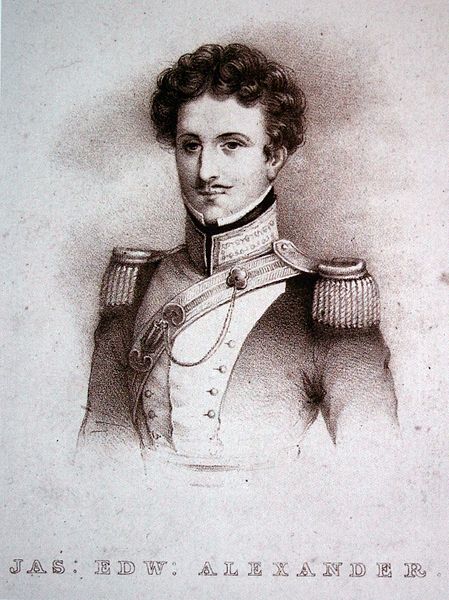
Lt. Col. Sir James E. Alexander, A.D.C., Canada, Chairman.
Capt. Chas. H. Bell, U.S. Navy.
E. K. Collins, Esq. New York.
Captain George Washington Cullum, Corp. of Engineers
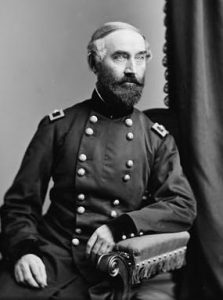
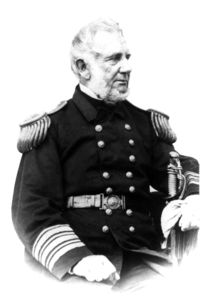
Col. Augustus George Hazard, Enfield, Connecticut.
Major A. Mordecai, U. S. Ordnance Dept., Reporter.
Col. Jas. Page, Philadelphia, Pennsylvania.
F. Tellinghaus, Esq., New York.
A Silver Medal was awarded to Samuel Colt, Hartford, “for various kinds of Revolving Fire Arms. The wide-spread reputation and extended use of these arms, entitle the inventor, in opinion of the jury, to the highest distinction they can award. The arms presented at the Exhibition are of superior workmanship and finish.”
CHAPTER 4 PAGE 180-181
CHAPTER 4 PAGE 180
Display by F. Grote & Co. Ivory Source
Link to a display by F. Grote & Co., a significant ivory source to Colt’s, from the Free Library of Philadelphia site. Grote’s exhibition was at the Philadelphia Centennial Exhibition of 1876, but the company’s history dates back to the period of Samuel Colt, as early as the 1850s.
Contested Will Cases
Data from The New York Times, February 3rd 1882, “Contested Will Cases,” on the will of the late James Stokes, is related also to ivory source F. Grote & Co. (and senior member of the firm, Frederick Grote). Access via ProQuest Historical Newspapers New York Times (1851-2006) w/ Index (1851-1993), p. 3.
Yet another New York Times article appears February 8, 1888, “An Ivory Firm Confesses Judgment.” The article states the business F. Grote & Co. “was established in 1847 by Frederick Grote, who died in 1881. He was successful and amassed a small fortune…” The article notes that “at times [the company] employed 250 hands, and have carried as high as $200,000 in stock. The firm has placed its affairs in the hands of the creditors who have selected William Steinway, the piano manufacturer, as chairman.”
CHAPTER 4 PAGE 194-195
CHAPTER 4 PAGE 194
Engraved Presentation Recipient H.A.G. Pomeroy
Link to Google Books data on H.A.G. Pomeroy, recipient of extraordinary cased and engraved set of shoulder stocked Model 1851 Navy revolver (no. 69640) and Model 1855 Sidehammer revolver (no. 4473), from Colonel Colt. The deluxe set has been pictured in numerous texts, including in The Colt Engraving Book, Volume I, page 128:
CHAPTER 4 PAGE 200-201
CHAPTER 4 PAGE 200
British Royal Navy Colt Revolver Orders
An article on the British Royal Navy ordering Colt revolvers can be accessed from the Omnium Gatherum, April 25th 1854, by using the keyword: “Samuel Colt.” Access is via the Sturgis Library, Barnstable, Massachusetts. Find the newspaper and article date and click to open.
Photos of Samuel Colt Presents
Time, Inc. photo files from Life magazine includes a color photograph made by Life Magazine photographer Eliot Elisofon, in the fall of 1961, at the “Samuel Colt Presents” exhibition, at the Wadsworth Atheneum which relates to London’s Great Exhibition of 1851. A cased set of Dragoon and Squareback Model 1851 Navy revolvers are pictured as a double page spread in Life’s issue of March 2, 1962, entitled “Colt’s Pistols.” These revolvers were form the cased set presented to H.R.H. Prince Albert. The Baby Dragoon was presented to H.R.H. Edward, Prince of Wales. The set of London Navy revolvers had been made for Emperor Napoleon III of France.
Colt Revolvers and “Chinese Insurgents”
Link to the Sturgis Library, Barnstable, Massachusetts for an article on Colt revolvers from the London factory, for “Chinese Insurgents.” Enter: “Col. Colt” and find the article under “Omnium Gatherum.” The date of publication, June 6th 1854.
[pointing hand motif] Among the latest orders sent to Col. Colt’s armory in London, is one for 1000 revolving pistols to be distributed among the Chinese insurgents.
The Colt London Agency
For decades, the most important international agency for the Colt Company was that in London. The first address listed for Colt in that quite international city was as of December 1851, at 1 Spring Gardens, off Cockspur Street, Trafalgar Square. As stated in Joseph G. Rosa’s book, Col. Colt London (page 30), “It was only a small place, but it was central enough to keep [Colonel Colt] in contact with Government departments and the Board of Ordnance, a short distance away in Pall Mall.”
As stated further by Rosa (page 36), “Colt’s London sales office continued to accept and execute orders as fast as arms could be obtained. Indeed, Spring Gardens remained in use until 31st March 1855, when Colt obtained larger and better premises at 14 Pall Mall, ‘opposite the Reform Club’, where the office was to remain for almost sixty years.”
The Pall Mall address was replaced c. 1891-92 by 26 Glasshouse Street, Piccadilly. Then in 1904 the address was moved to 15A Pall Mall, where it would be through 1913, prior to the beginning of World War I.
In 1976 Rosa interviewed Norah Goodbody, the daughter of longtime Colt agent, James Goodbody. Miss Goodbody was then 90, having been born c. 1886. Quoting Rosa: “She remembered ‘The Baron’ as they all called von Oppen, although until I told her she did not realize it was just a name since he was not a baron. She recalled coming home from school one day to be met by a friend who told her that Buffalo Bill was in her house, and, indeed he was. Cody had arrived asking her father to repair one of his pistols. That would have been c. 1892. Miss Goodbody was a lovely old lady and I could have spent hours chatting to her about the agency.”
Charles Dickens’ Household Words Publication
Charles Dickens’ Household Words publication carried the famed author’s description of a tour he made of Colonel Colt’s London factory. The Google Books link which follows did not present that article in its entirety, but as a reprint accompanying the Institution of Civil Engineers presentation of Colt’s lecture of November 25, 1851. That lecture, and paper, was entitled: “On the Application of Machinery to the Manufacture of Rotating Chambered-Breech Fire-Arms, and Their Peculiarities” The lecture was noted as by “Colonel Samuel Colt, Assoc. Inst. C.E. (To Whom a Telford Medal Was Awarded, Session 1851-52) with an Abstract of the Discussion Upon the Paper. Edited by Charles Manby, F.R.S., M. Inst. C.E. Secretary. Third Edition.” The date listed on the title page for the reprint is 1855, and the printing was by William Clowes and Sons, Stamford Street and Charing Cross, London.
The date of publication of Dickens’ Household Words personal tour was originally on May 27th 1854. Present at the beginning of that original article were three lengthy paragraphs, and present at the end was the following paragraph: “My companion has nothing more to show me except the baths and the reading room, supplied chiefly with newspapers, for the benefit of the workmen; so I bid him good day, and go out of the smell of hot rank oil, to enjoy more keenly the cool breeze that is blowing from the river.”
For the complete article, see Household Words, no. 218, May 27th 1854, page 354. The website link listed below, British Periodicals, requires paid registration to access their archives.
Colt’s London Operations
From The Manchester Guardian, December 10th 1851, in a detailed article about a dinner honoring R.J. Walker, “late secretary to the treasury of the United States, having accepted an invitation to dine with the merchants of Manchester, the dinner was held, last evening, at the Albion Hotel, Piccadilly [London], when about 120 gentlemen sat down…” Among the guests, and at the head table, was Colonel Colt.
Colonel Colt and his London Factory
Extensive coverage on Col. Colt and his factory in London, and the proceedings of a Parliamentary Committee, appeared in The Observer of London, April 23rd 1854.
Colonel Colt’s Plans to Export to the Cape of Good Hope
The Manchester Guardian of January 17th 1852, publishers of an article about Colonel Colt’s plans to “export to the Cape of Good Hope, certain cases containing about four hundred and fifty revolving fire-arms of various sizes, with the bullet moulds, & c., complete, now in the Great Exhibition in Hyde Park, the same being intended for the use of officers serving in that colony.“
“Christmas Dinner to the Poor”
The reader should consult the article “Christmas Dinner to the Poor,” from The Observer, January 9th 1853, revealing of the donation to that event, by Colonel Colt “an American gentleman.
CHAPTER 4 PAGE 202-203
CHAPTER 4 PAGE 203
Artist’s Rendering of the Colt London Factory
An artist’s rendering of the Colt London factory appeared in The Espositor of October 29th 1853, a journal published in London.
Link to Garwood & Voigt Gallery, London, England, with print showing Colt factory site at center right, to left of spired church on East river bank. Compare to image of Colt’s factory in The Espositor of October 29th 1853. This birds-eye view in the Garwood & Voigt Gallery, The Illustrated London News, 1859.
CHAPTER 5
PAGE 205
Samuel Colt’s Exhibition at the Fair at the Maryland Institute
Reference to Samuel Colt’s exhibition of arms at the Fair at the Maryland Institute, Baltimore, was published in The Sun, November 2nd 1857, volume XLI, issue no. 148, page 1. Quoting the citation to Colt, from the detailed listing of “Awards of Premiums”:
“CLASS No. 40.- Samuel Colt, Hartford, Conn., for pistols and rifles, deposited yesterday by Merrill Latrobe & Thomas, certificate of gold medal; John Stokes, for case of guns, diploma.”
Among other winners of awards was Steinway & Sons, N.Y. “for grand piano, gold medal”.
CHAPTER 5 PAGE 206-207
CHAPTER 5 PAGE 206
Chestnut Street Theatre c. 1855
In this link the Free Library of Philadelphia, access can be made to an image of the Chestnut Street Theatre, c. 1855. A shooting gallery is at the upper right in the photograph, adjacent to a depiction of a shooter firing a handgun.
The Industrial Revolution in Hartford
Link to the Hog River Journal site, with the Ellsworth Grant article, “The Miracle on Capital Avenue,” dealing with the industrial revolution, in Hartford. Note the relationships between Samuel Colt, his company, and other firms in the city, “one of the wealthiest per capita in America” and “transformed the nature of work for the average laborer.”
CHAPTER 5 PAGE 208-209
CHAPTER 5 PAGE 208
The Dedication of Charter Oak Hall
The complete period monograph, “Proceedings at the Dedication of Charter Oak Hall Upon the South Meadow Grounds of Col. Samuel Colt. With the Addresses on the Occasion by Messrs. Hamersley, Stuart, and Deming.” Edited by J. Deane Alden, listed within as Colonel Colt’s Private Secretary. Note reference to H.A.G. Pomeroy as Colt’s Engineer.
CHAPTER 5 PAGE 216-217
CHAPTER 5 PAGE 216
Artisan Christian J. Deyhle
Artisan Christian J. Deyhle is another talented carver known to have embellished ivory grips for Samuel Colt. Identifying positively the carver of wooden grips in the percussion period at Colts has yet to be determined. Might this also have been the gifted Deyhle?
Christian Deyhle came to the U.S. from Germany, in 1848, brought by Colt to carve ivory grips. Quoting from Volume I of The Colt Engraving Book, p. 77: “The set of silver-mounted Charter Oak and ivory lamp shades in the Wadsworth Atheneum, depicting patriotic motifs, the Colt factory, and other subjects, are signed by Deyhle. As noted in William Hosley’s Colt The Making of an American Legend, pages 135-137 “…one shade represented American liberty, and the other Colt’s empire, the former a not infrequent subject celebrated in the often richly carved ivory grips for Colt percussion revolvers.”
Christian Deyhle, 1880 United States Federal Census
Name: Christian Deyhle
Home in 1880: Philadelphia, Pennsylvania
Age: 60
Estimated Birth Year: abt 1820
Birthplace: Wurttemberg
Relation to Head of Household: Father-in-law
Father’s birthplace: Wurttemberg
Mother’s birthplace: Wurttemberg
Neighbors: View others on page
Occupation: Ivory Turner
Marital Status: Married
Race: White
Gender: Male
Cannot read/write:
Household Members
| Name | Age |
|---|---|
| Jacob L. Rothman | 24 |
| Minnie Rothman | 23 |
| Laura Rothman | 2 |
| Chas. L. Rothman | 1 |
| Christian Deyhle | 60 |
| Laura Deyhle | 20 |
| Charles Deyhle | 16 |
New York Passenger Lists, 1820-1957
Name: Christian Deyhle
Arrival Date: 17 Apr 1855
Estimated Birth Year: abt 1821
Age: 34
Gender: Male
Port of Departure: Le Havre, France
Ship Name: “F.A. Palmer”
Search Ship Database: Search the “FA Palmer” in the “Passenger Ships and Images”
Port of Arrival: New York
Line: 24
Microfilm Serial: M237
Microfilm Roll: M237_151
List Number: 214
Port Arrival State: New York
Port Arrival Country: United States
PATENTS: See Google Patents: Christian J. Deyhle
Naturalization: Nov. 22nd, 1858 New York Court of Common Pleas
Christian J. Deyhle died March 8th 1891, at age 70, of consumption.
CHAPTER 5 PAGE 220-221
CHAPTER 5 PAGE 220
Delmonico’s Restaurant
Established in New York City, 1837, Delmonico’s restaurant continues to this day, represented by the following website link. As one of the foremost restaurants of its day, the firm’s fare was available to dignitaries keen on the best the city could offer, such as the likes of Samuel Colt.
Developing the South Meadows Property
For data on Colonel Colt’s $6,000 expenditure for purchase of land in Hartford, in his intent to develop the South Meadows property, site of his proposed new factory complex, see the Hartford Daily Courant, August 30th 1852.
Charter Oak Carvings
A Dwight H. Buell of Hartford, a jeweler, had a connection to Mark Twain and a man named James W. Paige who may have worked at Colt’s.
Buell, with a Miss Mary H. Wells, is listed in an 1864 (U.S. Sanitary Fair, Chicago) publication as each having made Charter Oak articles. This connection to the Charter Oak calls for further research.
Dwight H. Buell
Later Census records show Dwight H. Buell as having been born in Connecticut, to Connecticut-born parents.
Might Buell have carved Charter Oak items for Samuel Colt? Buell’s craftsmanship is in addition to the work already known on Charter Oak creations, by John H. Most.
Additional Information on the Charter Oak
Extensive information on the Charter Oak is presented via this link to the University of Connecticut, University Libraries Digital Mosaic.
Inspirations of the Charter Oak
Link from the University of Connecticut, University Libraries Digital Mosaic, which demonstrates the many inspirations of the Charter Oak. Note the reference to the Colt factory in Hartford, as the site of the Charter Oak Lawn Mower’s manufacture, c. 1884-1886.
CHAPTER 5 PAGE 224-225
CHAPTER 5 PAGE 225
Photograph of the Charter Oak Tree
Link to the University of Connecticut, University Libraries Digital Mosaic, illustrating a photograph of the Charter Oak, before it fell. From The Connecticut Historical Society collections, predating the fall, on August 21, 1856. Other photographs of the tree, still standing, can also be found on this website. One was printed from a negative made in 1855.
CHAPTER 5 PAGE 228-229
CHAPTER 5 PAGE 229
Exchange Corner on State Street
Link to the University of Connecticut University Libraries Digital Mosaic, with image of the Exchange Corner, on State Street, in Hartford, where at the time Gustave Young had a shop. Note at right center, above the second floor: “G. YOUNG-ENGRAVER.” From The Connecticut Historical Society’s Samuel Taylor Collection; the Mosaic description suggesting the date at c. 1866-67.
Travels of Gustave Young
Information regarding the travels of Gustave Young, leading to what is likely the first meeting of Young with Samuel Colt, at the Great Exhibition of 1851, London: Note 2/3rds the way down the page of “A List of Aliens,” the signature “Gustav Jung”, and the notation under “Profession” of “fabricant” and his “Native Country” as “Prussia.” Young had traveled to London via Ostend, on September 13 1851, sailing on the Triton. On Young’s arrival in the United States, the entry records also list him as Gustav Jung.
To view the entry ledger recording this visit, for a nominal fee one can access the website, ancestry.com and request the page of the Triton’s arrival list in London (via Ostend), which sailed on September 13th 1851. Young’s name on the page listing appears to be “Gustav Tung,” and the request may need to be made using that spelling.
CHAPTER 5 PAGE 230-231
CHAPTER 5 PAGE 230
Rare Lithograph of Philadelphia Schutzen-Verein
Link to ImPAC, The Library Company of Philadelphia, Digital Collections, which will enable locating rare C.P. & A.J. Tholey lithograph of the Philadelphia Schutzen-Verein, 1869. Once ImPAC has been accessed, then enter search keyword “Philadelphia Schutzen-Verein” to locate image. Note the portrait nature of each man’s image, as well as presence of several single shot Schutzen rifles. The Colt company had marksmen in its employ, several of whom were Germans. For single shot rifles in percussion and in breechloading configurations, see The Book of Colt Firearms, pages 207-208 and 475-479 (the Berdan).
Aaron Wolff’s Old Wine Store
Link to ImPAC The Library Company of Philadelphia, Digital Collections, by which can be accessed a photograph of Aaron Wolff’s old wine store, by F. De B. Richards, photographer, April 1859. Fourth floor windows show targets, of rifle and pistol gallery of Mahlon Warne. Once you have accessed The Library Company of Philadelphia, Digital Collections, enter in keywords “Aaron Wolff’s old wine store. ”
Chapter 6
CHAPTER 6 PAGE 234-235
CHAPTER 6 PAGE 235
Note Signed by Samuel Colt
Link for the intriguing $50 interest-bearing three-year note, issued under the Act of 1861, and signed by Samuel Colt.
Pay to the order of Col. Samuel Colt can be seen on the right side of the face of the bill, and Colt’s signature is on the reverse.
CHAPTER 6 PAGE 236-237
CHAPTER 6 PAGE 236
Armand Soubie, New Orleans Arms Dealer
Link to New Orleans arms dealer Armand Soubie (including reference to P. Bouron, Successor to Soubie) in sites of the Duke University Libraries Digital Collections and the University of North Carolina Southern Historical Collection at the Louis Round Wilson Special Collections Library.
Hartford Daily Courant Article by Jefferson Davis, Secretary of War
Reference is made to an article in the Hartford Daily Courant, September 6th 1853, by Secretary of War Jefferson Davis, some eight years later, President of the Confederate States of America. “He reached this city, in sufficient season yesterday morning to inspect the establishment of Col. Colt.” Davis had been a guest of Col. Hazard of Enfield, prior to the visit to Hartford.
The Civil War: Colt’s Loyalty to the Union & Dealings with the South
Questions involved Colonel Colt’s loyalty to the Union, and shipments to the South prior to, and allegedly during, the Civil War were first dealt with factually by John E. Parsons, in “New Light on Old Colts,” in The Texas Gun Collector magazine, later reprinted by the study’s author. Thoroughly examining four serial number record books which had been discovered in a factory attic by Louis Hafner from the firm’s patent department, Parsons answered many questions about post-1860 production, and was the first to draw up serial number-by-year tables for handgun models from 1861 through 1873, and the end of that era.
On the question of Civil War sales, Parsons’ concluded that Colt, though having many Confederate officers and leaders who were either friends or acquaintances, acted responsibly. To quote:
“Among the significant facts revealed by the ledgers is the volume of sales made by Colt in the Southern States just prior to the Civil War. Legend has it that the Colonel was not averse to doing business with both sides; certainly his arms were in demand everywhere. Yet the amount of factory shipments south of the Mason Dixon line was relatively small, and they ceased altogether on April 15, 1861. This was four days after the firing on Fort Sumter and the day President Lincoln called for troops. The largest consignment of all, 1100 Army pistols, went to Kittredge & Folsom in New Orleans between March 28th and April 9th This firm was of Northern origin but its customers undoubtedly had Confederate sympathies. The last shipment, 500 Army pistols, went by express to Peter Williams & Co., Richmond, Virginia, April 15th. Previously J.R. Anderson of the Tredegar Iron Works in Richmond had obtained 250 Navy revolvers on February 6th. Other military arms shipped south were 300 Army pistols to Georgia December 27, 1860; 60 Navy to South Carolina January 3, 1861; 70 Navy to Gravely & Pringle and 50 Army to William M. Sage, Charleston, S.C., January 15th; 72 Navy to James Conning, Mobile, Alabama, same date; 160 Army (with 80 attachable breech stocks) to William T. Martin, Natchez, Mississippi, January 17th; 100 Navy (with 50 cavalry sabers) to P.A. Peale & Co., Vicksburg, Mississippi, January 21st; and 50 Navy to H.D. Norton & Bros., San Antonio, Texas, March 29th.”
During the same period there were numerous case lot shipments to Colt’s New York agency at 240 Broadway and to dealers such as Joseph C. Grubb & Co. of Philadelphia, B. Kittredge & Co. of Cincinnati, A.W. Spies & Co., Schuyler, Hartley & Graham, John P. Moore’s Sons, Cooper & Pond and Smith, Crane & Co. of New York, William Read & Sons of Boston, F.B. Loney & Co. of Baltimore and Child, Pratt and Fox of St. Louis. Undoubtedly some of these arms found their way south before the commencement of hostilities.
Procurement of military size Colts in the North went much slower. Before April, 1861, the ledgers reflect no deliveries to governmental agencies, unless through dealers’ consignments just mentioned. On April 4th 300 Army revolvers were shipped to the United States Quartermaster in New York, and on April 19th T.J. Stead, Quartermaster General in Providence, R.I., received 50 revolvers of the old dragoon pattern. Large quantities of Navy pistols were shipped to various dealers through April, but not until May 9th was there a consignment of 250 Army size to the United States Navy Yard, New York. On May 21st a lot of 500 Army revolvers was shipped to Major William A. Thornton, New York Arsenal, and on the next day 250 to the Boston Navy Yard. The next delivery of 500 Army pistols occurred June 4th to Capt. R.W.K. Whitely, United States Arsenal, Governor’s Island. The Boston Navy Yard received another 250 Army pistols June 8th, and on June 11th Mayor Hath of Cincinnati was shipped two cases of Navy revolvers (100) “for the C;F.V.” Not until June 14th did William Dennison of Ohio receive 500 Army revolvers which he had ordered the previous November and December.
Col. Colt was quite impartial between North and South in making presentations. The first ledger notes on January 30, 1861 that a dozen pistol cases were sent through the New York office to Maj. W.H. Emory, Capt. J.W. Davidson, Col. C.A. May, Col. J.E. Johnston, Capt. Wm. Manadier, Maj. Ben McCullough, Mr. And Mrs. Jacob Thompson, Hon. and Mrs. Howell Cobb, Gov. and Mrs. John B. Floyd. Each case contained a .36 calibre pistol, six of them having 5-1/2 inch barrels and the others 4-1/2 inch. The first five officers mentioned had recently been members of Army ordnance boards passing favorably on Colt arms. McCullough was a long-time enthusiast for Colts since his days in the Texas Rangers. Thompson of Mississippi, Cobb of Georgia and Floyd of Virginia had all been members of President Buchanan’s cabinet, the latter as Secretary of War. Johnston and the last four named were to serve prominently in the Confederacy, others for the Union.
The only entry found of an actual presentation inscription relates to a new model Army .44 calibre revolver with a 6-inch barrel “Engraved to Lieut. Nelson U.S. Navy from Col. Colt.” It was sent via the New York office March 15, 1861. But on the same day two Army pistols with eight inch barrels in mahogany cases were dispatched to Major William A. Thornton care D.D. Tompkins, Assistant Quartermaster General, New York. Major Thornton, a well known ordnance officer who had often inspected Colt arms, obtained four more cased Army revolvers on June 8th for friends in the 2nd United States Artillery: O.D. Greene, J.H. Carlisle, B.H Hill and J.M. Wilson. It does not appear whether these pistols were inscribed. Previously a pair of 8-inch Army revolvers went to “Col. Craig U.S.A. Comdg. Ordnance Corps from Colt’s P.F.A. Mfg. Co.,” and perhaps were so inscribed. Colonel Craig retired April 23, 1861.
Two Southern officers who ordered for themselves cased Army revolvers of the new model were Col. William Wing Loring and Capt. Dabney H. Maury. Both soon resigned from the U.S. Mounted Rifles, in which they had served since the Mexican War, to join the Confederate Army and become eventually major generals. Captain Maury was a nephew of the naval hydrographer Matthew Fontaine Maury, in whose care the pistol was directed to be sent. After the war, Col. Loring served in the Egyptian Army and rose to the honorary status of pasha.
As an added observation on Civil War sales, James L. Mitchell’s Colt A Collection of Letters and Photographs About the Man, the Arms, the Company, in a folio of illustrations between pages 128-129 pictures an order dated April 18, 1861, on the letterhead of the “Confederate States of America, Navy Department. Montgomery.” The request, also published in the text (p. 77) was expressed “Can you furnish this Department with two hundred Navy revolvers…If so, send them…by express here, or if not then to Anderson & Co., Tredegar Works, Richmond, with orders to forward, or ship to Savannah or Charleston or New Orleans – with a hundred rounds of ammunition for each.” The order is signed by S.R. Mallory, Secretary of the [Confederate] Navy.
Significantly, the original letter bears on the reverse side the simple hand-written notation, “not sent.”
James L. Mitchell’s book reflects the anger directed at Colt, from those who felt he was selling to the South (p. 78):
Springfield
April 15, 1861
Colonel Samuel Colt
Dear Sir:
It is gathered from reliable sources that you are manufacturing and shipping ARMS SOUTH in response to orders from the traitors. Now Sir, I am able to inform you that if you fulfill any more orders or ship further supplies South from this date, your establishment will be most thoroughly cleaned out. Yours with respect due a traitor.
(s) Member of V.C. (Vigilance Committee)
To pursue the subject of Colt and the South further, see Mitchell’s chapter “Southern Sales,” and “Southern Armories.”
For a letter relevant to Colt and the Civil War, and the South, see page 541 of Volume II.
CHAPTER 6 PAGE 238-239
CHAPTER 6 PAGE 239
Swiss Chalet Style Worker Houses
From the University of Connecticut, University Libraries Digital Mosaic, illustrated photograph of nine Swiss Chalet style worker houses, originally constructed to house employees of the Willow-Ware Manufacturing Co., at Potsdam Village, Coltsville. Photograph c. 1890-1909.
William Hosley Quotes
The back cover of the paperback edition of William Hosley’s Colt The Making of an American Legend states that the Colt revolver was “the first truly global manufacturing export in U.S. History.”
CHAPTER 6 PAGE 244-245
CHAPTER 6 PAGE 244
General Benjamin F. Butler
Among the diners at Delmonico’s, an acquaintance of Samuel Colt, and owner of Colt revolvers, General Benjamin F. Butler (depicted in 1874), from this New York Public Library Digital Gallery link.
Presentation Colt to Parson Brownlow
Link to the Sturgis Library, Barnstable, Massachusetts for an article on a presentation Colt to Parson Brownlow. Once reaching the site, enter “Presentation Pistol”, and look for the publication date, June 24th 1862. Although the article does not mention Colt, see The Colt Engraving Book, volume I, pages 174-175, for what is likely to be that revolver, a cased, engraved and inscribed Model 1861 Navy, serial no. 5727/., from the Colt’s Armory workman, June 1862.
Parson Brownlow Wikipedia Page
CHAPTER 6 PAGE 250-251
CHAPTER 6 PAGE 251
Eustace Barron and Family
Link to background data on Eustace Barron and his family, from Appleton’s annual cyclopedia and register of important events, via Google Books.
Further Data on Eustace Barron
Link to further data on Eustace Barron, provided via Google Books. Eustace Barron’s father was important to California, before and after the Mexican War. As British Counsel to Mexico, he was also well positioned to oversee a thriving business.
Eustace Barron & Railroading
More on Eustace Barron, this time in railroading, from a Google Books link.
More Tales of Eustace Barron
Eustace Barron, owner of the gold-finished deluxe set of shoulder stocked and cased Colt Model 1860 Army revolvers:
From The Brisbane Courier, Friday, February 22nd 1867
“News By The Mail From Our Own Correspondent.”
London, December, 1866: “One would hardly suppose that from all we have heard of the state of Mexico, its Emperor in a state of bankruptcy, its Empress mentally afflicted by her troubles, the country would be much given to displays of wealth and luxury, but it seems that though its Governments perish the motto of the Mexicans is toujours gai. An American gentleman gives an account of a ball costume there, which would have been memorable in even the most prosperous of cities. The dresses which, by-the-way, were all procured from Paris at, of course, a fabulous expense, were most splendid, and jewels of extraordinary brilliancy adorned many of the ladies. Mr. Eustace Barron, a wealthy banker, was the giver of this splendid entertainment, his sister, Madame Antonion Escandon, being the hostess. This lady was attired as “Fire;” her dress was of black and crimson velvet, with fiery flames embroidered on the skirt, and the real fire which flashed from the magnificent jewels she wore carried out the personification to perfection. Another lady represented “Air,” and one as “Night” commanded great admiration; but to give a description of every charming dress would take up my whole space; I can only therefore further tell you that on this occasion the Mexicans fairly vied with the Parisians.”
CHAPTER 6 PAGE 276-277
CHAPTER 6 PAGE 276
Colt Pocket Navy Depicted in Election Cartoon
Depiction of a Colt Pocket Navy revolver, in an election cartoon by Thomas Nast, January 1877, from The Granger Collection website. Artist’s license has the capping cutout and barrel lug loading cutout on the left side of the cocked revolver.
Evidently Thomas Nast owned a Pocket Navy Colt revolver, since a February 1877 election cartoon repeats the same revolver as used in the above-noted January 1877 election cartoon. Also from The Granger Collection website.
CHAPTER 6 PAGE 278-279
CHAPTER 6 PAGE 279
J.C. Grubb & Company
ImPAC, The Library Company of Philadelphia Digital Collections, will enable access to photograph of the J.C. Grubb & Co. store in Philadelphia. The firm was a major distributor and dealer in Colt firearms. Once ImPAC has been accessed, then enter in the keywords “J.C. Grubb & Co. store” or, a broader search using the term “Grubb” to view image.
Lithograph Showing Gun Shop of Andrew Wurfflein, 1861
Link to ImPAC, The Library Company of Philadelphia, Digital Collections, which will enable viewing of an 1861 lithograph showing the shop of Andrew Wurfflein, of Philadelphia, at the beginning of the Civil War. Print in the collections of the Philadelphia History Museum at the Atwater Kent. Once the ImPAC site has been accessed, enter the keywords: “Andrew Wurfflein gun shop” or, use a broader search term “Andrew Wurfflein” and the image will be located.
Chapter 7
CHAPTER 7 PAGE 282-283
CHAPTER 7 PAGE 283
Samuel Colt and Company
An interesting website including several references to Samuel Colt and the company, including a document listing primarily female employees in the Colt Cartridge Works (1855) is provided by the following link, to “Connecticut History on the Web.”
Connecticut History on the Web
CHAPTER 7 PAGE 286-287
CHAPTER 7 PAGE 286
The International Exhibition, Philadelphia, PA
Link to the Report of the Board on Behalf of United States Executive Departments at the International Exhibition Held at Philadelphia, PA., 1876, Under Acts of Congress of March 3, 1875, and May 1, 1876. In Two Volumes. Published by the Government Printing Office, 1884. Volume I includes numerous firearms, by a variety of makers, exhibited, several of which are Colts. From the Google Books site.
Calcutta International Exhibition
Link from Google Books regarding the Calcutta International Exhibition, 1883-84, Volume II. Reference made to “Military Exhibits” and the Fort William Arsenal. A Paterson Colt holster model was included in the exhibition.
Smith & Wesson, Colt, Allen’s XL and Remington Displays
In a link from Google Books, the Twelfth Exhibition of the Massachusetts Charitable Mechanic Association, at Faneuil and Quincy Halls, Boston, September and October, 1874, and published in that year, lists a reference to display of a “Case containing samples of Smith & Wesson, Colt, Allen’s XL and Remington revolvers and pistols. Many of these were highly finished, being plated with gold, silver, and nickel, and having ivory and pearl handles.”
War Department Exhibit at the Centennial Exposition
Google Books link which presents the Catalogue of the Exhibit of The War Department at the Centennial Exposition of the Ohio Valley and Central States, Cincinnati, Ohio, July 4 to October 27, 1888, printed in that year. Colt and many other makes of firearms were represented in this comprehensive event. Some of the Colt firearms were lent “From the Colt’s Arms Co.”
Philadelphia Centennial Exhibition of 1876
Links to the Philadelphia Centennial Exhibition of 1876, featuring the Laflin Orange Powder Co., and the Collins Company.
Placido Zuloaga at the Philadelphia Centennial Exhibition
Link to participation of Placido Zuloaga, son of renowned damascene and sculpted steel embellisher of Spain, to the Philadelphia Centennial Exhibition of 1876. Participants and attendants to the Colt company display would likely have also seen this display.
The Cotton States and International Exhibition, 1895
Link to yet another major exhibition in which the Colt company participated: The Cotton States and International Exhibition of 1895. Following is the official catalogue of the event, from Google Books. A number of firearms are listed on pages 170-173. Colt, Marlin, Savage and Winchester were among the exhibitors, in Group 50, see nos. 67-71.
For further information on the Cotton States and International Exhibition, 1895, see the following link, to Wikipedia The Free Encyclopedia.
Winchester Grand Prize, Cotton States and International Exhibition
In this link, a reference to Winchester having won the Grand Prize at the Cotton States and International Exhibition, 1895, one can view a Winchester advertisement, and just below that, a notice about the forthcoming Sportsman’s Exposition, at Madison Square Garden, New York City.
Sportsman’s Exposition, 1897, Madison Square Garden
Link to the Sportsman’s Exposition of 1897, at Madison Square Garden, New York City, via Google Books. The source, The Sportsman’s Magazine, of April 1897, includes a photograph taken of the Colt company’s exhibit, and provides a general description of highlights from the firm’s displays.
CHAPTER 7 PAGE 296-297
CHAPTER 7 PAGE 297
Gun Makers in Hartford, 1880
Partial tabulation of gunmakers in Hartford, 1880, put together by Conor FitzGerald, based on U.S. Census records, accessed on ancestry.com. Access directly to ancestry.com requires subscription by the user.
Partial Listing of Gun Makers in Hartford
From United States Census 1880| Name | Parent/Spouse Names | Home in 1880 | Birth Year | Birthplace | Relation |
|---|---|---|---|---|---|
| Adam Brodmaun | Cathrine | Hartford, Connecticut | abt 1822 | Wurttemberg | Self (Head) |
| Chas. Halbricht | Louisa | Hartford, Connecticut | abt 1825 | Germany | Self (Head) |
| Alfred G. Herrington | Etta S. | Hartford, Connecticut | abt 1830 | New York | Self (Head) |
| Josiah Howe | Hartford, Connecticut | abt 1831 | Massachusetts | Uncle | |
| Emanuel Janks | Emma | Hartford, Connecticut | abt 1823 | England | Self (Head) |
| Charles Kutecher | Margaret | Hartford, Connecticut | abt 1837 | Prussia | Self (Head) |
| John Naer | Hartford, Connecticut | abt 1818 | Pennsylvania | Self (Head) | |
| Pat O'Hagan | Hartford, Connecticut | abt 1841 | Ireland | Something other than a direct relationship (Other) | |
| Chas. H. Saunders | Helen A. | Hartford, Connecticut | abt 1841 | Connecticut | Self (Head) |
| Paul F. Snyder | Terassa | Hartford, Connecticut | abt 1841 | Sax Cobury | Self (Head) |
| Marshall St. John | Bridget | Hartford, Connecticut | abt 1829 | Canada | Self (Head) |
| Chas. Statlinger | Johann | Hartford, Connecticut | abt 1821 | Germany | Self (Head) |
| David Watkinson | Sarah | Hartford, Connecticut | abt 1848 | Connecticut | Self (Head) |
| Jas. W. Wood | Sarah A., Adelia | East Hartford, Connecticut | abt 1837 | Massachusetts | Self (Head) |
Chapter 9
CHAPTER 9 PAGE 326-327
CHAPTER 9 PAGE 327
Quotation of Undetermined Source
The source of the following quotation has yet to be determined:
Be not afraid of any man,
No matter what his size.
Just call on me in time of need,
And I will equalize.
The earliest reference known to the authors has been located in the following source: Education and American Civilization, by George Sylvester Counts, Horace Mann-Lincoln Institute of School Experimentation (1952). In that 491-page volume the reference appears on page 79.
Fair Warning
From The Granger Collection website, movie still with actor checking his 4-3/4 inch Single Action Army revolver. Fair Warning, 1931, starred George O’Brien and Mitchell Harris.
The Fighting Roosevelts
Another film still from The Granger Collection website: The Fighting Roosevelts, a silent made in 1919. 5-1/2 inch Single Action Army cocked and ready for action.
William S. Hart’s Handgun Collection
Link via Google to the Time, Inc., Life magazine photograph archives, with c. 1945 images by Peter Stackpole, of William S. Hart, including his handgun collection. These pieces once “belonging to old time Western bandits and pioneers.” Single Action Army revolver at upper left of collection believed to be one that Hart had acquired, alleged to have belonged to Billy the Kid. Several other Hart images also shown.
Draped in the American Flag, Pistol Aimed
Link to a classic patriotic image likely taken in the Sierra Nevadas. The photograph on the University of California site, Calisphere, from the Bancroft Library Portrait Collection, Berkeley. Photograph titled, Draped in the American Flag, Pistol Aimed, by Elisha Winchell (c. 1826-1913).
CHAPTER 9 PAGE 334-335
Patent Drawing for Colt Automatic Ejection Revolver
Patent drawing needed for Colt automatic ejection revolver, serial no. 21203. Patent issued to: Stephen W. Wood, no. 178824, of June 13, 1876.
CHAPTER 9 PAGE 340-341
CHAPTER 9 PAGE 340
The Philadelphia Centennial Exhibition
Link to the Free Library of Philadelphia, with an image from the Philadelphia Centennial Exhibition. The exquisite cabinetry often found in the finest promotions including by gunmakers like Colt’s. Wm. H. Horstmann & Sons was also known to have dealt in Colt firearms.
John P. Lower, Sportsmen’s Depot
Link to the Denver Public Library, Digital Collections website, a photograph of the façade of J.P. Lowers shop, Sportsmen’s Depot, titled ‘John P. Lower, guns, rifles, pistols, ammunition sporting and fishing tackle, field and spy glasses, indian goods, &c. 381 Blake Street, Denver, Col.’ Lower was a dealer selling numerous Colt and other make firearms, ammunition and accessories.
Sharps Rifle Co.
Note that the Sharps Rifle Co. has been given significant credit for the industrial excellence that was a hallmark of Hartford, Connecticut, beginning in the mid-19th century. To quote Ellsworth Grant’s “The Miracle on Capital Avenue,” on the Hog River Journal website: “Long before the building of the State Capitol, even before the completion of the Colt Armory, another entrepreneur was making rifles in the pasture land between Laurel and Broad streets parallel to the Little or Hog River. The success of Christian Sharps’ gun factory was responsible for the Rifle Avenue name and also the catalyst for a succession of businesses that made Hartford a center of metalworking, and renowned for the skill of its machinists, for a hundred years.”
Hartfords Industrial History
A quotation from Ellsworth Grant’s article is the following: “The invention of the sewing machine was the third stage in the evolution of mass production after the principles of interchangeability were applied to clocks and guns. The Weed Company played a major role in making Hartford one of three machine tool centers in New England and even outranked the Colt Armory in size if not fame. Weed eventually was the birthplace of both the bicycle and automobile industries.”
Note that eventually (1878) the name “Rifle Avenue” was replaced by what is today known as “Capitol Avenue,” in Hartford.
Grant closes his article with this statement: “Today, none of the incubators of the miracle on Capitol Avenue remain. They accounted for the progression of mass production from guns to sewing machines to machine tools to bicycles to automobiles and, finally, to jet aircraft engines. It would be hard to match that record of entrepreneurial ingenuity anywhere, at anytime.”
CHAPTER 9 PAGE 344-345
CHAPTER 9 PAGE 344
Abdullah Bey
From an Austrian site, this link reveals a period photograph of a horseman, Abdullah Bey, on the Graf Lanckoronskische Expedition (1883). Photograph credited to Karl Anton Graf (1848-1933), Bey appears to be armed with a Single Action Colt revolver, the grips likely of bone, ivory or pearl.
CHAPTER 9 PAGE 358-359
Display Case Designed by Edward Tuckerman Potter
One of the most distinguished architects of the era, Edward Tuckerman Potter was first brought to Hartford by the recently widowed Mrs. Samuel Colt. She wished to carry on with memorializing her late husband, and sought the right designer of a private museum, which she termed a Cabinet of Memorials, for display at Armsmear.
In future years, Potter would serve as architect for several projects in Hartford, not the least of which was Mark Twain’s mansion and carriage house at Nook Farm on Farmington Avenue.
Potter also designed the Colt Memorial Church of the Good Shepherd (completed January 1869), as well as the Parish House, the latter in memory not only of Caldwell Colt, but of the Colonel and all of the children.
Within the concept of the Armsmear Memorial was a large wall cabinet, in which were displayed not only Colt firearms, but arms which represented the history of the revolver, miscellaneous souvenirs of European travel, and gifts to the Colonel.
When R.L. Wilson first came to the Wadsworth Atheneum in 1959, to interview for a curatorial internship for the summer following, he was shown the arms collection. The Colt wing was then closed to the public. The two-story structure, built with funds from Mrs. Colt’s bequest, and joining the original Atheneum building of 1842 with the J.P. Morgan Wing, was dusty and dirty; it was a hot, steamy day. Potter’s huge glass-fronted firearms display case was on the second floor. The arms collection was mounted therein, using fixtures exactly like those found on the Schuyler, Hartley & Graham display board. Some arms were rather precariously mounted, and the entire wing was in grave need of cleaning and renovation.
Night and day during the summer of 1960 Wilson worked in a makeshift office and studio on that second floor, the windows open to circulate a modicum of fresh air. Every piece was removed from the cabinet, and the arduous task was begun which would become, three years later, The Arms Collection of Colt book. That summer intern project also led to Wilson’s first book, Samuel Colt Presents, and to the ambitious loan exhibition which the book chronicled and catalogued.
In the course of cleaning and recording each piece, plans were laid for a re-exhibiting of the collection. Research showed that this was not just the arms collection of Colonel Colt, but also that of his wife. After his death, Mrs. Colt wished to have a representative display of the array of Colt and other-make arms in Armsmear, and what had been in the home c. 1862 was the basis for that presentation. However, since some models were not represented, largely a selection of the Colt company’s line at the time, these were brought to Armsmear.
In 1960-62 the Wadsworth Atheneum decided that the mammoth Potter cabinet was not the best means of displaying the arms, and it was de-accessioned. First going into the collection of Johnie Bassett, of Arkansas, and then, in time became a part of the Robert M. Lee Collection.
Only missing from the huge cabinet, measuring 131 x 54-inches (center cabinet) and 107-1/2 x 99-1/2 inches (each of the side cabinets), were the carved walnut rampant colt figures, at the right and left of the center exhibit space. The side wings had been primarily for hand and long arms, edged weapons, a presentation John Brown Pike, and other weaponry. The center cabinet held such treasures as the wood revolver model carved by Colt as a young seaman, and other items more memorabilia in nature.
On Friday evening, November 3, 1961, the Samuel Colt Presents exhibition opened, with throngs of collectors, museum trustees, and visiting dignitaries viewing the most ambitious display of Colt firearms, 1836-1873 in history. Opening that same evening was the exhibit of the Samuel (and Elizabeth Hart Jarvis) Colt collection, as well as a display of documents, drawings, watercolors, and memorabilia associated with the Colts. The huge case, then still on the second floor – was not open for public viewing, its contents having been removed, and set up downstairs in an elaborately carved room which had also been removed from Armsmear, in 1905.
One means of gauging the importance of the combined loan and Atheneum permanent exhibition is to note that the all-time single day and exhibition attendance figures for the Atheneum were broken, not to be matched for decades. Further, the exhibits became subject of a feature article in two of the foremost magazines of the day: Life (March 3, 1962) and True (June 1962).
CHAPTER 9 PAGE 360-361
CHAPTER 9 PAGE 360
Colt’s in Film
Fancy-gripped and likely engraved Bisley Colt in deluxe hand-tooled holster, from a silent film still on The Granger Collection website.
CHAPTER 9 PAGE 362-363
CHAPTER 9 PAGE 363
Von Lengerke & Detmold
Link including two images relevant to Von Lengerke & Detmold, during a 1912 Olympic Victors’ parade, in New York City. This firm ranked among the Colt company’s dealers for many decades, and was later absorbed by Abercrombie & Fitch.
The firm’s main building is on the left of the arched entrance. A magnifying glass is needed to see the detail.
Chapter 10
CHAPTER 10 PAGE 370-371
CHAPTER 10 PAGE 370
William S. Hart
From the Beinecke Rare Book and Manuscript Library digital collections, Yale University, a posed still photograph of film star William S. Hart, armed with a double action Colt revolver.
Colt .45
Actor Randolph Scott with Colt revolvers in the film, Colt .45.
CHAPTER 10 PAGE 374-375
CHAPTER 10 PAGE 375
The Putnam Phalanx
Photograph of a member of the Putnam Phalanx, of Hartford, Major Horace Goodwin. From The Connecticut Historical Society collections. Photograph taken in 1860.
Shooting Trophy
A shooting trophy, on which a set of Colt double action revolvers is the principal component.
CHAPTER 10 PAGE 384-385
CHAPTER 10 PAGE 384
Improvements Required in Arming Police in New York City
Data which indicates improvements required in arming police in the City of New York, quoted from “Report of the Police Department of the City of New York for the Year ending December 31, 1896” (N.Y. Martin B. Brown Company, Printers & Stationers, Nos. 49 and 57 Park Place, 1897). Cited from pages 14 and 15:
“POLICE REVOLVERS
“During the past year, a thorough inspection has been made of the revolvers with which the officers of the Department are equipped. It was found that but comparatively few possessed the standard revolver, and of these a still smaller number were found to [be] in good and serviceable condition. Many [police] were armed with revolvers of a cheap and dangerous pattern of various calibres, and a large percentage out of order and dangerous to the person carrying them as well as to others. The Board, considering it of the highest importance that the Police Force should be armed with a uniform revolver, so that in case of public disturbance, ammunition of a standard calibre and quality could be readily furnished to the entire Force, and it also being important that the Police Force should be equipped with the best and safest arm, a board of recognized experts was appointed for the purpose of investigating and reporting upon the best known Police revolver. The competition was open to all manufacturers, and after a most thorough and careful competition, the committee of experts reported upon a revolver which has since been adopted by the Police Board as the standard for the Department. Officers who are at the present time equipped with revolvers of the former standard, in good condition, are not required to replace them with the new arm, but all others, amounting to more than one-half of the Force, are required to provide themselves forthwith with the new standard. “The importance of this action was further impressed upon the Board by the occurrence of several accidents resulting from the premature or accidental discharge of revolvers, in more than one case resulting in the death to members of the Force.”
For further information see Theodore Roosevelt Hunter-Conservationist, pages 99, 105, and 107, which document the role played by Roosevelt, then Police Commissioner, City of New York, in updating the firearms carried by the force.
Women and Self Defense
Quoting from the Daily Evening Bulletin, San Francisco, California, September 24, 1870, issue [145 and 34], column C:
“A young lady of New Haven, taking example by the heroism of one of her sex in Indiana, publicly announced that it will not be [well] for young gentlemen to offer her insults, as she will go through the streets armed with a Colt’s navy revolver.”
CHAPTER 10 PAGE 388-389
CHAPTER 10 PAGE 388
Illustration of Colt Revolvers and Automatic Pistols
Link providing illustration of a Colt Revolvers and Automatic Pistols price list, of December 4, 1922. From The Connecticut Historical Society Collection. Note reference to “(Destroy all previous lists).”
The Public Enemy
Link from The Granger Collection website, with still from The Public Enemy, Jimmy Cagney sporting a New Service revolver, with Edward Woods also armed with a Colt (1931).
CHAPTER 10 PAGE 396-397
CHAPTER 10 PAGE 396
Dewey Loving Cups and Swords
Link from the University of California site, Calisphere, showing the Dewey Loving Cups and Swords, at the exhibition by Tiffany & Co., at the Pan American Exposition, San Francisco, 1915. From the Keystone-Mast Collection, California Museum of Photography.
CHAPTER 11
PAGE 405
Colt Government Model .45ACP
For a working schematic of the Colt Government Model .45ACP pistol, see the Colt’s Manufacturing Co., Inc., website.
The pistols shows loading and insertion of the magazine, chambering of a round, firing, and ejection. And offers several other animated features.
Greece and Serbia, Ordering Colt Automatic Guns
Link to the Sturgis Library, Barnstable, Massachusetts, to article on Greece and Serbia ordering Colt “automatic guns,” article in The Patriot, dated October 18, 1915. To access enter “Greece and Serbia, Colt Automatics,” find publication date, and locate article.
It is reported in Hartford that the Colt Arms company has received an order for $16,000,000 worth of automatic guns from Greece and Serbia.
Production of Colt Model 1911
Series of photographs showing production of the Colt Model 1911 Government Model Pistol, from the Library of Congress Prints & Photographs Online Catalogue, by the gifted photographer Andreas Feininger (1906-1999). Images were taken during World War II. Note female gunmakers. Likely due to wartime restrictions, the identity and location of the factory was not revealed.
Among other photographs in this collection are White House police competing in pistol shooting competitions, soldiers training with the .45 Colt at Fort Knox and at Daniel Field, Georgia, and black soldiers from the Civil War, armed with handguns.
Troops with Colt 1911 Government Model .45ACP Pistols
From the Beinecke Rare Book and Manuscript Library digital collections, Yale University, a troop of U.S. Army soldiers, in the field, with Colt 1911 Government Model .45ACP pistols. Notes indicate their assignment was to the Mexican border, “ca. 1910-1917”.
Lt. John Emser
Close up of a Government Model in a shoulder holster, being worn by Lt. John Emser, then leading U.S. Infantry, attacking German fortifications on the Italian front. Photographed by Margaret Bourke-White, at Loiano, April, 1945.
Abercrombie & Fitch Co.
From the collections of the Museum of the City of New York, a rare photograph of the interior of the Gun Department at Abercrombie & Fitch Co. Note line-up of handguns, despite the fact that the Sullivan Law had been instituted only a short time before this image was taken, in 1913.
Popular Science Magazine
Link to an unusual article in Popular Science magazine, September 1917, covering a rather bizarre patent for the Colt Government Model pistol.
CHAPTER 11 PAGE 408-409
CHAPTER 11 PAGE 408
Shooting and Fishing Magazine
For further information on Shooting and Fishing magazine, see the following link to Wikipedia The Free Encyclopedia, on the history of the American Rifleman magazine, a successor to Shooting and Fishing.
CHAPTER 11 PAGE 424-425
CHAPTER 11 PAGE 424
Bill McMillan Shooting Trophy
Link to shooting trophy named after U.S. Marine Corps competitive shooter, Bill McMillan, champion shot with the Colt .45, and winner of numerous awards and trophies.
CHAPTER 12
PAGE 431
E.K. Tryon, Jr. & Company
Display at the Centennial Exhibition of 1876
Link to the Free Library of Philadelphia site, showing display by company founded by E.K. Tryon, Jr. & Co. at the Centennial Exhibition of 1876. Tryon is a name which figured prominently in sales of Colt arms over the decades. Note handguns at lower section of exhibition case.
The Adventures of the Russian Grand Duke Alexei
For further information on the adventures of the Russian Grand Duke Alexei, whose travels in the U.S. and hunts in the West with W.F. “Buffalo Bill” Cody and Lt. Col. George Armstrong Custer inspired tremendous national interest, the reader is recommended to consult the Wikipedia website for the Grand Duke Alexei: “In 2006 the diary of Grand Duke Alexei Alexandrovich was found in the Russian National Library along with Yussupov funds. The journal, written in English, begins in 1862 and ends in 1907. It has not been published yet.”
CHAPTER 12 PAGE 444-445
CHAPTER 12 PAGE 444
View of the Park River, Hartford Showing the Dome of Colt’s Factory
A 1925 view of the Park River, Hartford, nears the Dutch Point Station, showing a railroad bridge, and in the far right, the dome of Colt’s factory. From the University of Connecticut University Libraries Digital Mosaic, and in the collections of The Connecticut Historical Society.
CHAPTER 12 PAGE 450-451
CHAPTER 12 PAGE 450
Gatling Gun Company Trade Card
Link to Gatling Gun Co. trade card on the Centennial Exhibition Digital Collection site. The card, c. 1876.
Gatling Gun Images
Gatling Gun from a British Library site; from John Thomson’s Illustrations of China and Its People, 1873.
Link to Gatling Gun stereoscopic image, from the Philippines, on the University of California site, Calisphere. From the Keystone-Mast Collection, California Museum of Photography.
Gatling Gun Stereoscopic Photograph
CHAPTER 12 PAGE 451
The Dauntless
From the Duluth News-Tribune, published as The Duluth News Tribune; January 4th 1896; Duluth, Minnesota, a brief article about the fate of Caldwell Colt’s yacht, The Dauntless:
THE TATTLER.
…Mrs. Samuel Colt, mother of the late Caldwell Colt, the well known yachtsman, has placed his famous schooner The Dauntless in dock at Essex, Connecticut, where it will be allowed to fall to pieces.
Illustrations and Information on Caldwell Colt’s Yacht
Extensive illustrations and information on Caldwell Colt’s schooner yacht, The Dauntless is provided by this link to the University of Connecticut, University Libraries Digital Mosaic. The images include the yacht under sail, racing, interior and deck views, the crew, Caldwell Colt himself, and others, and the end of the vessel, at moorings in Essex, Connecticut, aflame and partly submerged. Colt’s ketch the Oriole is also pictured. Images from the Mystic Seaport collections.
Caldwell Colt’s Schooner Yacht Illustrations
Commodore Colt and the Colt Cup
Link to Google Books for data from Munsey’s Magazine, volume 24, with data on Commodore Caldwell Colt and the Colt Cup.
Dining Room of Caldwell Hart Colt’s Yacht The Dauntless
Link to the University of Connecticut, University Libraries Digital Mosaic, illustrating the dining room of Caldwell Hart Colt’s schooner yacht, The Dauntless, taken between the years 1882 and 1894. From the Mystic Seaport collection. Note banjo at right.
Caldwell Hart Colt’s Schooner Yacht Images
The Dauntless Double Cabin
Link to the University of Connecticut, University Libraries Digital Mosaic, illustrating the double cabin likely occupied by Caldwell Hart Colt, on his schooner yacht, The Dauntless. c. 1882-1894. From the Mystic Seaport collection. Note cigars and spirits.
Double Cabin on Caldwell Hart Colts Schooner Photo
Gifts from Mrs. Samuel Colt to Larchmont Yacht Club
Link to The New York Times with article noting the gift from Mrs. Samuel Colt of a signal cannon from The Dauntless, to the Larchmont Yacht Club. The present was in memory of Caldwell, and included a statement from Mrs. Colt. Date of publication, May 20th 1894.
Link to another article in The New York Times about the gift of a cannon to the Larchmont Yacht Club, from Mrs. Samuel Colt. That date, two days before, on May 18th 1894, identified the cannon as “the famous brass cannon of the old Dauntless….”
CHAPTER 12 PAGE 454-455
CHAPTER 12 PAGE 454
Uses of the Thompson SubMachine Gun
Including the gun collection in the crime laboratory of Northwestern University, Chicago, this link gives an idea of some of the uses of the Thompson Submachine Gun, which caused grave concern to the makers at Colt’s factory. From the site of the Berrien County Sheriff’s Department.
Sir Winston Churchill
An August 1940 photograph from Media Storehouse, of Sir Winston Churchill, with a Thompson Sub Machine Gun, and smoking his trademark cigar.
Demonstrations of Colt’s New AR-15 Rifle
Demonstrations of Colt’s new AR-15 rifle, as captured by Life magazine photographer Arthur Rickerby, 1963. Accessed via Google, in the Time, Inc., Life magazine photo archives. Note Del Shorb wearing shooting jacket with Colt logo on pocket. The lady doing much of the firing is recalled by Shorb as a company employee of that period.
Alleged Faults of the M16 Rifle
Link to Time Life Pictures/Getty Images, a photograph of U.S. Congressman Richard H. Ichord, in Vietnam, looking into faults alleged of the M16 rifle. An early model with the straight forend, as well as the bolt assist.
A color image of U.S. Senator Lloyd Bentsen, firing a Colt M16 rifle, can be accessed from Getty Images. The Senator wears a quite senatorial suit, and has ear protection. Senator Bentsen was himself a keen shooter and sportsman, and his cousin Calvin Bentsen, also a keen outdoorsman, supplied several Black Rhinoceros to the Disney World safari park, in Orlando, Florida. These had been protected on Calvin Bentsen’s conservation-oriented ranch, in Texas.
Hartford Police Patrol Wagon
An illustration of a Hartford Police patrol, in a wagon, with the Model 1895 Colt Browning “potato digger” belt fed and tripod-mounted machine gun. Formerly in the Honiss Oyster House Collection, transferred to The Connecticut Historical Society, 1982.
Epilogue
EPILOGUE PAGE 460-461
EPILOGUE PAGE 460
Elizabeth Jarvis Colt’s Gift
From The Morning Herald, published as The Lexington Herald; August 31st 1905; volume 35; issue no. 243; page 1; Lexington, Kentucky, a reference to Mrs. Colt’s gift of her mansion, Armsmear, and of grounds for a park:
CITY MADE BENEFICIARY IN COLT WILL.
(By Associated Press)
HARTFORD, Conn., Aug. 30.
The will of Mrs. Samuel Colt, widow of the inventor of the Colt firearm, was presented for probate today. Practically the entire estate of $3,000,000 is distributed. The city will receive the magnificent grounds around Armsmere [sic.], the Colt mansion, for park purposes, at the death of Mrs. Colt’s brother, Richard W.H. Jarvis. The house will be for use as a home for widows and orphans of the Protestant Episcopal clergymen.
Elizabeth Jarvis Colt Obituary
A detailed obituary of Mrs. Colt appeared in the Hartford Courant newspaper, soon following her death on August 23rd 1905; access is at a fee, on the newspaper’s website.
EPILOGUE PAGE 478-479
EPILOGUE PAGE 478
Pistol Drawing Contest, September, 1952
Link via Google featuring “Kid’s Pistol Drawing Contest,” shot in September 1952, by Joe Scherschel, from the Time, Inc., Life magazine photo archives. Numerous photographs, many showing boys and girls doing the quick draw, or otherwise firing cap pistols, based on the Single Action Army revolver. In that era, quick draw contests were popular with adults, and this nationwide interest had been influenced largely by the frequent television and film programs on the West. The figure in the brochure is Arvo Ojala, well known shooting coach and master of the quick draw. It was Ojala who faced off against Matt Dillon in the opening segment of the dominant Western on television, “Gunsmoke.”
EPILOGUE PAGE 488-489
EPILOGUE PAGE 488
The Ship Corvo and Captain Jeremiah Spalding
Several references to the ship Corvo and to [Captain Jeremiah] Spalding appear in the following citations, each of which can be located by using the website of Readex Historical Newspapers (a division of NewsBank):
Portland Advertiser, published as Portland Advertiser and Gazette of Maine;
Date: August 3rd 1830; volume: VII, issue no. 82; page 3; Portland, Maine.
Notice regarding the sailing of the Corvo. From Boston destined to Calcutta, July 31st 1830, Spalding in command.
Another reference on the sailing of the Corvo, appeared in The Salem Gazette;
Date: August 3rd 1830; volume VIII; issue no. 62; page 3; Salem, Massachusetts.
An article on the sailing of the Corvo appeared in the Weekly Messenger, published as The Boston Weekly Messenger; August 5th 1830; volume 11; issue no. 9; page 3; Boston, Massachusetts.
To quote the entire article:
“Departure of the Missionaries – On Monday, the ship Corvo sailed for Calcutta, with Messrs Hollis Read, Wm. Hervey, and Wm. Ramsey, and their families, missionaries to Bombay, and Mr. John Taylor Jones and lady, to join the Burmah mission. India-wharf, and the shipping, in the neighborhood, were thronged with the friends of the missionaries, and thousands who had come to witness the affecting farewell. A prayer was offered by the Rev. Mr. Jackson, of Charlestown, a hymn was then sung, and another prayer for the safety and success of the missionaries, was made by the Rev. Mr. Green, of Boston. —Paladium.”
One can imagine the impact of this departure on young Samuel Colt.
A brief note on the sailing of the Corvo also was posted by the Baltimore Patriot, of August 4th 1830; volume XXXVI; issue no. 29; page 2; Baltimore, Maryland.
Note: Readex is a subscription service, and requires registration and a payment to utilize their services.
Death & Estate of Captain Spalding
Death and estate reference to Captain Jeremiah Spalding, “master mariner,” and captain of the brig Corvo, on which Samuel Colt sailed as a young seaman, and on which he invented the revolver, is contained in the Boston Daily Courier, published as the Boston Semi-Weekly Courier, June 25th 1855, volume XXXI, issue no. 5057, page 3. This article includes the following, indicating Spalding had gone to the California gold fields:
“Administrator’s” Sale of Real Estate
By virtue of a license of the Probate Court for the county of Norfolk, dated May 13, 1855, will be sold by public auction on SATURDAY, July 7th, 1855, at 4-1/2 o’ clock 1… M. on the premises, all the right, title and interest which Jeremiah Spalding, late of Benicia, in the county of San Francisco and state of California, master mariner, deceased, had at the time of his death in and to the following described parcels of real estate, to wit – [listing property in Roxbury, Norfolk County, Massachusetts “by deed dated October, A.D. 1846, and recorded with Norfolk Deeds…”
[Plus another plot of land, and yet another.]
Access to this data is available via the website of Readex Historical Newspapers (a division of NewsBank). Note: Readex is a subscription service, and requires registration and a payment to utilize their services.
The Corvo
For further data on the Corvo, use the links as follows, which present several relevant volumes pertaining to the missionaries noted above, courtesy of Google Books.
Research by Conor FitzGerald has determined that the Corvo is mentioned fairly often in British newspapers of the late 1820s and 1830s, but much of what is said is quite limited.
Engravers Part 1 and 2
ENGRAVERS PAGE 495-496
ENGRAVERS PAGE 496
Families of Engravers
Excerpt below from the soon to be published, Lock, Stock and Smoking Barrel.
Sons of Wilbur A. Glahn, which led to data on the family of engravers, as well as most specifically on Wilbur. Gunmaker’s pulls, invoices, notes, etc. See The Colt Engraving Book, Volume II, pages 550-551. The Nimschke Book, page 95, also had data on the Glahn family of engravers.
Years later Wilson met yet another member of the Glahn family, from whom interesting items were gathered, as pictured in The Colt Engraving Book, pages 558-559, 594-595 and 598.
Grandson and granddaughter-in-law of Gustave Young, at the Young family home, in Springfield, Massachusetts. Leading to identifying several engravers working for him, and a great deal of additional material. Enough information to fill Wilson’s car for three trips in hauling off the material. See The Colt Engraving Book, Volume I, pages 72-74, and 201.
While researching Kornbrath, Wilson located Hugo Reuss, an engraver and die-cutter, who was still coming to his office and workshop in Hartford, even though he was quite elderly. Reuss had shared office space with R.J. Kornbrath, and the advertisement pictured on page 384 of The Colt Engraving Book, Volume I, was acquired from Reuss at that time. The caption reads as follows:
Above: Original art work by Hugo Reuss; in the period of post-World War I. The emphasis is on die work.
Reuss worked three years for Helfricht, and went into business for himself in 1887. Two other pieces of advertising art by Reuss, from the same period, refer to him as an engraver and die sinker, but neither mentions his firearms work. After leaving Helfricht’s employ, Reuss appears to have concentrated on the die cutting, and on fine jewelry work. (Private Collection).
Visiting at the Colt factory with engraver Alvin F. Herbert, whose career at Colt’s began c. 1954, was revealing of details about not only his career (previously he was a Smith & Wesson engraver), but that of his predecessor Wilbur A. Glahn.
Wilson first met Alvin A. White, through Herb Glass, in 1966. At that time Glass was desirous of Wilson taking over the management of White, and developing that into what would become A.A. White Engravers, Inc. White had met the last of the Ulrich engravers, Leslie Borden Ulrich (a son of John), and lent to Wilson a photograph of this artisan, with two of his standard poodle hunting dogs. The caption to this photograph, on page 346 of Winchester Engraving, states:
Leslie Borden Ulrich, with two of his poodles, which the retired engraver used as hunting dogs. This rare photograph was a gift from Ulrich to Alvin A. White, then doing some gun engraving for him. (Alvin A. White Collection)
Granddaughter of Cuno A. Helfricht, leading to a treasure trove on that artisan, as well as on his father, stock maker, gunsmith and engraver, Charles J. Helfricht. The cache also ferreted out extensive information on engravers in Cuno Helfricht’s employ, and included several engraved examples, invoices, drawings, and so forth. See The Colt Engraving Book, Volume I, pages 379-391.
Visits to the engravers at the Winchester factory located a few items; the Kusmit brothers; Nick and Robert, had several records and material from the days of the Ulrichs and their associates. Most of this was relevant to Winchesters, but involvement of some of the Ulrichs with Colt has been documented.
Discovery of George Ulrich, a grandson of C.F. Ulrich, and son of Alden George Ulrich, who had a considerable amount of information on the family, on engravers, including “gun maker’s” pulls, photographs, drawings, etc. Several of the prints and drawings discovered on that occasion were published in Winchester Engraving (see that title, chapters III-XI). Among the treasures in that find is the photograph on page 347 of a Marlin slide action shotgun, which Alden George Ulrich had engraved and gold-inlaid for Czar Nicholas II of Russia. The caption to that photograph reads:
“A classic from the workbench of George Ulrich, the Marlin slide action shotgun made for Czar Nicholas II of Russia, in 1913. The Romanoff coat of arms was gold-inlaid on the right side of the frame. Gold borders and scrolls were profuse, and the stock work (by Conrad F.) was of the highest order. (Photograph George Ulrich Collection).”
Yet another of the Ulrich family had been located, in Old Saybrook, Connecticut, who had a tin can filled with engraving tools. A stamp made with the tiny marking C.F. ULRICH was discovered in the can. That stamp is now in the Cody Firearms Museum, of the Buffalo Bill Historical Center, Cody WY, and is pictured in Winchester Engraving, on page 100. That extraordinary relic is dated 1867, and bears the initials: CFU.
Wilson was also led to the widow of Rudolf J. Kornbrath, at her second floor duplex apartment in Hartford, on the recommendation of John Hovaness Hintlian. There Wilson poured over various papers, photographs, source illustrations and other material from R.J. Kornbrath’s reference and source collection. Also in that archive were correspondence, advertising, and brochures, and photographs which were made by a relative of the engraver. Further information appears in The Colt Engraving Book, Volume II, Chapter XI, and the Winchester Engraving book, Chapter XII.
ENGRAVERS PAGE 498-499
ENGRAVERS PAGE 498
Samuel Colt Presents and the Study of American Firearms Engravers
From the 1961 Atheneum exhibition sprang not only The ‘Russian’ Colts, but such publications as L.D. Nimschke Firearms Engraver, followed by three gradually expanding tomes detailing the subject of Colt firearms embellishment: The Book of Colt Engraving (1974), Colt Engraving (1982), and The Colt Engraving Book (two volumes, totaling 1,000 pages, 2002-2003), as well as The Book of Winchester Engraving (1975), Winchester The Golden Age of American Gunmaking and The Winchester 1 of 1000 (1983) and finally, Winchester Engraving (1989).
The Nimschke book alone gave important clues in the identification of mid and late nineteenth century engravers:
- Gustave Young (page 95, a Manhattan Pocket revolver, gold-inlaid, which Wilson later discovered in Litchfield, Connecticut)
- E.A. Coleman (page 12, a Merrimac rifle)
- Grünewald (page 5, a Manhattan percussion pocket revolver)
- Jacob Glahn (page 95, a Moore cartridge revolver believed made for the inventor to personally show to President Abraham Lincoln, as published in The Colt Engraving Book, Volume II, pp. 552-553).
On the subject of modern firearms, E.C. Prudhomme’s Gun Engraving Review (1961) was yet another landmark. And John T. Amber’s Gun Digest, early in its evolution, featured “Custom Guns,” and then later expanded by adding a special section on engraving, the 1959 edition presented “Artistry in Metal–A Gun Engraving Sampler.”
Among coauthor Wilson’s early articles in periodicals are “Did Joseph Wolf Engrave Firearms” (The Gun Report, October, 1967), and in The American Rifleman, “L.D. Nimschke–Firearms Engraver” (January 1966), “The Youngs: Standouts in the Engraver’s Heyday” (May 1968) and “50 Years of Gun Engraving at Colt” (October 1969). Wilson’s “Enterprising Sam Colt’s Profitable Presentations” (The American Rifleman, July 1969) dealt with “Entrepreneur’s gifts to high-placed people aimed to sell guns,” and focused on Colonel Colt’s gifts to Union Civil War officers, November 1st 1861 (see Chapter VI).
Other magazines in addition to The American Rifleman began publishing on decorated American firearms. Among the earliest of such pieces were: “The Art of the Gun Engraver” (by Wilson and Herb Glass, Shooting Times, September 1968), “Colts Army .45” (The Gun Report, June 1968), “Some Nimschke Engraved Colt Pistols” (The Gun Report, March 1969), “Gold-inlaid Colt Revolvers” (Arms Fair Guide, London 1969), “Masterpieces of the Gun Engraver’s Art” (1971 Guns & Ammo Annual), “The History of Gun Engraving in America” (1972 Guns & Ammo Annual), and “Firearms Engraving in 19th Century America” (1975 Guns & Ammo Annual). These articles, and many more over the years, fanned the flames of interest by collectors, students and historians, on the subject of decorated American firearms).
The magazines also published several issues with engraved arms on the front covers. While manager of A.A. White Engravers, Inc., and later American Master Engravers, Wilson was able to place numerous images of deluxe firearms by his artisans on several of these covers. Some of the covers appeared in the color catalogue, A.A. White Engravers, Inc. (c. 1968) and the black and white brochure, similarly titled.
On publication of The Book of Colt Firearms (1971), not only were numerous engraved pieces pictured throughout the 616-page tome, but three chapters dealt specifically with engraving: “Presentation Colt Firearms” (pages 550-575) not only reviewed the practice of Colt presentations, but for the first time published the treasure trove of deluxe and historic Colt percussion firearms at The Hermitage Museum, St. Petersburg, gifts from Samuel Colt, dating from the Paterson period up until 1854. The two other chapters were “The Evolution of Colt Engraving,” pages 574-575, and “The ‘Tiffany’ Type Grips,” pages 576-579.
All of these broke new ground, and were a few years in advance of Wilson’s first of three related titles on Colt engraving: The Book of Colt Engraving (1974).
In 1971 appeared the large format (10 3/8- x 13 5/16-inches) Antique Arms Annual, by the Texas Gun Collectors Association, with Wilson as editor. That 264-page large landscape volume featured decorated firearms, European and American, with innumerable pages illustrating engraved, gold-inlaid, and otherwise fancy pieces. Among the articles was “‘Tiffany’ Stocked Firearms,” coauthored by Roy G. Jinks and Wilson. Yet another was “William M. Locke and His Collection,” which pictured his five percussion gold-inlaid Colt revolvers (page 144), and such deluxe pieces as engraved Colt, S&W, Remington, Henry Deringer, Massachusetts Arms Co., Wesson & Leavitt, Springfield Arms Co., Allen and J.G. Bolen pepperboxes (cased sets), Cooper double action revolvers (cased set), and various embellished European firearms. Locke authored his own introduction to this eight-page piece.
Another article in Antique Arms Annual 1971, “The James S. Fowler Collection of Deluxe Winchester Firearms,” devoted twenty-two pages to his finest Winchesters, and an important Single Action Army Colt, serial no. 27000 range. One more piece with numerous deluxe arms, primarily European high art firearms and Kentucky rifles, was “Joe Kindig, Jr., Master of Antiquities,” with a foreword by John S. duMont. The captions were written by Wilson, based on a full day spent visiting Kindig, in company with S.P. Stevens, whose photographs illustrated the six-page article.
Several advertisers featured decorated arms, particularly that of Herb Glass. Many of the pieces in this 11-page extravaganza were from the Richard P. Mellon Collection, all in color, the photographs taken by a rock and roll photographer, suggested by the collector’s wife, Trudy Adams Mellon. Herb Glass had been quietly building the Mellon Collection for approximately four years, which peaked at some 700 firearms, one of the premier American arms collections of all time.
Merrill Lindsay’s landmark 10-page article, “The Armor and Arms Club,” in preparation for a book he was researching on American arms collectors, illustrated the work of Bruce Pendleton, with some of the most exquisite of high art European arms. Tom Seymour’s “Matched Pairs of Flintlock Pistols” concentrated on Kentucky flintlocks, and was five pages in length, plus a single page with two pairs, from his own collection.
Other articles concentrating on decorated arms were “Kentucky Rifle Silhouettes,” by Albert M. Sullivan, Jr., “IXL Means – I Excel” by William R. Williamson (with four pages of exquisite George Wostenholm Bowie knives), “The Charter Oak Colts,” by Arnold Marcus Chernoff, and James E. Serven’s “The Guns in Arizona’s Past.”
Among advertisers’ illustrations of deluxe arms were the Antique Armory, Inc. (Ted Hutcheson and Robert B. Berryman), Theodore M. Hutcheson’s Winchesters and a fancy Henry rifle, Leo Bradshaw, Jr. with a Winchester Model 1876, Colt Single Action Army and a richly embellished Merwin, Hulbert & Co. single action revolver. David Woloch’s single page advertisement illustrated an extraordinary engraved and gold- and silver-plated Colt Baby Lightning carbine and a Helfricht-engraved Single Action Army Colt of Boy Scouts of America founder, Daniel Carter Beard (a friend of Theodore Roosevelt). Ivan B. Hart ran a five-page advertisement, picturing his best Winchesters with a fine Henry rifle deluxe. Antique Arms Annual 1971 photographer S.P. Stevens ran eleven pages on his collection, many of these decorated arms, with the emphasis on Kentucky rifles and fine Colts. George R. Repaire took out a three-page ad, with rare early Colt revolvers, some of them later being traded to Herb Glass, in order to acquire the Sultan of Turkey Dragoon. The Jonathan M. Peck Collection was represented by five pages of fancy Winchesters and Colts, including the exquisite Colonel Gzowski, Aide de Camp to Queen Victoria, Canada, Winchester Model 1876.
The Larry Sheerin Collection was three pages of exquisite Colts, and on the front cover, his prized set of the Van Syckel Dragoons. Jerry D. Berger was represented by his double cased set of November 1, 1861 presentations by Colonel Colt to General Irvin McDowell. Charles L. Bricker pictured his Samuel Colt presentation Navy set to the Earl of Cardigan, leader of the ill-fated Charge of the Light Brigade. William Edmunds’ three cased Colt sets, the H.D. Norton Model 1860 Army, the William H. Cox Model 1861 Navy, and the Major Charles T. Baker 1860 Army, the former two gifts from the Colt company just after the Civil War, and the latter from Colonel Colt, at the start of the war, were featured on a three page color spread. The Baker set was later presented by Berger (who made his fortune with Topsy’s, a popcorn and fast food empire) to The Metropolitan Museum of Art, Department of Arms and Armor.
Johnie Bassett’s five-page advertisement displayed color images of two deluxe sets of engraved Colts (Dragoons serial nos. 13128 and 13551 and Model 1862 Police nos. 23798 and 23800, with presentation Civil War cavalry saber), and four deluxe Henry and Winchester rifles, including the half-gold-plated Model 1866 cased set, serial no. 79863, by John Ulrich. Bassett was a leading collector of decorated and historic arms, and eventually purchased Wilson’s cache of the Gustave Young and Young Family Archives, as well as material from several other of Wilson’s arms engraving discoveries.
Returning to hardcover books featuring deluxe arms, Theodore Roosevelt Outdoorsman, published in 1971 by Winchester Press, offered several pieces, many of these custom made for TR, with engraving by such artisans as L.D. Nimschke and John Ulrich, and the most spectacular of all Bowie knives, by Tiffany & Co., New York. As TR himself wrote from the Dakota Badlands to his sister Anna: “In two or three days I start across country for the Bighorn Mountains, and then you will probably not hear from me for a couple of months. I take a wagon and six ponies, riding one of the latter. I now look like a regular cowboy dandy, with all my equipments finished in the most expensive style…” (August, 1884; page 29).
ENGRAVERS PAGE 502-503
ENGRAVERS PAGE 502
Herman “Herm” Bodenstein
Data on a “Herm” Bodenstein, age 80, living with John Marr, engraver, according to the 1870 U.S. Federal Census, for Milwaukee, Wisconsin. Included here since John Marr was an engraver. “Herm Bodenstein” was also an engraver.
Name: Herm Bodenstein
Estimated Birth Year: abt 1790
Age in 1870: 80
Birthplace: Hannover / Hanover
Home in 1870: Milwaukee Ward 1, Milwaukee, Wisconsin
Race: White
Gender: Male
Value of real estate: View image
Post Office: Milwaukee
Household Members
| Name | Age | Notes |
|---|---|---|
| John Marr | 38 | Engraver |
| Bertha Marr | 34 | Bodenstein's Daughter |
| Charles Marr | 12 | |
| Louis Marr | 10 | |
| Hedwig Marr | 7 | |
| Selma Marr | 2 | |
| Frederica Jens | 20 | |
| Herm Bodenstein | 80 |
Engraving Techniques Patented by Otto Bodenstein
Engraving techniques patented by Otto Bodenstein, and used primarily on Merwin, Hulbert firearms. Issued December 3rd 1878 (no. 210,446), and reissued November 11th, 1879 (no. 8,964). At least one Colt Single Action Army revolver is known embellished in this style, serial no. 53684, made by the Colt factory for W.B. “Bat” Masterson, and shipped to him in Dodge City, Kansas, in 1879. Note one of the witnesses to this patent: James Merwin.
ENGRAVERS PAGE 503
From Samuel Colt Presents to Magnificent Colts
The good fortune to begin one’s career with “The Big Bang” of Samuel Colt Presents has led to numerous other opportunities. With that exhibition and book as a launching pad, the ensuing fifty years have offered platforms of experience which allowed a broad evolution in the art of firearms decoration.
This was made possible via a variety of research and publishing opportunities, as well as funding from auction house employment (ranging from Christie’s to Greg Martin Auctions to Sotheby’s), funding of special research projects, and sometimes books, by numerous collectors, dealers and institutions. Not the least of these were collaborations with:
- Herb Glass and the Wadsworth Atheneum (The Arms Collection of Colonel Colt, 1964)
- John Hovaness Hintlian (Army Revolvers and Gatling Guns, 1963, and purchase and marketing of hundreds of copies of Samuel Colt Presents)
- John J. Malloy and Glode Requa (L.D. Nimschke Firearms Engraver, 1965)
Thomas Haas, Sr. (The Rampant Colt: The Story of a Trademark, 1969) - Charles Kidwell and Robert E.P. Cherry (Colt Commemorative Firearms, 1969 and 1974 editions, respectively)
- R.Q. Sutherland (The Evolution of the Colt, 1967, and The Book of Colt Firearms, 1971)
- William E. Steinkraus/Winchester Press (Theodore Roosevelt Outdoorsman, 1971)
- Texas Gun Collectors Association/Leo Bradshaw/Larry Sheerin/S.P. Stevens (Antique Arms Annual 1971)
- Wallace Beinfeld (two editions each of Colt and Winchester Engraving texts, 1974 and 1982, and 1976 and 1992 respectively, as well as The ‘Russian’ Colts monograph, 1979, coauthored with Dr. Leonid Tarassuk)
- R.E. Hable/Jackson Arms (Colt Pistols, 1976)
- Philip R. Phillips/Jackson Arms (Paterson Colt Pistol Variations, 1979)
- John B. Solley III/Michael V. Korda/George A. Strichman, Chairman of Colt Industries and C.E. Warner, President of the Firearms Division (The Colt Heritage, 1979)
- Peter Hawkins and Christopher Brunker of Christie’s and C.E. Warner and George A. Strichman of Colt Industries (Colt/Christie’s Rare and Historic Firearms auction, 1981)
- Richard Rattenbury/Peter Hassrick/The Buffalo Bill Historical Center/Winchester Gun Museum (Winchester The Golden Age of American Gunmaking and the Winchester 1 of 1000, 1983)
- Stephen A. Lash, Brian Cole and Nick McCullough/Christie’s and Dr. Helmut Nickel and Stuart Pyhrr, Curator and Curator in Charge-designate, Department of Arms and Armor, Metropolitan Museum of Art (Rare Firearms A Benefit Auction for the Metropolitan Museum of Art, Department of Arms and Armor, 1985)
- L.D. Eberhart/E. Andrew Mowbray (The Deringer in America, two volumes, 1985, percussion, and 1993, metallic cartridge)
George A. Strichman/Robert Abrams/Les Line/Abbeville Press (Colt An American Legend, 1985) - Peter and Patty Murray/Robert Loomis of Random House (and five more books to follow) and Peter Riva of International Transactions literary agent for numerous books of later date (Winchester An American Legend, 1991)
Gene and Jackie Autry and Monte and Joanne Hale/Autry Museum of Western Heritage and Greg Martin (The Peacemakers Arms and Adventure in the American West, 1992; plus Colt An American Legend, dedicated to the Autrys and the Hales) - Jim and Ellen Herring/Trophy Room Books (Theodore Roosevelt Outdoorsman, 1993)
- Steven P. Fjestad and Blue Book Publications (The Book of Colt Firearms, editions of 1993 and 2008, and American Engravers – The 21st Century, by Roger Bleile, 2010)
- William B. Ruger, Stephen Sanetti, Michael Korda and Paul McCarthy (Ruger & His Guns, 1996)
- Michael Del Castello and Greg Martin (Buffalo Bill’s Wild West,1998)
Dr. Joseph A. Murphy (Fine Colts, 1999) - Ugo Gussalli Beretta (The World of Beretta, 2001)
- Dennis A. LeVett (The Paterson Colt Book, 2001)
- John Amicucci, Martin Lane and Charles Radcliffe (The Colt Engraving Book, 2000-2001)
- Peter Riva and his insightful negotiations and Robert Loomis, Random House, Inc. (Silk and Steel: Women at Arms, 2003)
- William I. Koch and the Museum of Fine Arts, Boston (Things I Love, 2005)
- Al Cali/Greg Martin Auctions (American Arms Collectors, Percussion Colts and Their Rivals, The Al Cali Collection, 2010).
- Lowell E. Baier, Robert Model and Dr. Howard P. Monsour, Jr., of The Boone & Crockett Club (Theodore Roosevelt Hunter/Conservationist, 2010)
- William L. Berg, Greg Martin (Colt Firearms Treasures, work in progress)
- George F. Gamble, Greg Martin/Autry National Center of the American West (American Firearms Treasures, work in progress)
ENGRAVERS PAGE 504-505
ENGRAVERS PAGE 505
Henry C. Curtis, Engraver
Henry C. Curtis, engraver, listed in the 1870 United States Federal Census, Hartford.
Name: Henry C. Curtis
Estimated Birth Year: abt 1831
Age in 1870: 39
Birthplace: Connecticut
Home in 1870: Hartford Ward 3, Hartford, Connecticut
Occupation: Engraver
Race: White
Gender: Male
Value of real estate: View image
Post Office: Hartford
Household Members
| Name | Age |
|---|---|
| Henry C Curtis | 39 |
| Mary W Curtis | 30 |
| Anna Curtis | 8 |
| Henrietta Curtis | 7 |
ENGRAVERS PAGE 508-509
ENGRAVERS PAGE 508
William B. Johnson, Engraver
William B. Johnson, engraver, from the 1860 United States Federal Census, Hartford, Connecticut
Name: Wm B Johnson
Age in 1860: 42
Birth Year: abt 1818
Birthplace: New York
Home in 1860: Hartford District 3, Hartford, Connecticut
Gender: Male
Post Office: Hartford
Occupation: Engraver
Value of real estate: View image
Household Members
| Name | Age |
|---|---|
| Wm B Johnson | 42 |
| Hariet F Johnson | 40 |
| Anna Curtis | 8 |
| Henrietta Curtis | 7 |
| Hariet A Johnson | 14 |
| Ella M Johnson | 11 |
| Minnie C Johnson | 9 |
| Elisha Banwell | 17 |
| Catharine Callahan | 28 |
ENGRAVERS PAGE 512-513
ENGRAVERS PAGE 512
John Medairy, Engraver
Bank Note Engraving and Printing
Link to reference to “John Medairy, Engraver” in regard to “Bank Note Engraving and Printing.” In the Baltimore Sun, published March 7, 1839, volume IV, issue no. 94, page 2. Link via Google to America’s Historical Newspapers site. The reference and the fact that Medairy was involved in engraving for Samuel Colt’s John Pearson prototypes, shows that the inventor looked to bank note engravers (such as the later figure, Waterman Lilly Ormsby) as a source of firearms decoration. Medairy is cited in the article as having “experience in his profession for fifteen years…” Further, “…the numerous specimens of bank notes in his possession, give him a decided advantage in arranging designs to suit the banks, should they employ him in this way.” The article closes with the statement: “We may add, that Mr. Medairy is an artist of experience, taste and judgment; and is otherwise highly deserving of the patronage of his fellow citizens.”
Engraver John Medairy
Link via Google Books to The Publishers Weekly, February 20, 1904, p. 643, volume 65, part 1, by R.R. Bowker Company, with reference to engraver John Medairy. Note relationship to the Whitney family.
The research site, ProQuest also presents information on Medairy, but requires a fee, and access via a participating library.
ENGRAVERS PAGE 514-515
ENGRAVERS PAGE 515
Conrad F. Ulrich, Gunmaker
Conrad F. Ulrich, shown as a gunmaker, in the 1860 United States Federal Census for Hartford.
Age in 1860: 44
Birth Year: abt 1816
Birthplace: Hesse-Kassel / Hessen-Kassel / Electorate of Hesse / Kurhessen
Home in 1860: Hartford District 3, Hartford, Connecticut
Gender: Male
Post Office: Hartford
Value of real estate: View image
Household Members
| Name | Age | Notes |
|---|---|---|
| Conrad Ulrich | 44 | Gun Maker |
| Anna Ulrich | 44 | Wife |
| Frederick Ulrich | 19 | Gun Maker |
| Fred Ulrich | 16 | Engraver |
| Jane Ulrich | 18 | |
| Herman Ulrich | 13 | |
| John Ulrich | 10 | |
| George Ulrich | 9 | |
| Mary Ulrich | 5 |
By 1870 Conrad F. Ulrich is listed as Mechanic. By 1870 (first appearance of) Conrad F., aged 24, is shown without occupation. By 1880 Conrad is listed as “works in Pistol Factory.” 1890 does not exist in full. Conrad Ulrich’s 1862 IRS records do not list occupation. No Conrad Ulrich appears on New York City immigration records.
ENGRAVERS PAGE 522-523
ENGRAVERS PAGE 523
Alvin Herbert, Engraver
Link to Ebony magazine, December 1961, issue which features Colt factory engraver Alvin Herbert. The date coincides within the time period in which coauthor Wilson was occasionally visiting the Colt factory, while employed at the Wadsworth Atheneum, having already organized the “Samuel Colt Presents” exhibition, and the book accompanying that event. The article is entitled “Gun Engraver Creates on Steel,” with the subheading: “Craftsman carves intricate designs like fine sculpture.”
ENGRAVERS PAGE 524-525
ENGRAVERS PAGE 524
Catalogue of A.A. White Engravers, Inc.
Front cover and contents of A.A. White Engravers, Inc., catalogue, printed c. 1967. Measuring 6- x 9-inches, the 20-page glossy-stock publication celebrated the artistry and craftsmanship of Alvin A. White, and some of his associates. At that time, coauthor Wilson was in the early years as Managing Director of the company, which had been founded by antique arms dealer Herb Glass. The cover Colt .45 revolvers (nos. 42010SA and 42011SA) were commissioned by Robert Q. Sutherland, publisher of The Book of Colt Firearms (1971). Buttcaps were of engraved 18karat gold, fitted to checkered ivory grips by the ingenious and resourceful White.
For data on a select list of contemporary master engravers, the authors recommend Roger Bleile’s American Engravers: The 21st Century, published 2010 by Blue Book Publications, and edited by S.P. Fjestad. For copies visit the following link:
ENGRAVERS PAGE 526-527
ENGRAVERS PAGE 526
Obituary for Gold and Silver Inlayer Horacio Acevedo
For an obituary on the talented firearms engraver and gold and silver inlayer, Horacio Acevedo, access the website: dailyjournal.com, and enter the keywords “Horacio Acevedo.” Mr. Acevedo died August 31, 2010, at age 85.
ENGRAVERS PAGE 530-531
ENGRAVERS PAGE 531
Samuel Colt, the Pre-Civil War South
An Addendum to:
“Amos H. Colt in the South – Agent for Colonel Colt, 1860-61 Based Significantly on Research by Travis Parrish”
The extent of Colonel Colt’s interest in establishing a manufactory in Georgia is detailed in the North South Trader’s Civil War magazine, Volume 30, No. 3/2004. Authored by Lori Nash Cosgrove, the extremely informative article is entitled: “Loyalty & Lobbying: The Knives of Mark Cooper” (pp. 38-48).
Quoted here with permission of the North South Trader’s Civil War magazine, the issue is concisely stated by Lori Nash Cosgrove (p. 40):
Transcribed below are letters sent between Colt Firearms, the state of Georgia, and Mark Cooper. These letters offer concrete information about Sam Colt’s early intent to supply arms to the Southern states, and the consideration of manufacturing them at Etowah, Georgia.
Colt and Cooper shared common interests: Both were successful businessmen within their own realms, and they well understood the principles of supply and demand. But while Colt’s interest was surely only financial, was Cooper’s?
It may be inferred by some from the letters that follow that arming the South was a business matter to Cooper. However, his longtime advocacy of states’ rights and his future actions make clear the high regard in which he held his home state and the lengths to which he would go to help preserve it.
The subject of Colonel Colt and sales and a possible factory site in the pre-Civil War South begins with two letters from Colt’s longtime friend Bedney F. McDonald, dated Marietta Georgia, January 4, 1860. This correspondence broached the idea of establishing a factory in Georgia.
Text of the first of the two letters, dated January 4, 1860:
Marietta, Georgia, January 4, 1860
Dear Colonel:
I take pleasure in introducing to you Major M.A. Cooper of this state. He comes North for the purpose of purchasing arms for the State of Georgia. Also to inquire into the manner, cost, etc., of manufacturing them. Any attention you may extend Major Cooper will be duly appreciated by him and acknowledged.
Very truly your friend,
Bedney F. McDonald
The second letter was more detailed and specific:
Marietta, Georgia, January 4, 1860
Dear Colonel:
The last Legislature of this State made an appropriation of $75,000.00 to purchase arms for the State of Georgia. The Governor has appointed Major Mark A. Cooper for the agent as I learned from him (the Governor) today, to purchase them…I have written to the Governor to request Major Cooper to give you a call at your manufactory at Hartford. I know of no one I prefer to yourself to furnish the arms for the State. Major Cooper is the iron master of Georgia and is authorized by the Governor to examine into the cost alone of establishing a manufactory for making arms in the state. He is one of the substantial men of the south.
Truly your friend,
Bedney F. McDonald
Formerly 3rd Regiment Army USA
Colt responded promptly to McDonald:
Hartford, January 12, 1860
I have received your two very kind notes of the 4th instant. The one directed to me here and the other at New York and for your kindness you have my sincere thanks and let me assure you that I shall take the greatest pains in promptly carrying out the wishes of the agent of your State to the extent of my ability where it shall be my good fortune to meet with Major Cooper, which I hope will be as early after his arrival north as possible.
I will meet with him either in Washington or New York or at Hartford, whichever place and whatever time he shall appoint. I think, however, it will be far better for him to telegraph to me at a particular day he will be at Hartford and come direct there on his arrival North, as much time may thus be saved and if he is the practical man, I am informed he is, we can talk more understandingly in the workshop than elsewhere…
I shall always be happy to receive any of your friends in a social way as well as in the business point of view or in the instance of the gentleman you have now been kind enough to acquaint me with, as one of the most prominent men of your State.
To have soon the pleasure of seeing your friend Major Cooper at my shanty [Armsmear] here in Hartford. I must close this hasty scrawl with the compliments of the season and many happy returns of the New York to you and Yours.
I am truly yours,
Samuel Colt
Next in the sequence of correspondence is Mark Cooper contacting Colonel Colt, promoting the site of Etowah, George:
Etowah, George, 25 January 1860
Sam’l Colt, Esqr.
Sir:
Inclosed [sic] is a letter to you furnished me by Col. B.F. McDonald, the son of an esteemed friend of mine, ex-Governor, McDonald of Georgia. If not prevented by some Providential occurrence I shall, at an early date visit your establishment on business connected with our state’s affairs. For anything that I may propose to do, I shall refer you to Secretary Cobb, Senators Toombs and Iverson U.S. from Georgia and those representing them also to Governor Brown of Georgia.
I see it states that you propose to engage in the manufacture of firearms in the South. Allow me to suggest to you to extend your observations far south as Etowah, Georgia, before you decide on a location. With a full knowledge of all locations South, I hazard anything in saying that, for your business or for any operation of manufacturing iron or steel or wood or work or cotton, this place has advantages superior to any, with this further benefits, that a location here would be made at speculation prices.
Very respectfully your obedient servant,
Mark A. Cooper
Colt’s Agent Amos H. Colt
In an update from Colt’s agent Amos H. Colt, Colonel Colt is informed regarding business prospects, and the state of business. Cooper’s name is part of the subject of the letter:
January 30, 1860
Sir:
I have again had an interview with the Governor who has given to Captain deBignon the order to equip his troop with carbines and pistols. The captain left this morning on business for Savannah but left word that the list would be made out on his return and be sent on. Captain G. Doles is now urging the Governor to give an order for the rifled musket for his company, which the Governor has partly promised to do. He has also given me to understand that he would shortly send on a Mr. Mark Cooper to visit the factory in relation to a selection of arms…
For Company
A.H. Colt
Quoting further from the letters in the “Loyalty & Lobbying: The Knives of Mark Cooper” article (p. 42):
Marietta, George November 17, 1860
My Dear Colonel:
I regret to hear through Mr. Hartley of your indisposition and hope by this time you have recovered. I write to let you know that the Legislature of Georgia has passed a bill appropriating one million dollars to arm the state. The bill passed both branches of that body unanimously. I would suggest to you (deferring to your better judgment) the propriety of your visiting Georgia at as early a date as possible and see what you can do in the premises. Other Southern states will pass similar bills but varying in amounts from $200,000.00 to $1,000,000.00[.] I hope you will take my suggestion under consideration.
Bedney F. McDonald
A newsworthy incident which would adversely affect any progress on establishing a Southern Colt Armory took place on January 22, 1861, when a shipment of 670 muskets (quoting from p. 42 of the North South Trader’s Civil War magazine article) “were seized in the state of New York. They had been intended to arrive in the state of Georgia by way of Charleston and Savannah.”
The following correspondence to New York Mayor Fernando Wood from Robert Toombs of Milledgeville, Georgia, was dated January 24, 1861:
To His Honor, Mayor Wood:
Is it true that the arms intended for and consigned to the State of George have been seized by public authorities in New York? Your answer is important to us and to New York, Answer at once.
Robert Toombs
In response, Toombs received this missive from Wood:
Hon. Robert Toombs, Milledgeville, Georgia
In reply to your dispatch, I regret to say that the arms intended for and consigned to the State of Georgia have been seized by the police of this state, but that the City of New York should in no way be made responsible for the outrage. As Mayor, I have no authority over the police. If I had the power, I should summarily punish the authors of this illegal and unjustifiable seizure of private property.
Fernando Wood
What is thought to be the final communication from Cooper to Samuel Colt was dated Etowah, 5 April 1861. To quote:
Colonel Samuel Colt
Hartford, Connecticut
Dear Sir:
Your telegram of the 30th ultimo was received on my return from Montgomery. I could not leave here at present, but would be very glad to have a full conference with you or an authorized agent of yours. I think it might be greatly to mutual interest. A move here by you now would give larger royalty than any other plant in North America. There may be millions in it. I have at command all the gun work for Ordnance and Army. I have been waiting to hear from you.
We will have no war between North and South, but plenty to do nevertheless. The Government and the people are looking to Etowah for a future supply of arms &c. Let me hear from you.
Yours truly,
Mark A. Cooper
Quoting again from “Loyalty & Lobbying…” page 42:
Four days later, in a letter from Colt at a hotel in New York to an employee, Colt writes, “I may leave here for the South before returning to Hartford.” Was Colt planning to investigate the proposed manufacture of arms at Etowah with the aid of and on the property owned by Mark A. Cooper?
If so, it was not to be. Within days it was clear that there would, indeed, be a war, a war that would greatly affect all that held Mark Cooper’s loyalties.
The widely quoted statement from Samuel Colt, dated February 18, 1860, Havana, Cuba, corroborates Colt’s intent at manufacturing and selling arms in this critically explosive environment:
…Say to Mr. Root and Mr. Lord that they must do their best to turn [out] our arms. Run the armory night and day with double sets of hands until we get 5,000 or 10,000 ahead of each kind. I had rather have an accumulation of our arms than to have money lying idle, and we cannot have too many on hand to meet the exigencies of the time… Make hay while the sun shines…
P.S. The news we get here from New Orleans is very war-like and I am sure there is a market for all the arms we can make, whether there is a fight or not. Now again I say to Root and Lord, keep on the work with all the forces than can be employed night and day.
Note: Further research is needed on this subject, and the above information, and that in Magnificent Colts on page 541, need to be correlated with the detailed presentation in James L. Mitchell’s Colt: A Collection of Letters and Photographs About The Man, The Arms, The Company. The relevant chapters in that 1959 publication (The Stackpole Company, Harrisburg PA) are: “Southern Sales” (from page 31 to 84) and “Southern Armories” (page 85 to 106).
Footnotes & Literature
Footnotes & Literature 536-537
Astor House Menu
From The New-York Historical Society collections, a bill of fare Astor House menu of May 21st 1852
For an additional description of the Astor House menu click on “More Bibliographic Information.”
Astor House menu April 1, 1854
Astor House Guest List
Among the discoveries made in Conor FitzGerald’s researches were entries in the Astor House Hotel (opened June 1st 1836), guest ledger, as follows:
Some noted guests from June into August, 1852:
- Benjamin Kittredge, Cinn., OH
- Henry DuPont
- William Ryl, Jr, of Paterson, NJ
- Sam Colt Saturday June 18, 1852 (together with the following people:)
- Colts guests: HB & Mrs. Beach, JD & Mrs. Alden, Miss Rogers, Miss Chaffee, Miss Beach, Saml G. Garage (or Larage) (Colt took Rooms 155, 157, 159)
- J.D. Alden returns on June 24, Room 248
- Edw N. Dickerson, June 26, Room 277
- Capt Grant, US Army, June 21, Room 247
- Gen L.B. Polk (no room listed)
- Wm Aspinwall, June 22, Room 272
- Oakes Ames, July 2, Room 278
- William Seward
- Hon. Daniel Webster
FitzGerald notes: Personally, I suspect that this records people arriving at Astor House to meet with Colt, not being there circumstantially, but to do business, then dine at Delmonico’s or Astor House’s own restaurant.
There are a large number of Army, Navy and Marine Corps officers listed as well. This is perhaps one of the most important Colt documents I have seen, this is a crucial record of Colt and others at the Astor House in 1852.
Astor House Guestbook
Later, Conor FitzGerald advised further names from The Astor House guestbook:
- Thurlow Weed lived in room No. 11
- Daniel Webster occupied Nos. 12 and 13
- William Seward occupied No. 14 (“Seward’s Committee” room)
- 2 entries for Benj. Kittridge
- 2 entries for Henry Du Pont
- 2 entries for Sam Colt
- 2 entries for U S. Grant
- 1 entry for Col A. G. Hazard (Powder Co)
- 1 entry for William Horstmann of Philadelphia
- 1 entry for Charles S. Longcope of Texas (Other Texans are listed at Colt’s time)
- 1 entry for Oliver J. Ruger of Syracuse
- 2-3 entries for J. D. Alden, Colt’s secretary
- 3 entries for Edward N. Dickerson
- 1 entry for Capt James West (recipient of cased set of gold-inlaid Colt revolvers; Captain of the Star of the West steamship)
- 2-3 entries for Oakes Ames, and other Ames family members
- 2 entriesd for General or Bishop Polk.
Astor House
From Wikipedia The Free Encyclopedia is an article and image on the Astor House.
Astor House Demolition
Also located was a more revealing image of the historic hotel’s demolition.
More on Samuel Colt and Astor House
Graveley & Weaks Cutlers at Astor House
Graveley & Weaks Cutlers (Bowie Knives) was at No. 9 Astor House on Broadway just off Barclay about 1837.
Sam Colt and Astor House
Some further data regarding the Astor House, an article also including references to Colonel Colt, in the United Services Magazine. Captain Robert Coleman, and Augustus Stetson, are known to have been involved with the Astor House, relevant to Samuel Colt’s visits in the 1850s.
Astor House Photo
From the New York Public Library collections, a view of Broadway in 1854, just down the street from No. 155 Broadway. Note reference to Astor House.
Menus of Hotels
General link to the University of Houston, Digital Library, collection of menus of hotels, restaurants and steamboats, c. 1850s, 1860s.
Link to the University of Houston, Digital Library, with collection of menus. Most important, the Astor House, three pages in length, with a front cover, “Bill of Fare” (culinary selections), and Wine List. Dated January 2nd 1862, eight days prior to Samuel Colt’s death. An engraved depiction of the Astor House is on the menu’s front cover. Menus from numerous other hotels, restaurants and steamboats of the 1850s and 1860s are presented in this link. Courtesy Hospitality Industry Archives, Conrad N. Hilton College of Hotel & Restaurant Management, University of Houston.
Note on page 4, the St. Nicholas Hotel, New York City, menu from March 5th 1856. The St. Nicholas was one of the hotels at which Samuel Colt is known to have stayed. At bottom right, a hunting motif, sportsman with his longarm and other gear for the field. Courtesy Hospitality Industry Archives, Conrad N. Hilton College of Hotel & Restaurant Management, University of Houston.
Note that the St. Nicholas Hotel menu was engraved by Rawdon, Wright & Hatch of New York City, banknote engravers, who were associated with W.L. Ormsby. The engravers’ signature is located at the bottom, beneath the banquet motif in a large St. Nicholas dining room. Game listed of Roast Widgeon Ducks, Roast Grouse, Roast Brandt Ducks, and Haunch of Venison.
Another link to the University of Houston, Digital Library, with collection of menus. Of special interest, the steamship Baltic, dated April 11th 1858, printed on both sides of paper. Note handwritten notations including date April 9th 1858. Note: This may not be the same Baltic as was captained by J.J. Comstock. Menus from numerous other hotels, restaurants and steamboats of the 1850s and 1860s are also presented within this link. Courtesy Hospitality Industry Archives, Conrad N. Hilton College of Hotel & Restaurant Management, University of Houston. See also page 4, which has a menu dated June 21st, 1857, from the Tremont House, Boston, Massachusetts, yet another hotel at which Samuel Colt stayed.
Burning of Barnum’s Museum
Link to the New York Public Library’s Digital Gallery, with colored print showing the “Burning of Barnum’s Museum, July 13th 1865 after the original painting by C.P. Cranch…” Note that the Astor House hotel and the street on which was the Colt Paterson period office (155 Broadway) are nearby to the Barnum’s Museum.
Samuel Colt’s Hotel in London
Samuel Colt’s hotel in London appears to have been Long’s, at 16 New Bond Street (13 Clifford) Street. His uncle John, in letters home to his wife, from London, in 1851, say that Colonel Colt also stayed there. Link via Ash Rare Books, London, shows a c. 1878 (or later) print of Long’s Hotel.
FOOTNOTES & LITERATURE PAGE 536-537
FOOTNOTES & LITERATURE PAGE 537
Early Arms Collectors of the United States
Link to an intriguing and early article on arms collecting, mentioning some of the pioneer American enthusiasts, among them W. Stokes Kirk, Francis W. Breuil, Reginald H. Sayre, Francis Bannerman, and Mr. Morosini.
Collectors and Collections of Pistols
Link to an intriguing illustrated history, “Collectors and Collections of Pistols,” from Outing magazine, volume XXXIX, issue no. 4, January 1902. Via the LA84 Foundation Home Page. The article by John Paul Bocock, on pages 407 to 416, mentions names and interests of several pioneer arms collectors in the U.S. and one in Canada.
FOOTNOTES & LITERATURE PAGE 540-541
FOOTNOTES & LITERATURE PAGE 541
Historic Colt Factory Fire
Link which shows the historic Colt factory fire, as depicted on an insurance company lithograph (see also image as reproduced in the present book, on page 239).
Bibliography
BIBLIOGRAPHY PAGE 548-549
BIBLIOGRAPHY PAGE 549
Book by Harold Schechter
Book published in September 2010, by Harold Schechter, entitled Killer Colt Murder, Disgrace, and the Making of an American Legend.
Illustration Drawn by John Colt
This image is believed to be an actual illustration for a lecture drawn by John Colt.
The Bella C. Laundauer Collection
The Bella C. Laundauer Collection at The New-York Historical Society, presents many intriguing opportunities for the serious collector.
The John C. Colt Trial
The John C. Colt Trial, commenced January 21, 1842.
“Murder by Gaslight” website, with article, “The Corpse in the Shipping Crate.” Illustrations from contemporary sources.
Sixteen Letters Found at Rutgers
Among sources consulted were sixteen letters at the Rutgers University’s archives. These were listed by Conor FitzGerald, as follows:
Dickerson, Mahlon Papers, 1779-1857- “Letters received, etc., 1799-1852, and diary, July 1, 1809-December 31, 1819. Also papers, 1779-1784, of Jonathan Dickerson (2 items) and papers, 1854-1859, of Edward Nicoll Dickerson (16 items).” 4 folders and 1 volume.
These items must be reviewed in person. No digital images are available.
Samuel Colt and Colt Family References
An important source of Samuel Colt and Colt family reference material is at the University of Rhode Island, Kingston, as revealed in the following link.
Samuel Colt and Colt Family Reference
Jarvis-Robinson Family
Link to source material related to the Jarvis-Robinson family papers, and Samuel Colt, at Yale University’s Beinecke Rare Book and Manuscript Library.
John E. Parsons
Link to source material related to John E. Parsons (1903-76), noted author who wrote extensively on Samuel Colt and Colt firearms, as well as on such makers as Winchester, Smith & Wesson, and Henry Deringer. From the Manuscripts and Archives of Sterling Memorial Library, Yale University.

